
Wallace Collection.
BY
J. J. FOSTER, F.S.A.
AUTHOR OF "BRITISH MINIATURE PAINTERS AND THEIR WORKS," "THE
STUARTS IN 16TH, 17TH, AND 18TH CENTURY ART," "FRENCH ART
FROM WATTEAU TO PRUDHON," "CONCERNING THE TRUE
PORTRAITURE OF MARY QUEEN OF SCOTS,"
ETC., ETC.
WITH 117 ILLUSTRATIONS
LONDON
T. FISHER UNWIN
ADELPHI TERRACE
MCMVIII
(All rights reserved.)

Wallace Collection.
Acceding to the wish of my Publishers that the following pages should be included in a certain well-known series, I have termed them "Chats on Old Miniatures," but confess that I consider the title somewhat of a misnomer, inasmuch as I have been accustomed to regard "a chat" as a conversation between two or more persons interested in a given subject; whereas in this little volume it is obvious that I have done all the talking.
In the interval which has elapsed since my larger works appeared the most important event in connection with the subject of Miniatures is, in my opinion, the Exhibition of Works of Art of the Eighteenth Century at the French National Library in 1906. The concluding chapter of this book gives the impressions afforded by that extremely interesting and instructive Exhibition.
In the hope that they will be of use to the general reader, I have amplified my references to the public collections of Miniatures in this country, especially[Pg 10] those at Hertford House and the Jones Collection, so rich in the works of Petitot.
Miss E. M. Foster has been of much service in revising the proofs and passing this work through the press.
I have only to add one word, and that relates to the illustrations. I am fortunate in being able to put before my readers so large a selection of choice examples of the art of miniature painting.
This I owe to the generosity of the owners of the originals, to whom I desire once again to express my indebtedness and thanks.
London,
Easter, 1908.
| PREFACE | 9 | |
| LIST OF ILLUSTRATIONS | 13 | |
| BIBLIOGRAPHY | 17 | |
| I. | ON COLLECTING MINIATURES AND THE CARE OF THEM | 19 |
| II. | ORIGIN OF MINIATURES, AND A METHOD OF PAINTING THEM | 43 |
| III. | CONCERNING ENAMELS AND ENAMEL PAINTERS | 63 |
| IV. | HOLBEIN, AND EARLY MINIATURE PAINTERS | 95 |
| V. | NICHOLAS HILLIARD | 123 |
| VI. | THE OLIVERS AND HOSKINS | 145 |
| VII. | SAMUEL COOPER | 171[Pg 12] |
| VIII. | PETITOT | 191 |
| IX. | SOME GEORGIAN ARTISTS | 211 |
| X. | COSWAY AND HIS CONTEMPORARIES | 229 |
| XI. | THE LAST OF THE OLD SCHOOL | 261 |
| XII. | ROYAL AND PRIVATE COLLECTIONS | 279 |
| XIII. | PUBLIC COLLECTIONS | 301 |
| XIV. | THE FRENCH SCHOOL OF MINIATURE PAINTERS | 325 |
| CONCLUSION | 361 | |
| INDEX | 367 |
| Frontispiece. | |
| Portrait of a Lady, by J. Mansion (Wallace Collection). | |
| PAGE | |
| Chapter I.--On Collecting Miniatures and the Care of Them. | |
| Lady Villiers and Katharine, Fifth Duchess of Leeds, by R. Cosway, R.A. (Col. W. H. Walker) | 23 |
| Louisa of Stolberg, a Jacobite badge (A. Lang, Esq.) Mr. Barbor and the Barbor Jewel (Victoria and Albert Museum). Charles I. in his own hair (Shelley family) | 29 |
| Queen Elizabeth (Harcourt family). Miss Pretyman, by R. Cosway, R.A. (J. Davison, Esq.) | 37 |
| Chapter II.—Origin of Miniatures, and a Method of Painting Them. | |
| A Philospher, Fifteenth-century Missal (Wallace Collection) | 47 |
| Sir Walter Raleigh and Walter Raleigh, jun., unknown (Duke of Rutland) | 51 |
| Back of the Enamel Case containing the Raleigh Portraits (Duke of Rutland) | 55 |
| Sir John Hatton and his Mother, ascribed to Lucas de Heere (Earl Spencer) | 59 |
| Chapter III.—Concerning Enamels and Enamel Painters. | |
| C. F. Zincke and his wife, after J. Hysing | 67 |
| Jeremiah Meyer, R.A., after Dance. Nathaniel Hone, R.A., by Himself | 71 |
| Thomas Howard, by Sir A. More (Duke of Norfolk). Edmond Butts, by John Bettes (National Gallery) | 77 |
| Henry Brandon, by Hans Holbein the Younger (H.M. the King). Hans Holbein the Younger, by Himself (from a drawing at Basle). Charles Brandon, by Hans Holbein the Younger (H.M. the King) | 81 |
| A Burgomaster, by Hans Holbein the Younger (H.M. the King). Lady Audley, by Hans Holbein the Younger (H.M. the King) | 85 |
| Catharine of Arragon, by Hans Holbein the Younger. Henry VIII., by Hans Holbein the Younger (H.M. the King). Henry, Duke of Richmond, by Hans Holbein the Younger (H.M. the King) | 91 |
| Chapter IV.—Holbein, and Early Miniature Painters. | |
| Nicholas Hilliard, by Himself (from Penshurst). Lady Mary Sidney, by N. Hilliard (Harcourt family) | 99 |
| Henry VII., by N. Hilliard (H.M. the King). Charles the First when Prince of Wales, by Isaac Oliver (Duke of Rutland). Spenser (Lord Fitzhardinge) | 103 |
| Isaacus Oliverus, Anglus Pictor (from a print in the British Museum) | 107 |
| Venetia, Lady Digby, by I. Oliver (Burdett-Coutts Collection). I. Oliver, by Himself (H.M. the King) | 111 |
| Sir Kenelm Digby and Venetia, Lady Digby, by Peter Oliver (Burdett-Coutts Collection) | 115 |
| Frances Howard, Countess of Somerset, by Isaac Oliver. Peter Oliver, after Sir A. Van Dyck. Arabella Stuart, by Peter Oliver (Capt. J. H. Edwards, Heathcote) | 119 |
| Chapter V.—Nicholas Hilliard. | |
| Charles I., by John Hoskins (H.M. the King). Duke of Buckingham, by Isaac Oliver (H.M. the King) | 126 |
| Oliver Cromwell, by S. Cooper (Duke of Devonshire). Oliver Cromwell, by S. Cooper (Duke of Sutherland) | 129 |
| George Monck, Duke of Albemarle, by S. Cooper (H.M. the King) | 133 |
| Duchess of Cleveland, by S. Cooper (Countess of Caledon). O. Cromwell's Mother. Lady Leigh, by S. Cooper (Sackville Bale Collection) | 137 |
| Sir John King, by Aleander Cooper (H.M. the King). S. Cooper, by Himself (Dyce Collection) | 141 |
| Chapter VI.—The Olivers and Hoskins. | |
| Petitot, by Himself. Mlle. Fontanges, by Petitot.Henrietta d'Orleans, by Petitot (Burdett-Coutts Collection) | 151 |
| Louis XIV., by Petitot. Charles I., by Petitot (Burdett-Coutts Collection). James II., by Petitot (Burdett-Coutts Collection). Cardinal Mazarin, by Petitot (Earl of Carlisle). Cardinal Richelieu, by Petitot | 157 |
| Petitot le Vieu, by Petitot (Earl Dartrey). Petitot, from a print in the British Museum. Charles II., by Petitot (Burdett-Coutts Collection) | 163 |
| Chapter VII.—Samuel Cooper. | |
| Lady Mary Wortley Montagu, by S. Liotard. Amelia, Duchess of Leinster, after Sir Joshua Reynolds (Earl of Charlemont) | 174 |
| A Lady, unknown (Lord Tweedmouth). Sarah Jennings, Duchess of Marlborough, by Gaspar Netscher (Charles Butler, Esq.) | 177 |
| Duchess of Hamilton, by W. Derby (Earl of Derby). Miss Kitty Mudge, by James Nion (Canon Raffles Flint) | 181 |
| Marchioness of Hertford, by R. Cosway, R.A. (Meynell-Ingram Collection). Portrait of a Gentleman, by S. Shelley (Miss Kendall). Lady Frances Radcliffe, by S. Collins (Earl of Carlisle) | 185 |
| Lady Elizabeth Hamilton, by W. Derby (Earl of Derby) | 189 |
| Chapter VIII.—Petitot. | |
| Richard and Maria Cosway, by R. Cosway, R.A. | 195 |
| Lady Caroline Howard, by R. Cosway, R.A. (Earl of Carlisle). William, fifth Duke of Devonshire, by R. Cosway, R.A. (Earl of Carlisle). Lady Horatio Seymour, by R. Cosway, R.A. | 199 |
| George IV. when Prince of Wales, by R. Cosway, R.A. (Shaftesbury family) | 203 |
| Lady Caroline Duncombe, by R. Cosway, R.A. (W. B. Stopford, Esq.). The Ladies Georgina and Harriet Cavendish, by R. Cosway, R.A. (Earl of Carlisle) | 207 |
| Chapter IX.—Some Georgian Artists. | |
| R. Cosway, R.A., by Himself (National Portrait Gallery) | 213 |
| Lady Hamilton (J. H. Anderdon, Esq.). Lady TheresaStrangways, by A. Plimer | 216 |
| Lady Orde, by R. Cosway, R.A. (Sir A. J. Campbell-Orde, Bart.) | 219 |
| Caroline of Anspach, by O. Humphrey, R.A. Lady Clive, by J. Smart (Earl of Powis). Portrait of a Lady, by J. Smart (Miss Kendall). Lord Clive, by J. Smart (Earl of Powis) | 223 |
| Ozias Humphrey, R.A., after G. Romney | 227 |
| Chapter X.—Cosway and his Contemporaries. | |
| Portrait of a Lady, by G. Engleheart (Col. W. H. Walker). Portrait of a Gentleman, by G. Engleheart (M. Viennot) | 233 |
| Portrait of a Gentleman, by W. Wood. Maria, Duchess of Coventry, unknown (J. G. Fanshawe, Esq.) | 239 |
| The Baroness Burdett-Coutts, by Sir W. C. Ross, R.A. | 243 |
| Countess of Leitrim, by A. Robertson. The Artist's Mother, by Sir W. C. Ross, R.A. | 249 |
| William Cobden, by R. Dudman. Millicent Amber, his Wife, by R. Dudman | 253 |
| Master Cobden, son of Richard Cobden | 257 |
| Chapter XI.—The Last of the Old School. | |
| Mary Stuart, by Janet (H.M. the King) | 265 |
| The Duke of Monmouth, by S. Cooper (H.M. the King) | 269 |
| Queen Charlotte, by Ozias Humphrey, R.A. (H.M. the King). James II., by S. Cooper (H.M. the King) | 273 |
| Georgina, Duchess of Devonshire, by R. Cosway, R.A. (H.M. the King) | 277 |
| Chapter XII.—Royal and Private Collections. | |
| Henry, Cardinal of York and Prince Charles Edward,unknown (H.R.H. the Duchess of Albany). Mme. de Montespan, by Petitot. Mary Stuart, from an enamel by H. Bone (Burdett-Coutts Collection) | 283 |
| Sir Kenelm Digby, Wife, and Sons, by Peter Oliver, after Sir A. van Dyck (Burdett-Coutts Collection) | 289 |
| Sir Philip Sidney, by Isaac Oliver (H.M. the King) | 295 |
| Chapter XIII.-Public Collections. | |
| The Dauphin, by Janet (H.M. the King). Napoleon I., by Chatillon (Duke of Wellington) | 305 |
| Portrait of Mirabeau, Anonymous (M. Gabriel Marceau). Portrait of a Lady, by P. A. Hall (Mme. de B.) | 311 |
| Portrait of the Painter C. J. Natoire, by J. B. Massé (M. Ed. Taigny) | 317 |
| Chapter XIV.—The French School of Miniature Painters. | |
| Benoit Boulouvard de Sainte Albine and Sister, by L. Sicardi (M. le Comte Allard du Chollet) | 329 |
| Mlle. Constance Mayer, by P. P. Prudhon (Eudoe-Marcille Collection) | 335 |
| Portrait of a Lady, by J. B. Augustin (M. Ed. Taigny). Portrait of a Young Lady, by J. Guérin (Mme. de Sainte Martin Valogne) | 341 |
| Mme. Henri Belmont, by L. F. Aubry (M. de Richter) | 347 |
| F. B. Isabey, by Himself (M. Ed. Taigny) | 353 |
ON THE COLLECTING OF MINIATURES
You would like to make a collection of old miniatures, did I hear my reader say? and you want to know the best way to set about it? Well, I can suggest one way: it is to become a millionaire, and let it be known that you are interested in miniatures, then you will find that a collection can easily be made, and not only so, but people will actually make it for you, with an alacrity, ingenuity, and industry which may surprise you. Should you further inquire what the collection would be like when made, my reply would be: that depends upon your own taste, intelligence, knowledge of art in general, and of miniature painting in particular; upon the depth of your purse—and, I had almost said, on your luck. Let me take that last-named qualification first, and illustrate what I mean by luck in relation to a collection of miniatures. Some years ago the father[Pg 22] of the present Duke of Buccleuch took to collecting miniatures, and the agent he employed to purchase them was the late Mr. Dominic Colnaghi, into whose shop there walked one day a man who said he had some little pictures to sell that he had bought with a "job lot" of old silver and gold from a working jeweller. These "little pictures" turned out to be no less a prize than a number of miniatures formerly in the collection of Charles I., which, as we know, was dispersed at the time of the Commonwealth. In the days of the King's prosperity these had been catalogued and described by the Royal Librarian, the conscientious Dutchman Van der Doort, and these miniatures bore on their back a crown and the royal cipher, the entwined C's. Now, after all their vicissitudes, these priceless historical miniatures rest in Montagu House, Whitehall, barely a stone's throw from the window in the banqueting-hall of the palace whence their Royal one-time owner stepped forth upon the scaffold on that bitter winter morning of January 30, 1649. By the word "luck" in connection with this acquisition, I mean that they might have been taken to any one else but Dominic Colnaghi, in which case there is but little likelihood of their having formed part of the famous Buccleuch Collection.
In truth, it may be said that there is no royal road for the collection
of miniatures, and especially in these days, when so many sharp
eyes are on the look-out for them. If you go to the auction-room
you are confronted with that iniquitous institution[Pg 23]
[Pg 24]
[Pg 25] known as
the "knock-out," which not only debars the owner from getting the
full value of his property, but often prevents the would-be private
purchaser from acquiring it at all.
R. COSWAY, R.A.
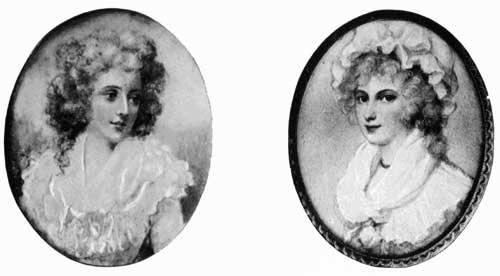
To be a successful collector of miniatures demands that one should be conversant with their market value, which, in its turn, presupposes some knowledge of the various painters and the characteristics of their work. Here again, I make so bold as to assert, there is no royal road. Knowledge of this sort, like most other knowledge worth possessing, has to be acquired by experience, by patience, and by degrees. The various handbooks which have appeared in such plenty of late years professing to teach "How to Identify this" and "How to Collect that" are, no doubt, valuable in their way, but, in my opinion, are apt to lead the inexperienced collector to believe that the discrimination and the judgment essential to safety are more easily acquired than is likely to be the case in so difficult a pursuit.
And it is difficult, because, as no doubt the reader will often have observed for himself, it is so very frequently the case that miniatures do not bear the names of either the person whom they are intended to represent, or of the artist who drew the likeness. So that the collector who would judge of some little head, it may be, is thrown back upon the necessity of having an intimate knowledge of the technical characteristics and qualities of the work before him, which is often the sole test that he can apply and the trifling clue he has to follow. In the case of old[Pg 26] silver there are, at any rate, the stamps to guide the connoisseur, to say nothing of other differences which I need not stop to point out. Most old china, too, is marked.
Again, as with china, and also with silver, there is the forger to beware of, and he constitutes a very real danger, even to collectors of experience, because the forgery of miniatures is brought in these days almost to the level of a fine art, and the ingenuity employed to deceive is indeed remarkable. Take by way of illustration the practice of painting miniatures upon old playing-cards—or what appear to be old playing-cards, for I am told that such things as the latter are expressly fabricated. In the days of the Stuarts miniatures were painted upon pieces of playing-cards, and when framed they were often backed up by one or two other pieces fitted in behind them. These latter pieces afford valuable opportunity for the forger's exertions. Old papier-mâché frames, from which some silhouette or comparatively worthless portrait has been taken, are employed to mislead the unwary. A copy, painted only the week before, is put into some old frame of the eighteenth century, and although costing but a few shillings (and dear at that), is offered at as many guineas to the confiding collector, who, if he falls into the trap, thinks he has got a bargain, as no doubt he would have if—if only the prize were an original, and what it professed to be.
Then the manufacture of copies of well-known examples in public collections is carried on unblushingly and upon a wholesale scale. I have[Pg 27] had large leather cases of such things, containing tray after tray of them, offered me repeatedly, and "upon highly advantageous terms." These are the work of continental copyists, German and French. In Paris they may be found by the gross in the shops of the Rue de Rivoli and in the purlieus of the Palais Royal. And let not the collector make light of this persistent fabrication, because, remember, they are bought by somebody. The distribution of them is going on, as Americans say, "all the time." They become dispersed and crop up again under all sorts of circumstances, from all kinds of sources; they have endless fictitious origins given to them. Generally you are told that they have been in the possessor's family for untold generations, and that the grandfather of the would-be vendor refused a fabulous sum for them.
Perhaps the best advice that I, as one of some experience in such matters, can give, is to be summed up in the word "caution." I say, then, use caution, and always caution, and once more caution.
There remains the alternative of acquiring miniatures by private treaty, often a somewhat delicate matter.
It would not be difficult to write an essay on the Ethics of Collecting, but it might be hard to discriminate with nicety between the use the collector is justified in making of his superior knowledge, to the detriment of the possessor, because we must not forget that when a bargain is "picked up," the owner does not benefit much. It is of the essence of "a bargain" that the coveted object—whether it be old china, old[Pg 28] furniture, jewels, or what not—shall be acquired below its customary, real, and interchangeable value. Well, that clearly is a transaction in which both parties cannot reap the advantage, and the gain of the one is measured exactly by the loss of the other. The tactics of the buyer are well understood in the East, where they are universally practised to-day, as they have been for untold centuries. Do we not read in Proverbs, "The buyer saith it is naught, it is naught, and when he goeth his way he rejoiceth"?
But enough on a matter which, after all, must be left to the individual conscience, always supposing a "collector" has one.
Uncertainty and confusion often arise in the mind of purchasers owing to miniature painters of widely different abilities bearing similar names, and sometimes owning the same initials. It is important, therefore, to be able to discriminate in such cases. Thus we shall find three "Arlauds" and an "Artaud," though I suspect the last named is a misprint. It occurs on a miniature shown at Kensington in 1865.
Amongst the early men there represented were two Betts, or Bettes, Thomas and John, probably brothers, though their relationship is really uncertain.
One frequently hears a work described as an enamel by H. Bone. There
were two—Henry, the father, a Royal Academician, and Henry Pierce
Bone, his son. There were also two grandsons of Henry Bone, viz., W.
and C. R., who practised between 1826 and 1851. The latter of these
contributed no less than sixty-seven miniatures to the[Pg 29]
[Pg 30]
[Pg 31] Royal
Academy. In 1801 there was also an enamel shown at the Academy by P. J.
Bone.
A JACOBITE BADGE.

| LOUISA OF STOLBERG. (A. Lang, Esq.) |
MR. BARBOR AND THE BARBOR JEWEL. (Victoria and Albert Museum) |
CHARLES I. IN HIS OWN HAIR. (Shelley family.) |
|---|
A. E. Chalon, R.A., was a miniature painter; he was brother to John James Chalon, R.A. Miss M. A. Chalon, the miniaturist, was a daughter of Henry Bernard Chalon, and no relation to the above-named Academicians.
Lawrence Crosse must be distinguished from Richard Crosse, whom he preceded by many years.
As we all know, many good miniatures were painted by Maria, wife of Richard Cosway.
There were two Collins, both admirable miniaturists, but no relation to each other, viz., Samuel, master of Ozias Humphrey, R.A., and Richard Collins, pupil of Jeremiah Meyer, R.A.
Samuel Cooper had an elder and less accomplished brother, Alexander.
Alexander Day must not be confounded with Thomas Day, nor with Edward Dayes, whose wife was also a miniature painter.
William Derby had a son Alfred T. Derby, a miniature painter like his father.
Then we must distinguish between John Dixon, the pupil of Lely, who was made "Keeper of the King's picture closet" by William III.; John Dixon, the mezzotint engraver, and N. Dixon.
The last named was an excellent miniature painter who is well represented in the Buccleuch Collection, although unmentioned in Redgrave's "Dictionary." There were eleven works by him shown at the Winter Exhibition of the Royal Academy in 1879[Pg 32] portraits of the period of the Restoration and somewhat later. In the catalogue of this exhibition Dixon is called Nathaniel; Mr. Goulding, the Duke of Portland's librarian, informs me there is evidence at Welbeck that this artist's Christian name was Nicholas.
There were two Englehearts, viz., George and his less talented nephew, J. C. D.
William Essex had a son William B. Essex, also an enameller.
I find two Ferriers, F. and L., probably father and son, and three Goupeys, Louis, also the brothers Joseph and Bernard.
Mrs. Mary Green was no relation to her contemporary, Robert Green, also a miniaturist.
Richard Gibson, the dwarf, had a daughter, Susan Penelope, and a nephew William, who both followed his profession.
Charles Hayter was eclipsed as a miniature painter by his son, Sir George.
There was a Moses Haughton, or Houghton, an enameller, who had a nephew, also named Moses, a miniaturist.
D. Heins and John Heins, his son, both painted miniatures at Norwich.
Nicholas and Lawrence Hilliard, father and son, are probably often confused.
There are said to be two Hoskins, both John, also father and son.
Two out of the three Hones were miniaturists, viz., Nathaniel, R.A., and his grandson, Horace Hone, A.R.A.
Thomas Hopkins was an enameller, and William Hopkins a miniature painter.
There were several artists of the name of Lens, viz., Bernard Lens, enameller, who had a son Bernard, an engraver, and a grandson (also Bernard), enamel painter to George II.; whilst Andrew Benjamin Lens and Peter Paul Lens, each miniature painters, are assumed to have been sons of the last-named Bernard.
G. M. Moser, R.A., had a nephew an enameller, named Joseph Moser. His daughter Mary was celebrated as a flower painter, but I do not find that she painted miniatures.
The short-lived Richard Newton should be distinguished from Sir William John Newton.
Daniel and John O'Keefe were brothers, and both miniaturists.
Isaac and Peter Oliver were father and son.
Of the two Plimers, Andrew and Nathaniel, brothers, the latter was the inferior artist.
Alexander Pope, the poet, was an industrious amateur artist; but there was another Alexander Pope, an Irish miniature painter, who exhibited at the Royal Academy from 1787 to 1821, and who was also an actor; he played at Covent Garden in 1783.
Andrew Robertson, the well-known Scottish miniature painter, had two brothers, of inferior artistic ability to himself; they both had the same initial, namely A, one being Archibald, the other Alexander. There was a Mrs. A. Robertson who also painted miniatures; she was a Miss Saunders, niece of George[Pg 34] Saunders the miniature painter. She worked in this country in the early part of the nineteenth century; going to St. Petersburg in 1847, she was elected a member of the Russian Imperial Academy. Two other Robertsons, the brothers Walter and Charles, practised in Dublin at the end of the eighteenth century, the latter excelling in female portraits.
The Petitots, father and son, were both named John.
One of the most familiar names amongst British miniature painters is that of Ross, and Sir William Charles Ross may be said to have been the last of the old school. His father (H. Ross) and mother both painted miniatures. Then there was also an H. Ross, jun., who exhibited at the Academy from 1815 to 1845; a Miss Magdalene Ross, who became Mrs. Edwin Dalton, and exhibited for over twenty years, and finally a Miss Maria Ross.
There were two Sadlers, Thomas of the seventeenth century, and William Sadler, who flourished in the eighteenth century.
I shall mention only two Smiths, both sons of Smith of Derby, viz., Thomas Correggio, the elder and John Raphael Smith.
Two William Sherlocks exhibited miniatures at the Royal Academy in 1803.
Joseph and William Singleton were contemporary exhibitors during the last century.
Of the three Saunders, George L. is the most distinguished; the other two, Joseph and R., were father and son.
Finally, there were three Smarts known as miniaturists, viz., Samuel Paul and the two John Smarts,[Pg 35] father and son, besides Anthony Smart and his two daughters.
I shall have something more to say later in this volume about several of the artists whom I have just mentioned, but here I may refer to a miniature painter who may well be placed in a class by herself, for she painted without hands or feet. This lady was a Mrs. Wright, née Sarah Biffin; nothing daunted by her apparently overwhelming physical disabilities, she learnt drawing, and in 1821 was awarded a medal by the Society of Arts.
I am not aware of other miniature painters handicapped as Miss Biffin must have been. But I know of several other artists who have worked without hands, e.g., C. F. Felu, a Belgian painter, who was a familiar figure in the Antwerp Gallery, where he painted for many years, and copied hundreds of the masterpieces therein. He held his palette with his left great toe placed through the orifice in which it is usual to put the thumb, and used the brush with his other foot with astonishing freedom and precision. I remember to have seen him fasten the small metal hooks of his colour box with the utmost ease and celerity. Then there was W. Carter, who, having neither hands nor feet, drew exquisitely with his mouth; and of late years Mr. Bartram Hiles, deprived of his arms by a tramcar accident, has shown what a noble enthusiasm to practise as an artist can enable a man to do.
ON THE CARE OF MINIATURES.
"First catch your hare," said Mrs. Glass in her[Pg 36] immortal cookery-book. And now, the reader having collected miniatures, or being their fortunate possessor by inheritance or otherwise, it is not unimportant to know how to take proper care of them. These delicate works of art are always subject to the attacks of two enemies, and they are insidious enemies, although of widely different natures. The one is sunlight, and the other is damp, which brings mildew and disfigurement in its train.
It is really melancholy to see, as one so often does, the terrible destruction which has been wrought by these two agencies, a destruction the nature and extent of which are, perhaps, only fully realised when one is fortunate enough to come across a work by a fine miniature painter in anything like its pristine condition. I am talking of old miniatures, of course, and have in my mind as I write a portrait, by one of the Olivers, I think, of Henry, Prince of Wales, that I saw in one of those interesting historical exhibitions at the New Gallery; the Stuart it must have been. This miniature was surrounded by many others, ostensibly by the same artists, and by examples of contemporary painters. It doubtless had been kept covered up during the many years it had been painted, and thus had a freshness and vigour which was absolutely startling in comparison with the faded, ghostlike specimens to be seen around. Indeed, it is only when we see a good miniature in anything like its original condition that we can grasp and fully appreciate the strength and beauty of the earlier masters, and admit, without any doubt or qualification, their claim to our admiration.
R. COSWAY, R.A.
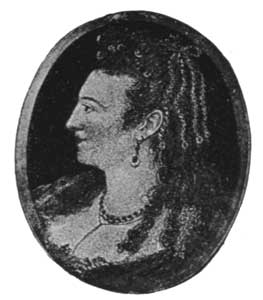
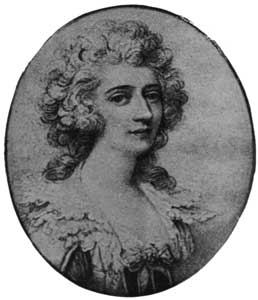
Take another painter, Nicholas Hilliard. A most prolific artist he would seem to be, judging from the number of examples by him that I have met with; speaking generally, one may say that all his work is marked by flatness in the flesh-painting. This artist was appointed painter of miniatures to Queen Elizabeth, and we are told that he was instructed to paint her royal features without any shadows. My point is that nearly all his work is marked more or less by the same peculiarity. Now this may be the result of a fashion set by the Virgin Queen, and, as imitation is the sincerest form of flattery (and she was very fond of flattery), that may in part account for the frequently ghostlike effect of the faces in Hilliard's work; but my own opinion is that in nearly all of them the carnations have flown, as artists say.
That constant source of mischief—exposure to light—is always to be guarded against. Owners are, it must be said, very careless in such matters. I have seen in the morning-rooms of great houses most valuable miniatures hung on the shutters, or stuck about on a screen, placed perhaps in the embrasure of a window. No doubt the owners like to be surrounded by such things, but they should at least have some consideration for posterity. In such a room as I have spoken of you may perhaps see a case of miniatures hung over the mantelpiece, with a hot chimney behind them. Within my own experience I have known most disastrous results, from that cause alone, in the case of historical miniatures of great value, belonging to a noble owner who shall be nameless.
Turning now to the other great disfigurement which so often besets miniatures—the ravages made by mildew. This, in some instances, can be traced to the fact of cases containing miniatures being hung against a damp wall. Probably the simple expedient of a piece of cork, fastened at each corner on the back of the case, would have proved a safeguard. This would prevent contact with the wall, and allow of a current of air passing up behind. Although the fungus which results from damp is terribly disfiguring, it dies off in time, leaving a yellow stain. This can be removed by a skilful hand and careful treatment, and, in so far, is a less-to-be-dreaded enemy than light, or I should say sunlight. This latter, of course, can be easily guarded against by another simple expedient, which is, either to keep your miniatures locked up in drawers, or, if you must have them on your walls, have a small rod fastened to the top of your case, with a dark curtain on it which you can draw back at pleasure.
But I have heard some collectors say, "My miniatures have never been put against damp walls; they have been kept in cases always, yet they have mildew on them." Well, it must be admitted that this unsightly, objectionable fungus does appear unexpectedly and in the best regulated households. No doubt the germs were there, shut into the case; in due course they have been developed, bringing perplexity and dismay with them.
Miniatures of a comparatively recent type, that is to say upon ivory (as well-informed collectors know,[Pg 41] it was not until the early Georgian period that this substance was used to paint on)—miniatures on ivory, I repeat, are subject to curl, warp, and crack; changes of temperature easily affect the thin slices which the artist uses; when one of these splits, as it often does, the only thing to be done is carefully to lay the pieces down on cardboard, joining the edges as skilfully as may be, a task only to be performed satisfactorily by an expert.
The large miniatures by Sir William Ross, Sir W. J. Newton, and R. Thorburn are particularly liable to this mischief, the reason for which is to be found in the practice of these artists in employing several pieces of ivory for one picture.
A large slab, the largest procurable, taken from the circumference of a tusk, rolled flat under great pressure, was laid down by gutta-percha upon a well-seasoned mahogany panel; round this on all sides were laid other strips of ivory, the whole forming a large surface upon which it was possible to paint an elaborate composition, proportionately expensive, (for that, I take it, was the principal incentive to the artist). Such pictures as these represented great labour—for you cannot "wash in colour" on ivory—and being highly finished all over, warranted the artists in asking high prices, and they obtained them.
Other dangers there are, arising from the cupidity excited by the value of these little works, so easily removed, and often in valuable settings. But risks from those who break through and steal are common[Pg 42] to all valuables, and owners of property are alive to them. Yet these few words of reminder and caution against pilferers will, I trust, not be deemed out of place.
THE ORIGIN OF THE ART
When we come to get a little familiar with old miniatures, to have learned their language, as it were, we shall find that, if they are authentic portraits, they possess, in addition to their high personal interest, other and distinct values as illustrations of art, of history, and of costume. They are, in fact, when genuine and contemporary, precious documents, some of which go back several centuries, and are of great service in reading the history of the past. They have, like other works of art, their definite origins; and so, too, they have their own separate and distinct characteristics, and it is upon these and such-like aspects of the study that I propose now to say a few words.
As in the case of so many arts and religions, it is to the Orient, that cradle of them all, as far as our present knowledge allows us to know, that we must turn our eyes, if we wish to find the earliest source of the practice. There is no doubt whatever that the Egyptian papyri were rubricated, and we may safely conclude that the use of gold, silver, and[Pg 46] colour in the ornamentation of MSS. found its way from the valley of the Nile into Greece. Thence Greek artists took it to Rome, and from Rome the use spread throughout Europe.
Many choice historical miniatures have long pedigrees, and it may be worth while to see how far back we can definitely trace the practice of the fascinating art which gave them birth.
On this point I may quote the opinion of the late Keeper of the Department of Engravings in the Bibliothèque Nationale, Paris, M. Henri Bouchot. He had made, as is well known, a close and profound study of the art of the French "Primitifs," and therefore the conclusions that he arrived at may, I think, be very safely taken on this subject.
Writing many years ago in the Gazette des Beaux Arts, he said the origin of miniature painting "is lost in the obscurity of the ninth century." He contended that the heads which are to be found in MSS. of that period, the work of monkish artists, are intended to represent some well-known prince, emperor, or pope of that time. He suggested that the painter, shut up in his monastery, could only paint such a portrait from hearsay, and from information which he gathered from brethren of his Order, or from neighbouring great nobles with whom he came in contact, and who, in their turn, had seen the original of such a portrait or portraits.
If this distinguished French critic be right, it follows that at that
remote date such representations could have been little less than
pure inventions; and such, indeed, he would have us suppose to be[Pg 47]
[Pg 48]
[Pg 49]
the case for several centuries more. But at the commencement of the
fourteenth century it would seem that the illuminators set themselves
to render the real portraiture of individuals; and here, from our point
of view, the especial interest of the subject may be said to begin.

The art, then, may be traced to the illuminated devotional manuscripts, Books of the Hours, or Lives of the Saints, enshrining minute, exquisite, and loving labour. Who these early artists of the Scriptorium were we shall never know; but the manuscripts which have escaped the wreck of Time have come down to us, silent yet eloquent testimonies of their authors' patience and skill. It is in connection with their beautiful work that the word "miniature" came into existence, the term being derived from the Latin minium, or red lead, that being the pigment in which the capital letters in the manuscripts were drawn. The art of medieval illumination was expressed by the Latin verb miniare; the word thus will be seen to be closely allied to our term "rubric." The persons employed in this work seem to have been classified as Miniatori, Miniatori Caligrifi, or Pulchri Scriptores. The first named painted scenes from Scripture stories, also the exquisite borders and arabesques. To the others would be entrusted the writing of the body of the book.
But whilst we may thus go back to medieval times for the origin of the name, it can hardly be said to have been in use with us before the beginning of the eighteenth century. Thus Samuel Pepys never uses the word, while Horace Walpole constantly does so.[Pg 50] An entry in the Diary of the former, made in 1668, speaks of his wife's picture which Samuel Cooper painted for him; and earlier—that is, in 1662—John Evelyn relates how he was called in to the closet of the King (Charles II.), and "saw Mr. Cooper, the rare limner, crayoning of the King's face and head to make the stamps by for the new milled money now contriving."
The reader will observe that no mention of the word "miniature" is made by either writer. And there is something arbitrary in the use of the word now and always, for it is restricted to portraits in water-colours or gouache, whether on vellum, paper, or ivory. Yet figures when painted in oil, even though as small as Gerard Dow's, or not more than two or three inches high, are called small pictures. When the most important exhibition of miniatures ever held in this country—namely, the collection which was brought together at South Kensington, in 1865—was being arranged, its organisers were confronted with the difficulty attaching to a definition of the term; and it may be worth while to give the conclusion they arrived at.
In reply to the question, What constitutes a miniature portrait? they
remark that miniatures may be drawn on any material, painted in any
medium, and in every style of art. Commencing with the head only, to
which the skill of some of our early "face painters" was limited, we
find their works followed by miniature half-lengths, whole-lengths,
and groups; but from these no technical, accepted definition of the
term "miniature" can be[Pg 51]
[Pg 52]
[Pg 53] derived. Without, therefore, attempting to
lay down a rule, it was deemed best in the interests of the exhibition
to accept all such works as were drawn to a small scale and were, in
manner, of a miniature character, except paintings on porcelain.

(Duke of Rutland.)
Returning to the origin of the term, we see that it was the ornamentation of the office of the Mass in use in the Christian Church which really gave rise to it. Under the protection of Constantine, Christian art may be said to have come into existence in the fourth century at Byzantium. Work of this period has a very strongly marked and sufficiently familiar character of its own. The Canterbury Gospels in the British Museum are ascribed to the eighth century, and the Louvre possesses a noble work in the shape of the Prayer Book of Charlemagne, which belongs to the ninth century. It is to Charlemagne that we owe the Carlovingian school, and when the tomb of the great Emperor, at Aix-la-Chapelle, was opened, a copy of the Gospels was found upon his knees.
Another very interesting school is the Hibernian, sometimes called Anglo-Celtic. A characteristic feature of this work is the inferiority of the figure-drawing, but the elaborate and beautiful interlacing of the geometrical patterns is no less remarkable. Perhaps the best-known example of this school is the Book of Kells, preserved in Trinity College, Dublin. Brought from the abbey church of Kells in 1621 by Archbishop Ussher, it was confiscated during the Commonwealth, but restored to Trinity College by Charles II. after the Restoration.
Still dealing with the early work of this nature, I may briefly refer to what is known as Opus Anglicum, of which the Benedictional of St. Ethelwald, belonging to the Duke of Devonshire, is the most celebrated example. This belongs to the latter part of the tenth century, as we know by a Dedication it contains, showing that it was made for Ethelwald, Bishop of Winchester from 963 to 984 A.D. The Bishop "commanded a certain monk subject to him (the scribe Godeman) to write the present book, and ordered also to be made in it certain arches, elegantly decorated and filled up with various ornamental pictures expressed in divers beautiful colours and gold."
And so we might go on to consider the various Continental schools—the Flemish and German, the French and Italian—but the subject is too large to be dealt with here. Those of my readers who care to pursue a fascinating study will find ample illustration in the freely displayed treasures of the British Museum, where fine examples of every school may be seen. At Hertford House the Wallace Collection, amongst its multifarious treasures, contains some initial letters which have been cut out of MSS., no doubt on account of their beauty. They are obviously portraiture. The example here shown is Italian work, and is taken from a fifteenth-century missal.
Whilst I am unable to enter upon details of the earliest schools, I may
observe that the material upon which work of this nature was done has
a practical bearing upon our subject. It was upon vellum, sometimes
stained purple, upon which the letters were written in gold or silver.
There is a[Pg 55]
[Pg 56]
[Pg 57] magnificent example of this work, known as the Codex
Purpureo-Argenteus, preserved at Upsala, in Sweden. This has been dated
as early as A.D. 360. And I remember the pride with which the
monks in the remote monastery on the Isle of Patmos showed me five
pages of one of the Gospels, also on vellum, stained purple, which
had been preserved in their library with religious care for unknown
centuries. The surface of the vellum, naturally greasy, would have to
be carefully prepared for the art of the "steyners," as they came to be
called. When so prepared it was called Pecorella.

(Duke of Rutland.)
To vellum succeeded cardboard. Nicholas Hilliard and the great English miniature painter Samuel Cooper commonly used old playing cards; and a very good substance for the purpose they were, not being so liable to cockle as vellum, nor to crack, curl, and split as ivory under certain conditions is liable to do. It has already been noted that ivory did not come into use for such purposes until about the end of the seventeenth or beginning of the eighteenth century.
This is a very important point in detecting forgeries, and, indeed, in determining the age of any work about which doubt may exist.
The way to paint miniatures is no part of the subject of this book; nevertheless, by way of giving a practical value to its pages, I may state the method employed by a miniature painter with whom I was well acquainted and whose work I greatly admired, and this seems a convenient place to do so. The artist to whom I refer was the late Robert Henderson,[Pg 58] a self-taught man, born in Dumfries. He lived to the close of the nineteenth century, but the manner of his execution was essentially that of the mid-Victorian painters, and whilst it had not quite the brilliancy of the flesh tones of Sir William Ross, for example, whose work he greatly admired, it was always conscientious, sound, and excellent.
Without being laboured, it was always marked by a careful finish. He was a frequent exhibitor in the Royal Academy, but was indifferent to the distinction, having constant employment from Messrs. Dickinson for a long series of years, during which he painted a large number of the British aristocracy. I am able to subjoin some account of his method of working and choice of colours from particulars he gave me himself, and as they may be useful to others, I extract them pretty much in his own words:—
"Having chosen a piece of ivory of good colour and even texture, prepare its surface by rubbing it with the finest glass paper. The first step is to draw the likeness with a blacklead pencil on paper, not on the ivory itself, because, if any corrections are needed, they cannot be made without smudging and making the ivory dirty, a thing to be studiously avoided. This drawing should then be carefully transferred to the surface of the ivory by means of a piece of tracing paper.
"Now take a nice flat sable brush, and wash the face all over with a
flesh colour, then indicate the features, eyes, and so forth, touching
in the nostrils and mouth. Next prepare a grey tint, made of[Pg 59]
[Pg 60]
[Pg 61] cobalt
or ultramarine with a tinge of red to give it a lilac tint. Wash this
all round the outer part of the face—not touching the centre of the
face. Then with a little blue mixed with the flesh colour, work up the
face until you get somewhat the effect of an engraving. This being
done, you may proceed to put in the deepest shadows, e.g., under the
nose and eyebrows, with a warm colour composed of a light red with a
little blue in it. Having got your deep shadows in, use the grey again,
this time with a little more flesh colour, and blend the whole together.

(Earl Spencer.)
"For a flesh colour I used to employ rose madder and cadmium yellow in about equal proportions; for men's complexions light red alone makes a good flesh wash. There is a new red brought out which is warranted to be thoroughly permanent; it is a useful colour, called mazarine, and comes in for everything. There have been suspicions cast upon rose madder, but I have found it stand well enough in ordinary miniature painting. Carmine was used by Sir William Ross and Thorburn, certainly, but that was apt to go dark in colour. The madders are very delicate colours.
"Eyes—for hazel use burnt sienna and French ultramarine, real ultramarine being very expensive. For ordinary dark brown eyes nothing is better than sepia; for blue eyes it depends on the shade—if bright strong blue, cobalt is the best colour; for grey eyes use cobalt and a little light red—the latter very sparingly. Cat's eyes (by which I mean greenish) require peculiar colouring, which must depend on circumstances and be treated accordingly.
"Hair is a troublesome thing to get right. For golden hair I use a very thin wash of burnt sienna; for the half tones a purple tint—blue and red mixed in equal parts, and for the deep shadows burnt sienna. For ordinary dark hair nothing is better than sepia, and for the high lights a purple grey—blue and a touch of red—that gives a glossiness to the hair. For grey hair simply mix sepia and ultramarine; for red hair burnt sienna is used principally, shaded with sepia in the dark parts.
"Backgrounds—for the ordinary, deep, plain, brownish, the best thing is a wash of burnt sienna and ultramarine, in proportions as required to obtain warmer or cooler effects. For a cloudy sky or background use cobalt for the blue and light red mixed with cobalt for the deeper shadows; where the shadows come near the figure, use brown madder and cobalt; touch the edges of the clouds with light red alone, to give a warm, cloudy effect.
"Draperies—for a man's black coat use blue-black and cobalt, mixed in about equal proportions, and a little madder lake; put in the shadows with sepia. For a lady's black silk use much the same, only less blue-black and more cobalt, with a little light red in it; use sepia again for the shadows, as it gives a warmer tone than black itself. If lights are required on a black coat when it is too black, body colour must be used—white, with a little light red mixed with it."
CONCERNING ENAMELS AND ENAMEL PAINTERS
The subject of enamel has a close relation to that of these pages, although its uses, as need hardly be said, far transcend the limits of portraiture. Every substance, whether earthenware, stone, or metal, to which a vitreous substance can be made to adhere by heat may be enamelled, but this term is usually restricted to metalwork ornamented by a vitreous glaze. As in the case of illuminated manuscripts, we find the earliest instances of the use of enamel in Egypt, and Dr. Birch is our authority for believing that there was a method of inlaying glass, jasper, and lapis lazuli, which resembled enamel in effect, employed as far back as the Fourth Egyptian Dynasty—that is to say, some four thousand years before the Christian era. The Chinese have had it in use for unknown centuries, and it was applied by the Etruscans and Greeks to enrich their jewellery. It has been found employed for horse trappings and for human ornaments, such as brooches, bracelets, and rings, both in this country and in Ireland, under circumstances which lead us to assign it to pre-Roman days.
But it is with the seat of Roman power on the Bosphorus, namely, Byzantium, in the early Christian centuries, that antique enamels seem most closely associated; and the museums of Europe contain great numbers of marvellous works of this description originating from that source. What has come down to us is for the most part intended for ecclesiastical use; reliquaries, diptychs, triptychs, the covers of missals, chalices, crosses, and objects of a like nature abound. On many of these there are what may, in a sense, be termed portraits of saints and ecclesiastical dignitaries; but it is obvious that no attempt at likeness, as we moderns understand it, can have been made in this work of the fourth to the eleventh centuries. This Byzantine style and influence, which have left such a deep mark in art, may be said to survive to this day in the ritual of the Greek Church; but that is another story. I may remark that the Byzantine work is for the most part what is called cloisonné; this term, and one of a somewhat similar sound, namely champlevé, is constantly used in descriptions of old enamel, and it may be well, therefore, to define what is meant by each respectively.
The former has been described by M. Lebarte as being made in the
following manner: "The plate of metal intended as a foundation was
first provided with a little rim to retain the enamel. Slender strips
of gold of the same depth as the rim were then bent in short lengths
and fashioned to form the outline of the pattern. These short bits
were then fixed upright upon the plate. The metal outline being thus
arranged, the intervening spaces were filled with the[Pg 67]
[Pg 68]
[Pg 69] different
enamels, reduced to a fine powder and moistened into a paste. The piece
was then placed in the furnace, and when the fusion was complete, was
withdrawn, with certain precautions that the cooling might be effected
gradually. The enamel, when thoroughly cold, was ground and polished.
It is easy to comprehend that the old artists must have used very pure
gold and extremely fusible enamels, in order that the plate might not
be injured from the action of the fire or the thin strips of metal be
melted by the heat which fused the paste."
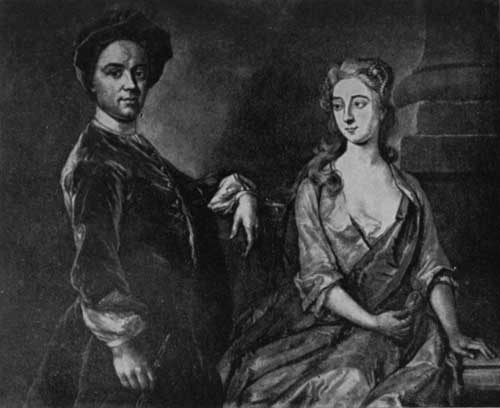
The method of preparing champlevé is as follows: "A slender line of metal shows on the surface the principal outlines of the design; but the outline, instead of being arranged in detached pieces, is formed out of a portion of the plate itself. The artist, having polished a piece of metal about a quarter of an inch thick, generally copper, traced upon it the outlines of his subject; then, with proper tools he hollowed out all the spaces to be filled with the different enamels, leaving slender lines level with the original surface to keep them distinct. The vitreous matter, either dry or reduced to a paste, was then introduced into the cavities, and fusion was effected by the same process as in the cloisonné enamels. After the piece had become cold it was polished, and the exposed lines of copper having been gilded, it was returned to the fire. The gilding only required a moderate temperature, not high enough to injure the incrustations of enamel."
Byzantium, as I have said, was a great seat of the cloisonné process, and the celebrated "Pala d'oro," a[Pg 70] magnificent altar front now preserved at St. Mark's, Venice, was made at Constantinople about the year 1100. In champlevé enamelling, although the art was practised in the Rhenish provinces of Germany, it was at Limoges, in France, that the finest work was done, and in the thirteenth century opus Lemoviticum was in high favour. A century later, when the city was sacked by the troops of Edward the Black Prince, the manufacture received a great check. But with the Renaissance came a renewed demand for enamels, which were used in combination with articles of domestic utility, and in the reign of Francis the First the enamellers of Limoges, among whom Suzanne de Court, Laudin, Jehan Courtois, and Pierre Reymond are well known, produced decorative works of the most costly and beautiful nature. Whole families devoted themselves to the art, and their traditions were handed on from generation to generation. But perhaps the most famous name in connection with this French work is that of Léonard Limousin, and three others, namely, Jean, Joseph, and François, of the same family.
Léonard Limousin, who was appointed painter to the king, François I., has expressed in numerous pieces which have come from his hand the very spirit of the Renaissance, partly devotional and still more strongly classical and sensuous in feeling and treatment. Old Limoges enamel, as we all know, is extremely valuable; single pieces from the Hamilton Palace Collection were sold at Christie's in the celebrated sale for something like £2,000 apiece.
The subject is far too wide to be treated exhaus[Pg 71]
[Pg 72]
[Pg 73]tively in this book,
but at the Victoria and Albert Museum examples will be found of the
various styles, and the varied uses to which they were applied. The
British Museum of late years has been enriched by what is known as
the Waddesdon Collection, bequeathed by the late Baron Ferdinand de
Rothschild; and in Paris the Cluny Museum, and especially the Salle
d'Apollon in the Louvre, are extremely rich in works of this nature.
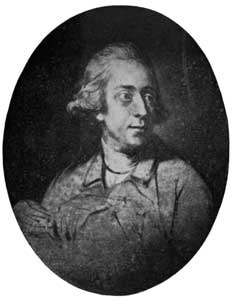
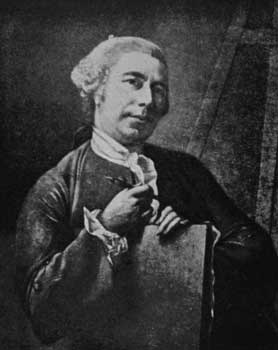
All these collections contain portraiture in enamel, but one would hesitate to say that the portrait is the primary object in the production of these works, in which undoubtedly a decorative feeling largely predominates.
Although in the general treatment they were feeling their way to a larger palette, no attempt seems to have been made by these earlier artists to get anything approaching reality in the flesh tones; they were left a uniform cold white. Until one has got a little used to this absence of colour, and the metallic hardness which the use of oxide of tin in the paste of the enamel gave rise to, and until one recognises that it is the conventional mode of treating them, the pallor of the faces, contrasted, as it generally is, with a deep blue, or sometimes shining black background, is somewhat repellent.
Take, for example, the large medallion of the Cardinal de Lorraine, Charles de Guise, uncle to Mary Stuart, a piece which cost the nation £2,000, and may be seen at Kensington. It represents the Cardinal in scarlet robes and a biretta. The head, fully seven inches long, is painted upon a[Pg 74] deep blue ground; his hair is black, the eyes are blue, and the effect of the whole is, it must be admitted, extremely hard, in spite of the distinguished name its author, Léonard Limousin, bears in the ranks of medieval enamellers. The work is as different as possible from the exquisite minuteness which characterises other enamel painters, like Petitot, for instance, to whom we shall come by and by.
The same lack of modelling and of half-tones may be observed in the portraits in the Waddesdon room at the British Museum, to which reference has already been made. See, for example, the large panel, 9 inches by 12, or thereabouts, of Catherine de Lorraine, Duchess de Montpensier. This lady wears her hair in a golden and jewelled net; her open collar is laced with pearls; this piece is also signed Limousin, and may be regarded as a typical sixteenth-century portrait.
The step forward which was to elevate the art of painting in enamel to the highest possible pitch of technical execution, of artistic treatment and minute finish, was taken by Jean Petitot, a Genevan, born in 1609. Apart from the wonderful skill of the artist, who, in respect of technique, must be considered absolutely unique, the means by which such beautiful, delicate, and minute effects could be produced in so difficult an art as that of fusing colours would be in itself an interesting study.
Probably it is to Jean Toutin, an obscure French goldsmith, who lived at Châteaudun, and, assisted by Isaac Gribelin, a painter in pastels, and doubtless by[Pg 75] his son, Henri Toutin, of Blois, produced, about 1632, a variety of colours which he found could be laid upon a thin ground of white enamel, and passed through a furnace with scarcely any change of tint, that Petitot owed the richness of his palette. From Toutin, and from Pierre Bordier, another French goldsmith, to whom he was apprenticed, Petitot gained the insight into enamelling which bore such rich fruit when he came to this country in his twenty-eighth year, attracted, there is little doubt, by the reputation then enjoyed by our king, Charles I., as a patron of art.
The English monarch had in his service as physician at that time a certain Sir Turquet de Mayerne, himself a Genevan and a chemist of European celebrity. He and Petitot pursued scientific research into the nature and properties of the metallic oxides with such ardour and success that the miniature painter's palette became greatly enriched, and he was able to express all the nuances of flesh colouring in a way which had never before been approached and, I may add, has never been surpassed.
When one realises the extraordinary minuteness and exquisite finish of a work of Petitot, and the difficulties of the method—by which I mean the risks attending the firing—it is almost incredible that such success could be attained; but probably there were large numbers of failures of which the world knows nothing.
In some of the Limoges work we see attempts at colouring the cheeks; but the result is not satis[Pg 76]factory; whereas in Petitot it leaves absolutely nothing to be desired, and the most minute differences of character find expression in the art of this wonderful man. Take as an example the two portraits of Louis XIV., to be seen in the Jones Collection in the Victoria and Albert Museum, one representing the Grand Monarque when young, the other in more advanced years; or, from the same Collection, take the portraits of Mme. de Montespan and Mlle. de la Vallière; and compare these again with the insipidity and monotony of Lely and Kneller, the two artists most in vogue in this country at that time; here you have upon a small piece of gold, perhaps hardly bigger than a finger-nail, nearly all that may be looked for in a portrait, coupled with a perfection of technical execution to which it is impossible to do justice in words. One comes away from an examination of that admirable collection which the nation owes to the generosity of Mr. John Jones with a paramount feeling of astonishment, wondering how such work was done.
Of course Petitot has had innumerable imitators; and although the
standard of the Collection to which reference has just been made is
very high, there are in it examples which are instructive, and serve to
show how supreme the master was in his own line. A contemporary pupil,
namely Jacques Bordier, was a cousin of the Pierre Bordier, Petitot's
old master and colleague, of whom I have just spoken. According to M.
Reiset this Jacques Bordier also worked in England with Petitot. Like
Petitot,[Pg 77]
[Pg 78]
[Pg 79] he returned to the Continent, and did a great deal of work
in Paris upon watch-cases; the two men married two sisters, Madeleine
and Margaret Cuper, in 1651. Pierre Bordier stopped in this country and
executed an elaborate watch-cover, designed as a memorial of the Battle
of Naseby, presented to General Fairfax, and described in the catalogue
of the sale of Strawberry Hill, where it was sold. It was, doubtless,
the troubles of the Civil War which drove the great enameller back
to France, where he was well received by Louis XIV., and commissions
flowed in upon him until the close of his life; indeed, he is said to
have retired to Vevey to escape the importunity of his patrons; and
there he died, at an advanced age, in the year 1691.
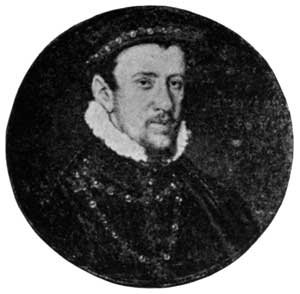
(Duke of Norfolk.)
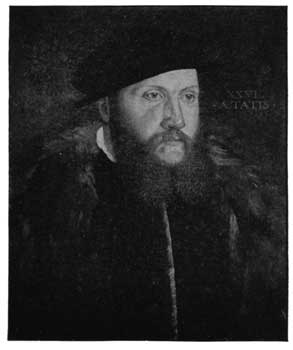
(National Gallery.)
The art of which this incomparable miniaturist was such a great exponent was peculiarly adapted to a form of patronage much in vogue at that time; that is to say, it was employed in the adornment of costly and exquisite snuff-boxes. These boites aux portraits, as they were called, were extensively used for diplomatic purposes, and portraits of the Grand Monarque were ordered by the dozen at a time. The presentation of boxes of such a character with a portrait on, or inside, the lid, with or without a setting of brilliants, as the rank and importance, or otherwise, of the fortunate recipient required, were part of the ceremonial usage and Court etiquette of the day. The Collection left to South Kensington by Mr. Gardiner, the extremely choice examples in the Wallace Collection, and the still larger collection[Pg 80] left by the Lenoirs to the Louvre, show the extravagant pitch to which work of this kind was carried, the diamond settings alone often running to a cost of many thousands of francs. For example, a portrait of Louis XVI., when Dauphin, was presented to Marie Antoinette. The portrait was painted by the most eminent miniature painter of his day, namely Pierre Adolphe Hall; the artist received 2,684 francs, and the cost of the box and brilliants was over 75,000 francs.
Petitot may be studied to full advantage at the Jones Collection, even better than at the Louvre, whilst at Hertford House there are only a couple of examples attributed to him. In private collections there are some notable works which passed from Strawberry Hill into the possession of the late Baroness Burdett Coutts; and the Earl of Dartrey also owns a number. The portrait, shown in this book, of Petitot le Vieux, is from this nobleman's collection, which, by the way, is also rich in examples by the brothers Hurter. These two enamellers came from Schaffhausen, being introduced to the British aristocracy by the Lord Dartrey of that day. Some thirty examples of their work were shown at the Loan Exhibition at South Kensington in 1865 by the then Lord Cremorne. At Althorp is a portrait of the beautiful Duchess of Devonshire by John Henry Hurter; and Lord Dartrey has a portrait of Queen Charlotte painted by J. F. C. Hurter.
HANS HOLBEIN THE YOUNGER.
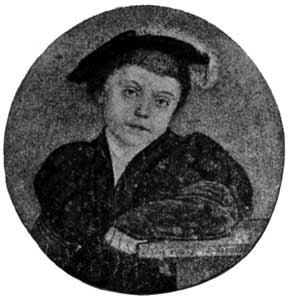 |
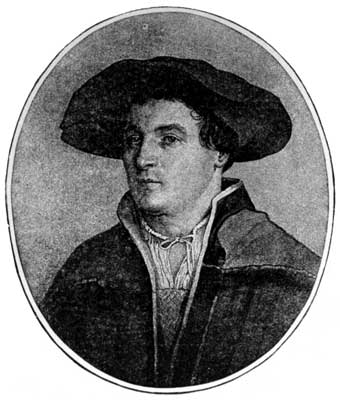 |
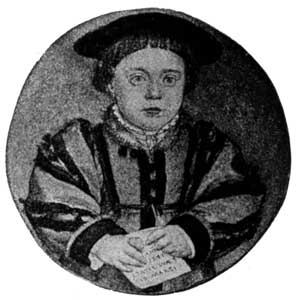 |
| HENRY BRANDON. (H.M. the King.) |
HIMSELF. (From a drawing at Basle.) |
CHARLES BRANDON. (H.M. the King.) |
We now pass on to consider the art of painting portraits in enamel as
practised in this country. The first name of any importance in this
connection is[Pg 81]
[Pg 82]
[Pg 83] that of Charles Boit, a native of Stockholm, but of
French extraction. He was born in 1663, and when he was about twenty
came to this country and worked as a jeweller. Being unable to succeed
in that occupation, he turned drawing-master, and Walpole tells us of
an intrigue which led to his being thrown into prison for two years,
time which he is said to have turned to advantage by practising enamel
painting, though how that could have been done under such circumstances
I do not know. Ultimately he became celebrated for his work, and
obtained high prices for it He attempted pieces on a large scale, the
difficulties of which are enormously enhanced by their size, as is well
known to craftsmen. One was intended for Queen Anne, and the artist is
said to have received a thousand pounds advance on it, but before he
succeeded in firing it some £700 or £800 were spent, which led him into
such difficulties that he escaped to France, where he died, about 1726.
There is a large, though not particularly attractive, example of Boit's to be seen in the Ashmolean Museum at Oxford; but specimens of his art are not very common, and are not nearly so often met with as those by C. F. Zincke, whose spick-and-span style and bright blue draperies are well known; Oxford is rich in them.
This Dresden miniature painter, whose features are familiar to print collectors from the mezzotint of him and his wife by Faber, came to England in 1706 and obtained the patronage of George II., although that uninteresting monarch hated "boetry and bainting." Zincke's work is, indeed, typically[Pg 84] early Georgian, and repeats the insipidities of Kneller on a small scale, with a persistent consistency which is monotonous in the extreme. Horace Walpole had a high opinion of his work; he declared that it surpassed that of Boit and rivalled Petitot, an opinion which few who know the merits of Petitot's exquisite art are likely to endorse.
Failure of eyesight led Zincke to retire in 1746; but he lived some twenty years longer. During the forty years that he practised his art he must have executed an enormous number of portraits, for he was the fashionable artist of his day, and so great was the patronage bestowed upon him that he raised his prices to limit the number of his patrons.
A pupil of Zincke's was William Prewitt, who is not, I think, very well known. There is an example by him to be seen in the Victoria and Albert Museum, a body-colour drawing. The Duke of Buccleuch has a portrait of Horace Walpole when young, also painted by Prewitt.
Another miniaturist who was especially an enameller was Charles Muss, said by some to be an Italian, and by others to have been born at Newcastle-on-Tyne in 1779. He was enamel painter to George III. and George IV.; and devoted himself especially to copying old masters. Examples of his work in this direction will be found in the Plumley Collection in the Victoria and Albert Museum.
HANS HOLBEIN THE YOUNGER.
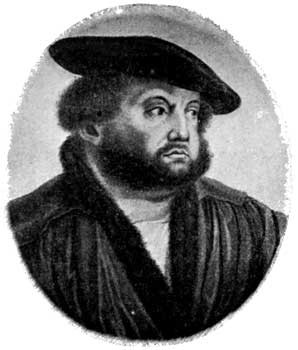
(H.M. the King.)
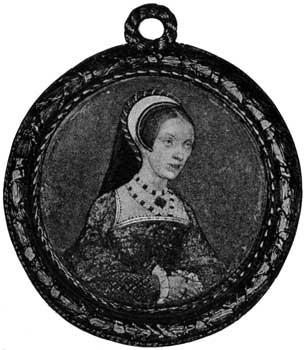
(H.M. the King.)
A much better-known enameller is Nathaniel Hone, an Irishman of a
self-assertive, not to say aggressive, personality, if one may judge
by the tone of his remarks when he quarrelled with the Academy,[Pg 85]
[Pg 86]
[Pg 87] of
which he was a full member, over his picture called "The Conjurer."
This indifferent painting excited an amount of attention of which
it was quite undeserving from the tongue of scandal, which asserted
that Sir Joshua Reynolds and Angelica Kauffmann were satirised in
the composition, and that one of the naked figures dancing in the
background was intended for the fair Academician.
Hone essayed the various branches of art with varying success. There is a characteristic portrait of himself in the Diploma collection of the Royal Academy. He, too, had a share of Royal patronage, and painted many of the notabilities of his day, including the lovely Misses Gunning. He had a son, Horace Hone, who was made an Associate of the Academy, and who also practised as a miniature painter. His work is considered inferior to that of his father.
John Plott, another miniaturist, was also a pupil of the elder Hone, and was born at Winchester, where he studied law. Forsaking that pursuit, he came to London, and was at first a pupil of Richard Wilson R.A.
Two other Academicians associated with this period, and both enamellers of exceptional ability, are George Michael Moser and Jeremiah Meyer. Moser was the son of a sculptor, and was born at St. Galle, in 1704. Upon his arrival in this country he found employment with the Royal Family, and, being a fine medallist, was commissioned to design the King's Great Seal. No doubt he had social gifts, and he certainly enjoyed the respect and friendship[Pg 88] of Sir Joshua Reynolds. He was one of the most active founders of the Royal Academy, and was made its first Keeper.
His only child, Mary Moser, was a flower painter of great reputation in her day. She married a Captain Lloyd, but is reported to have gone about the country in the company of Richard Cosway, who at the beginning of the century was separated from his wife, Maria. This Mary Moser, by the way, was a lady Royal Academician, like the fair Angelica Kauffmann.
Jeremiah Meyer, the other enameller whom I have mentioned, was also a foundation member of the Royal Academy; he was, moreover, a very fine miniature painter. Great refinement of colour, excellent drawing, perfect finish, and, what is perhaps more rare in miniature work, truth to life, distinguish his miniatures. He came to London when he was fourteen, and was a pupil of Zincke for two years. Fifteen years later, when only twenty-nine, he was made enameller to George III. He was a constant exhibitor at the Academy, where he showed some twenty pieces. He was born at Tubingen, in 1735, and died in 1789, some three years before Sir Joshua Reynolds, whose work is said greatly to have influenced his style.
The palette of the enamel painter is a very rich one, but not all the colours to be found amongst the metallic oxides fuse at the same temperature. Hence the artist must be able to judge most accurately the length of time that each will stand the heat without melting too much and running one into the other. Such acquaintance can only be acquired by pains-[Pg 89]taking practice, and it is obvious how greatly the difficulties of portraiture are enhanced under such conditions. It is usual to place these opaque colours upon the enamel ground, on a gold or copper plate, applying the hardest vitrifiable colour first, then the less hard, and so on. It is perhaps not surprising that so delicate a process, liable to be attended by failure at every step, has fallen out of fashion in these days, and as a matter of fact it is now scarcely attempted in this country at all—that is to say, in the way of portraiture.
Formerly, however, it was carried on here with more or less success, and one interesting practice of the art may be named before we leave this part of our subject. I refer to what are known as the Battersea enamels. In the middle of the eighteenth century, under the management of S. J. Jansen, many articles, such as candlesticks, patch-boxes and snuff-boxes, and such like, were produced. These are fairly well drawn and coloured, and consist largely of flowers, birds and fruit, and so forth, generally on a white ground. But beside all these there are a number of contemporary portraits, produced by means of transfers from copper plates. Amongst these are the beautiful Misses Gunning, the Royal Family of the day, Gibbon, and many others. Some may be seen in the Franks Collection at the British Museum, and a more important collection is at the Victoria and Albert, brought together by the late Lady Charlotte Schreiber.
To a somewhat later period than that we have been discussing belongs Henry Bone, R.A., who, like[Pg 90] so many other artists, came from the West of England, having been born at Truro, in 1755. The circumstances of his early life doubtless somewhat affected the direction which his artistic efforts took, he having been apprenticed in a china manufactory at Plymouth. He removed with it to Bristol in 1778, and, coming to London, was employed in painting devices in enamel on trinkets. He first attracted attention in London by an enamel of the "Sleeping Girl," after Sir Joshua Reynolds, which was exhibited at the Royal Academy in 1780. This led to his being appointed enamel painter to Royalty, and George, Prince of Wales, extended his patronage to him. Academical honours followed; he was made an Associate in 1801, and full member ten years later.
Bone stands out as the enameller par excellence of the English
school; and he was astonishingly successful in many large and ambitious
pieces. For example, he was paid two thousand guineas for a plaque
measuring 18 by 15 inches, a copy of Titian's "Bacchus and Ariadne,"
in the National Gallery. He devoted himself especially to copying the
works of the great masters, such as Raphael, Titian, and Murillo. He
also executed a series of 85 copies of portraits of the statesmen and
others who lived in "the spacious days of great Elizabeth." But whilst
a large measure of success may be ungrudgingly accorded him in respect
of these works, the flesh tones in his painting often leave something
to be desired; there is a suggestion of painting on porcelain, and of
the smoothness and want of vitality that characterise that kind of
work, and are so fatal to its artistic complete[Pg 91]
[Pg 92]
[Pg 93]ness. It would be a
little curious to trace this tendency to what may be termed ceramic
smoothness to the early training of Bone as a china-painter. At any
rate, it may be recognised as characteristic of his style.
His son, Henry Pierce Bone, followed his father's footsteps in painting a great number of copies from the old masters. The elder Bone died in 1834, the younger lived some twenty years longer. Besides these two, there was a P. J. Bone, who exhibited an enamel at the Royal Academy in 1801; and there were also two other Bones, whose names appear in the catalogues, namely, W. Bone and C. R. Bone. They were the grandsons of Henry, and exhibited up to 1851, the latter alone contributing 67 miniatures to the Academy.
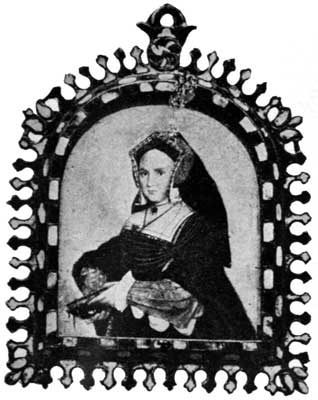
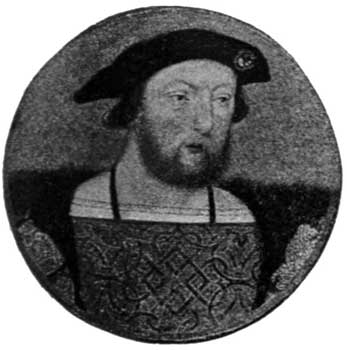
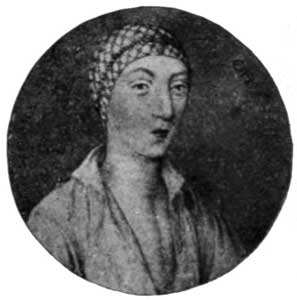
The last enamellers that I would mention are the Essexes, William and William B. The former was born in 1784, and died at Brighton, in 1869. In his long life he exhibited a large number of works at the Royal Academy, mostly portraits, H.M. the late Queen Victoria giving him much employment, and appointing him her enamel painter in 1839. Although most of his works exhibited at the Academy from 1818 until within five years of his death were portraits, or copies of paintings by the old masters, animal painting was really his forte, as may be seen by an examination of his work at the Victoria and Albert Museum.
His son, W. B. Essex, died in Birmingham, in 1852, at the early age of twenty-nine, having contributed to the Academy from 1845 to 1851 some ten or twelve portraits.
In concluding these remarks upon enamel painting, one cannot help feeling a certain regret that the art, as applied to portraiture, I mean, should have fallen into such desuetude in these days. When one considers the beautiful effects which have been produced in it by the hands of masters, and especially the valuable quality of permanence which such works possess (for an enamel by Petitot is as brilliant to-day as it was when it was fired), one must wish that artists would devote themselves to so satisfactory a record of contemporary portraiture. Miniature painting upon ivory, charming as it is in its delicate effects, is, as we all know, subject to the great defect of being fleeting in its nature, when exposed to light. Not only has the charm and beauty of many a miniature by Cosway vanished utterly, but a green and ghastly caricature is left in its place, a travesty and a libel upon the original.
The amount of time and patience requisite to produce an enamel is, no doubt, the secret of the neglect into which it has fallen in these days. The tendency to haste and to hurry, with its concomitant, cheapness of production, is, we are told, ruining the art of such conservative craftsmen as those of China, of Japan, and of India; and if these Western tendencies have made their influence felt in the Far East, it is not to be wondered at that in England of to-day a portrait in enamels is a thing which demands too much labour and time to be in the vogue. True it is that it was never extensively practised here; but now it may be said, as far as regards portraiture, to be practically extinct.
EARLY PORTRAIT PAINTERS
Horace Walpole has asserted that this country has very rarely given birth to a genius in painting. "Flanders and Holland," says he, "have sent us the greatest men that we can boast." The following list of portrait painters who are reputed to have practised in England during the Tudor and Stuart periods contains, it will be seen at once, a very large proportion of foreign names:—
| John Bettes | — | 1570 | |
| Thomas Bettes | — | — | Surmised to be the son or brother of John Bettes. |
| Pierre Bordier (E) | — | — | temp. Charles I. |
| Jacques Bordier (E) | 1616 | -1684 | — |
| Alexander Brown | — | — | temp. Charles II. |
| Samuel Butler | 1612 | -1680 | |
| Joost Van Cleef | 1500 | -1536 | |
| Francis Cleyn | 1625 | -1650 | |
| John Cleyn | — | — | |
| Penelope Cleyn | — | — | temp. Charles II. |
| Samuel Cooper | 1609 | -1672 | |
| Alexander Cooper | — | — | flo. 1650-1660. |
| David de Grange | — | — | |
| Lucas de Heere | 1534[Pg 98] | -1584 | |
| Nathaniel Dixon[1] | — | — | |
| William Faithorne | 1661 | -1691 | |
| Thomas Flatman | 1633 | -1688 | |
| Sir Balthazar Gerbier | 1591 | -1667 | |
| Richard Gibson | 1651 | -1690 | |
| Edward Gibson | — | — | |
| William Gibson | 1644 | -1702 | |
| John Greenhill | 1649 | -1676 | |
| John Hayles | — | -1679 | Contemporary of Cooper. |
| Nicholas Hilliard | 1547 | -1619 | |
| Lawrence Hilliard | — | — | Son of Nicholas Hilliard. |
| Gerard Lucas Hornebonde | 1498 | -1554 | |
| Susannah Hornebonde | cir. 1503 | — | |
| John Hoskins | — | 1664 | |
| John Hoskins, junr. (?) | — | — | flo. 1686 (?) |
| Hans Holbein the younger | 1495 | -1543 | |
| George Jamesone | 1586 | -1644 | |
| François Clouet or Janet | cir. 1510 | -1571-4 | |
| Cornelius Janssen | 1590 | -1665 | |
| David Loggan | 1630 | -1693 | |
| Sir Antonio More | 1525 | -1581 | |
| Gaspar Netscher | 1639 | -1684 | |
| Isaac Oliver | 1556 | -1617 | |
| Peter Oliver | 1601 | -1647 | |
| Sir Robert Peake | 1592 | -1667 | |
| Luca Penni | cir. 1500 | — | |
| Jean Petitot | 1607 | -1691 | |
| Jean Petitot, fils | 1650 | — | |
| Cornelius Polemberg | 1586 | -1660 | |
| Theodore Russell | 1614 | — | |
| John Shute or Shoote | — | 1563 | |
| Matthew Snelling | — | — | flo. 1647. |
| Gwillim Streetes | — | — | flo. temp. Edward VI. |
| Levina Teerlinck | — | — | Contemporary of Holbein. |
| Girolamo da Trevigi | 1497 | -1554 | |
| Herbert Tuer | — | 1680 | (?) |
| Sir A. Van Dyck | 1599 | -1641 | |
| Frederigo Zucchero | 1543 | -1609 |
As this book makes no claim to be regarded as a biographical
dictionary, and as I have given such particulars as I have been able
to ascertain about the[Pg 99]
[Pg 100]
[Pg 101] whole of the above named in my larger works,
I do not propose to deal with those mentioned in this list seriatim,
but I shall devote chapters to the most important of them, such men as
Samuel Cooper, Hilliard, Hoskins, Holbein, the Olivers, and Petitot.
N. HILLIARD.
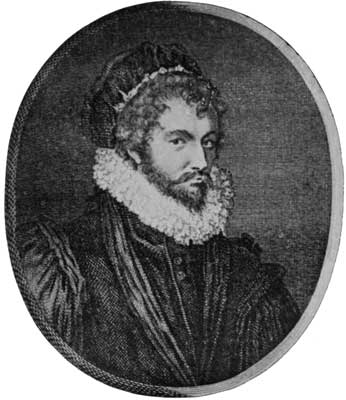
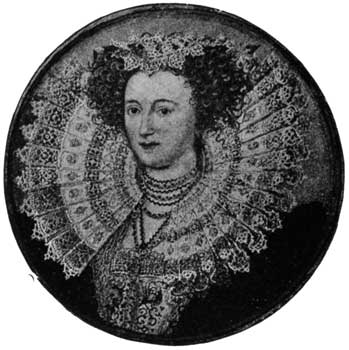
As to many of the others, I give their names for the sake of being comprehensive but with reservations. Take, for example, Lucas de Heere. It may be allowed that he worked in England, and there is a very good oil painting by him in the Palace of Holyrood House, of a lady of the Tudor period, miscalled Mary, Queen of Scots. But I should not like to undertake to produce any evidence that he painted miniatures, in spite of the fact of one of Sir John B. Hatton and his mother being shown at Kensington in 1865, and attributed to him.
This work belongs to Earl Spencer. It is dated 1525, and signed "L." Now, the date assigned to the birth of the artist is 1534. In other words, this group, which comes from a great and justly celebrated collection, namely, Althorp, and was shown under such auspices at that great exhibition of miniatures to which I have so often referred—I say, in spite of all this, a picture is actually catalogued as being by an artist who did not come into existence till nine years after the date which the panel actually bears.
The connection of many of the others with miniature painting is decidedly slight, yet, as need hardly be said, there are contemporary references to them which entitle them to a mention in this list. Thus Lanzi has recorded that Lucca Penni and Giralamo Da Trevigi were employed here. Then[Pg 102] there was a lady miniature painter, a daughter of Master Simon Bennink of Bruges, who was employed by the Court of England. Thus we know that in 1547 "Maistris Levyn Teerling, Paintrix," was paid quarterly £11, and we read of her presenting Queen Mary with a small miniature of the Trinity as a New Year's gift. Again in 1558 she presents her Majesty Elizabeth with the "Queen's picture finely painted on a card," and received in return "one casting bottell guilt," weighing two and three-quarter ounces. And in 1561 she presents "the Queen's personne and other personages in a box, finely painted." "One guilt salt with a cover," weighing five and a quarter ounces, was the return made for this.
Then there was the Horneband, Hornebonde, or Hornebolt family, of whom some interesting particulars will be found in "Archæologia," contributed by Mr. Nichols.
The best known of these appears to be Susannah, whose father was in the service of King Henry VIII. at a monthly pay of 33s. 4d. Her brother Lucas, was even better paid, namely 55s. 6d. per month, a sum which was more, it is interesting to note, than Hans Holbein received.
In April, 1554, the household books of Henry show that the painter was duly paid his salary. In the following month there occurs this entry, "Item for Lewke Hornebonde, Paynter, Wages nil, Quia Mortuus."
Albert Dürer has told us of his meeting members of this family at
Antwerp in 1521. He was impressed with the ability of Susannah, who
was then about[Pg 103]
[Pg 104]
[Pg 105] eighteen years old, and he records how he gave her a
florin, for she had made a coloured drawing of our Saviour, of which he
says, "It is wonderful that a female should be able to do such a work."
ISAAC OLIVER.
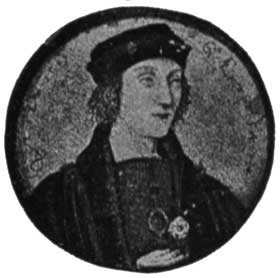 |
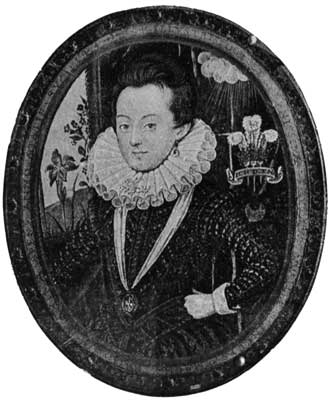 |
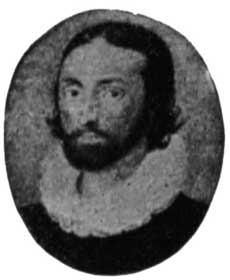 |
| HENRY VII. (H.M. the King.) |
CHARLES THE FIRST WHEN PRINCE OF WALES. (Duke of Rutland.) |
SPENSER. (Lord Fitzhardinge.) |
|---|
Apropos of Antwerp, Joost Van Cleef may be mentioned. He is described as an industrious painter noted for the beautiful rendering of his hands, and according to Van Mander was the best colourist of his time. He came to this country with an introduction from his countryman Sir Antonio More, and Charles I. purchased two or three of his pictures. He was expecting to get great prices for his work, but it seems some canvases by Titian arrived in England at the same time as he did. According to Walpole this threw the Antwerp painter into a jealous frenzy.
He abused More (who was here at the time painting a portrait of Queen Mary by command of Philip) with whom he afterwards returned to Spain, telling him (More) to go back to Utrecht, and keep his wife from the Canons. The unfortunate Van Cleef is said to have painted his own clothes and spoilt his own pictures, and he behaved in such a way that it was necessary to confine him.
There is a portrait of Henry VIII. at Hampton Court ascribed by some to this painter, and the mention of this monarch reminds me of John and Thomas Betts, brothers as is supposed, the former of whom painted Edmund Butts, son of the King's physician. This portrait, in the black cap and furred gown of the period, is to be seen in the National Gallery, and came from the collection of the late George Richmond, R.A. It is a vigorous, soundly[Pg 106] painted work, recalling Holbein in manner, as may be seen, I think, by the illustration shown on p. 77, though markedly inferior in subtlety of rendering of character to that great master.
It has been customary to term John Betts a pupil of Nicholas Hilliard, but this portrait is conclusive evidence on that point, for it is dated in the clearest manner 1545. Now, as Hilliard was not born till two years later, it is sufficiently obvious that John Betts could not have been his pupil.
In the case of these early English artists, John being supposed to have died in 1570, any information which can be given is of interest. Apart from particulars which may be gleaned from biographical dictionaries, it is worth mentioning that at the Winter Exhibition of the Royal Academy in 1879 the Duke of Buccleuch exhibited a miniature of Catherine de Balzac, Duchess of Lennox (wife of Esmé Stuart, created Duke of Lennox by James VI.), and another of Queen Elizabeth, both ascribed to John Betts. At the same exhibition there was a miniature of Thomas Egerton, Lord Ellesmere (Lord Chancellor, 1603), also lent by the Duke of Buccleuch, and Dr. Propert had a miniature of J. Digby, Earl of Bristol, which he ascribed to Thomas Betts.
Thomas and John Betts are mentioned in Mere's "Wit's Commonwealth,"
published in London, 1598, together with other artists whose names are
hardly known and whose works are absolutely unknown. The painters in
question were mentioned in the introduction to the catalogue of the
Kensington Loan Collection of 1865, but not a single example of[Pg 107]
[Pg 108]
[Pg 109]
their work was forthcoming. Confusion reigns as to their date, and
beyond the fact that Vertue mentions a miniature by John Betts of Sir
John Godsalve, who was controller of the Mint to Edward VI., and that
in Hall's Chronicle of the year 1576 (for which he engraved some
vignettes) he is termed a designer, and said to have been a pupil of
Hilliard's, but little is recorded of him.
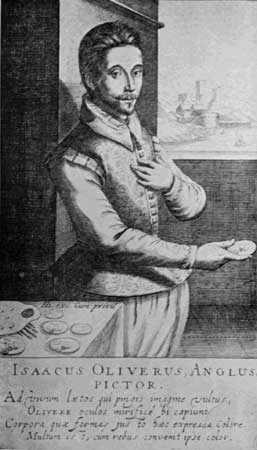
(From a print in the British Museum.)
With the exception of Holbein, and perhaps Petitot, the most important name in connection with our subject, in the list of foreigners which I have given at the commencement of this chapter, is François Clouet or Janet. I shall devote a separate chapter to the latter.
Not least amongst the treasures of the unique collection of miniatures in the Royal Library in Windsor Castle is a small one of Mary Queen of Scots. As I have described this fully in my remarks upon the Royal collection, I shall only now say that it was catalogued for King Charles I. as "supposed to be done by Jennet, a French limner." This name, which is spelt nowadays Janet, is that of a family whose interesting history is given in some detail in Mrs. Mark Pattison's "History of the Renaissance." It is not a little difficult to distinguish between the various members of this family, the Clouets, as they were also called; and we need not stop to deal with the story now, as I have referred to the subject in my remarks on French art (see Chapter XIV.), but there is no doubt that François was Court painter in the reigns of Henry II. and III., of Francis II. and Charles IX. of France, and that his[Pg 110] work belongs to the period with which we are now dealing. Judged by the standard of his own day, this artist attained a high level of excellence, but if we are to judge of the merits of his work rightly, we must discriminate between his finished pictures and his studies for portraits. Now, these latter, some of which were hardly more than memoranda in black and red chalk, were very fashionable in Janet's day, and there is no doubt immense numbers of them were produced. Great personages of the day owned portfolios of them, which in a sense were the precursors of the photographic albums of our own time.
Of Janet's work I can only mention a few examples here. Amongst them is, at Chantilly, a notable one of Mary Queen of Scots, as she was when nine years old, giving, it must be owned, but slender promise of the physical beauty which afterwards she was allowed to possess by foes and friends alike.
Equally interesting, of greater technical merit, and indeed of supreme
importance in their way, are the three superb portraits in the
Bibliothèque Nationale, Paris, of Mary Queen of Scots as Dauphine,
of her first husband, Francis II., and of herself in the white Court
mourning or deuil blanc which she wore as widow of the last named.[2]
Did only these three works exist, they would be quite sufficient to
stamp Janet as an admirable artist, perhaps second only to Holbein in
his way and in his time: I say second, because nothing of Janet's,
so far as I know, has ever[Pg 111]
[Pg 112]
[Pg 113] reached the high level, the searching
execution, the power of draughtsmanship, and the masterly style of Hans
Holbein. It is with that great artist, who may be considered as the
founder of miniature painting in this country, that we have now to deal.
I. OLIVER.
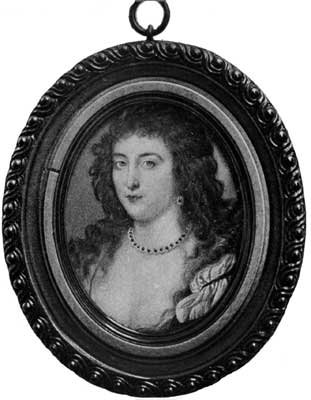
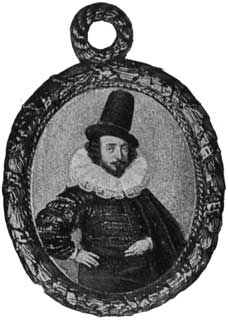
Holbein.
Every tyro in art knows, it may be said, the eminence of Hans Holbein the Younger as a painter, and especially as a portrait painter. He had other gifts as well, to which we shall refer by and by, but perhaps all my readers may not be aware that Holbein must be regarded as the actual founder of the art of miniature painting in England.
As Hans Holbein came to London in 1526 it will be seen that the art of limning has, in this country, a genealogy, so to speak, of nearly four hundred years. And during all that long period, and amidst the great number of artists who worked therein, there is no greater name to be found than that of the Augsburg painter. It is to Erasmus that he owed his introduction to this country, which he visited for the first time when he was about thirty-two years of age. The painter's acquaintance with Erasmus was made at Basle, where, by the way, in the Salle des Dessins, one of the best portraits of Holbein is to be found—a drawing in body colour on vellum, beautifully finished, which I here reproduce. Sir Thomas More was a friend of Erasmus, and it was to the house of this distinguished man that Holbein went on his arrival. There he remained some time, painting portraits of eminent men with[Pg 114] whom he must have come in contact at Chelsea, amongst others—Archbishop Warham, Sir Henry Guildford, Fisher, Bishop of Rochester, Sir Thomas More himself, and two generations of the More family.
After a while he returned to Switzerland, and when he revisited this country in 1531 his friend had become Lord Chancellor. We need not attempt to follow his career here in detail; there is no doubt that he soon was taken into the service of Henry VIII., and, becoming a favourite of that monarch, was attached to the Royal household, and appears to have had apartments in the palace at Whitehall. In 1538 he is spoken of as "a sarvand of the Kynges Majesties named Mr. Haunce." At this time his salary was £30 per annum, as to which the relative value of money, then and now, must not be forgotten. In this year he was at Brussels with Sir Philip Hobby, having a commission to paint the portrait of the young widowed Duchess of Milan. It is a magnificent full-length portrait, one of his finest works, and may be seen in the National Gallery to-day, having been lent by the Duke of Norfolk. This demure-looking lady may be credited with having a pretty wit of her own, if the story told of her reception of an offer of marriage by Henry VIII. be true; the answer she made to these overtures was that she must beg to be excused as she was possessed of but one neck.
The collection of pictures and drawings for pictures attributed to
Holbein, and now preserved at Windsor, is well known and justly
celebrated.[Pg 115]
[Pg 116]
[Pg 117] But it is with the miniatures which are supposed to
be his work that we have most to do in this book. It is somewhat
remarkable that so great an authority as the late Mr. Ralph Wornum must
be allowed to be should dispute the fact of Holbein having ever painted
any miniatures at all. In his "Life and Works of Holbein" he distinctly
asserts that there is not a single miniature in existence which can be
positively assigned to Holbein.
PETER OLIVER.
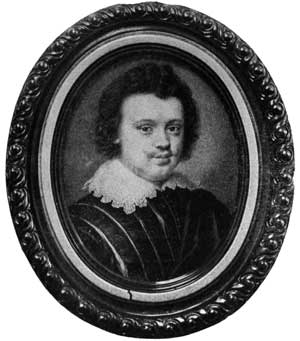
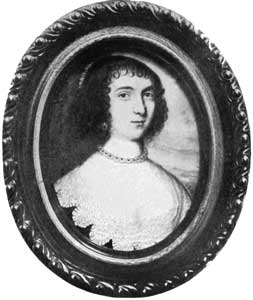
The learned late Keeper of the National Gallery would probably not have disputed that Holbein did paint miniatures, in the face of Van Mander's explicit statement that "he [Holbein] worked equally well in oil and in water-colours; he painted also miniatures of a special excellence, which last art he learned from one Master Lucas, then in London, whom, however, he soon surpassed." Then we have the testimony of Sandrart, who says: "Holbein began practising the art when in the King's service, having been incited thereto by the excellence of the works of Master Lucas." There is no question, either, that Van der Doort regarded Holbein as a limner; in his catalogue of King Charles I.'s collection he speaks of two miniatures of Henry VIII. which he ascribes to Holbein. But Mr. Wornum says of these that it is next to impossible to identify them now. Then there is the express statement of Nicholas Hilliard, who declares himself as the pupil of Holbein in the art of limning.
Finally, in the Bodleian Library is a manuscript by Edward Morgate, dedicated to Henry Frederick, Earl of Arundel, dated July 8, 1654, entitled[Pg 118] "Miniatura, or the Art of Limning," in which it is stated that "the incomparable Holbein, in all his different and various methods of painting, either in oyle, distemper, lymning, or crayon, was, it seems, so general an artist as never to imitate any man, nor ever was worthily imitated by any."
AFTER SIR A. VAN DYCK.
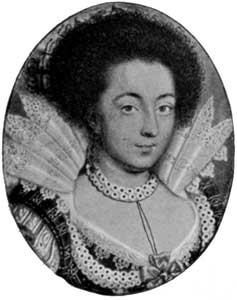 |
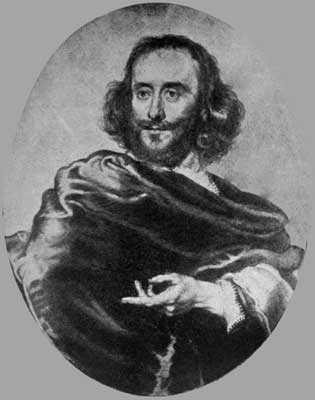 |
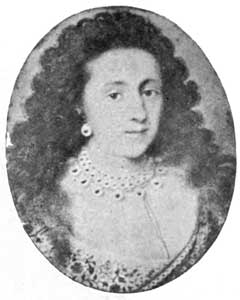 |
| FRANCES HOWARD, COUNTESS OF SOMERSET. | PETER OLIVER. | ARABELLA STUART. (Capt. J. H. Edwards, Heathcote.) |
|---|
But whilst it seems impossible to dispute that Holbein certainly did
paint miniatures, the claims of individual specimens to be considered
as his handiwork are, of course, open to question, since none of his
works of this nature are known to be signed. It may, therefore, be
worth while to state what little evidence can be gleaned about some
of the best known pieces which are attributed to Holbein. There are
at least six in the King's collection at Windsor; of these two are
of Henry VIII.; they were given to Charles I. by Theophilus Howard,
second Earl of Suffolk, who died in 1640. I have described them at some
length in subsequent remarks on the Royal Collection. A third example
is that of Lady Audley. Here, again, we have not direct testimony, but
apart from the technicalities of the execution and so forth, we have
the fact that she was the daughter of Sir Brian Tuke, Treasurer of the
Chamber to Henry VIII., and that a portrait of her in red chalk is
among the drawings by Holbein at Windsor, the authenticity of which is,
I believe, unquestioned. The fourth to be mentioned in this connection
is the portrait of Queen Catherine Howard, a replica of which exists
in the Duke of Buccleuch's collection. Lastly, I may mention two
very interesting portraits of the sons of Charles Brandon, Duke of
Suffolk.[Pg 119]
[Pg 120]
[Pg 121] They were entered in Van der Doort's catalogue as being
"done by Hans Holbein. Given to the King by Sir H. Vane."
These I have also described in Chapter XII., under "The Royal Collection," for opportunities of examining which I may express my obligation to the courtesy of the late librarian, Sir Richard Holmes. The picture of a burgomaster (given on p. 85), is one which has been assigned to Holbein, and it is also at Windsor.
Another of Henry's wives, whose portrait is ascribed to Holbein, and was, we have reason to believe, in the Royal Collection at one time, is Katherine of Arragon. Walpole says of this portrait: "It was given to the Duke of Monmouth by Charles II. I bought it at the sale of Lady Isabella Scott, daughter of the Duchess of Monmouth." When the famous Colworth Collection was dispersed, a piece, purporting to be this particular miniature, painted on vellum, was sold. It is reproduced on p. 91. Its then owner, Mr. Magniac, sent it to the South Kensington Exhibition of 1865, believing it, no doubt, to be as described in the catalogue. But had he referred to the "Anecdotes of Painting" he would have found that Walpole's description of it could not apply to this particular work, seeing that it was on a round, and on a blue ground. In the Strawberry Hill sale catalogue it is described as a "very fine specimen of the master," and was purchased by W. Blamire, Esq., for the sum of £50 8s.
A curious picture of a natural son of Henry VIII., by Lady Elizabeth Talboys, was ascribed to Holbein[Pg 122] in the Strawberry Hill Collection. It was sold to the Duke of Buckingham for seven and a half guineas, and bears the following inscription: "Henry Duck off Richmond, ætatis sue XVo." It is painted on an ace of hearts, and was formerly in the collection of Mr. Sackville Bale, who enjoyed the reputation of being a connoisseur of good judgment. This young man, it may be mentioned, who appears to be painted in his nightdress and a most unbecoming nightcap, did not live to be eighteen years of age.
There is an interesting portrait of Holbein himself to be seen at Hertford House. As Mr. Claude Phillips, the keeper of the Wallace Collection, accepts this as Holbein's work, I shall not stop to discuss its authenticity, but I may remark that there is a duplicate of this particular subject at Montagu House. The Wallace example is in oils on card, whilst the Duke of Buccleuch's piece is in gouache, I believe, on card. The view of the face, the position of the hands, and all the details, except the length of the hair, appear identical. As to the hair, it is certainly longer in the Wallace Collection portrait. This latter piece may be thus described. Head and bust of a middle-aged man, wearing black dress and cap, with a lace open collar, holding a pencil in his right hand and looking at spectator, with whiskers and a short beard, dark in colour and rather sparse. Blue background, circular, about one and a half inches in diameter. It is inscribed "1543. Ætatis suæ 45."
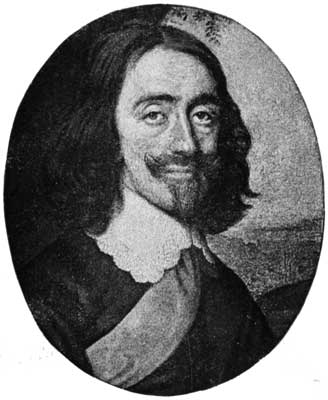
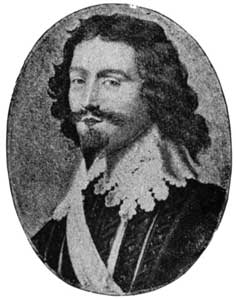
NICHOLAS HILLIARD
As with other branches of art, so with miniature painting, we cannot show any native-born artists of eminence until we arrive at the middle of the sixteenth century, when the series of English miniature painters, properly so called, may be said to begin with Nicholas Hilliard, for we may disregard the one or two others whose names occur only in stray references.
Nicholas Hilliard, born at Exeter, it is said, in 1547, is the first English professed miniature portrait painter whose history can be given. His father was Richard Hilliard, High Sheriff of his county in the year 1560. His mother was a daughter of John Wall, goldsmith, of London, a circumstance which there can be little doubt had much to do with Nicholas Hilliard being brought up to the business of jeweller and goldsmith, occupations closely connected with limning in those days.
Assuming the date usually given for his birth to be correct, as to which I shall have something to say farther on, he engraved the Great Seal when[Pg 128] he was forty years of age. This means that his reputation was already made—and indeed he had been appointed goldsmith, carver, and portrait painter to Queen Elizabeth, "to make pictures of her body and person in small compass in limning only." According to Pilkington, he owed his introduction to the Virgin Queen to the interest of Sir Walter Raleigh, but I have not met with any corroboration of this statement. It is also commonly said that Hilliard was enjoined to paint her Majesty without shadows. From what we know of the vanity of Elizabeth this is not improbable, though it is, to my mind, by no means certain; and there is another reason for the flatness of treatment which is undoubtedly characteristic of his work, which I shall deal with in considering his method of painting.
James I. granted him a patent to this effect: "Whereas our well-beloved servant, Nicholas Hilliard, gentleman, our principal drawer of small portraits, and embosser of our medals in gold, in respect of his extraordinary skill in drawing, graving, and imprinting, &c., we have granted unto him our special licence for twelve years, to invent, make, grave and imprint any pictures of our image, of our Royal Family, with power to take a constable and search for any pictures, plates, or works, printed, sold, or set up."
There is not much to be said about the career of Hilliard, and this
work is not greatly concerned with biographical details. It must,
however, be observed that Hilliard had an only son, Lawrence, who
followed his father's profession, and enjoyed[Pg 129]
[Pg 130]
[Pg 131] the patent granted by
King James, until its expiration.
S. COOPER.
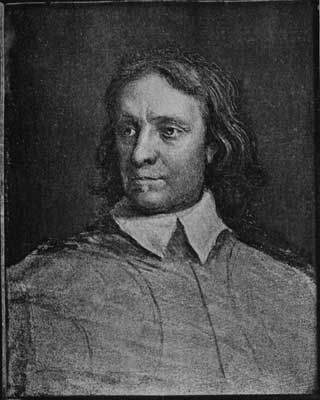
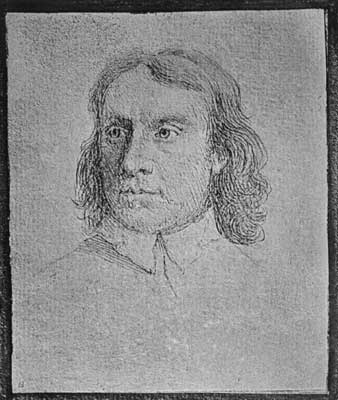
There is a warrant of the Council, dated 1624, extant, ordering the payment of £42 to Lawrence Hilliard for five pictures "by him drawn." Probably this privilege was a source of emolument to the Hilliard family (by the way, Lawrence had several children), and gave them control over the engravers and print-sellers of the period to whom licences were granted. Simon de Passe was employed by them in engraving small plates of the heads of the Royal Family.
Nicholas Hilliard died on the 6th of January, 1619, and was buried in St. Martin's in the Fields. He left to his sister, Ann Avery, £20 out of the £30 due to him as his pension. This, it will be remembered, is the same amount as Holbein's salary.
Works by Nicholas Hilliard are by no means rare. We have just seen that he lived to over seventy years of age, and was probably pretty fully employed during the greater part of his career, as is shown by portraits of James I. and his consort, Anne of Denmark, of which several exist.
Fourteen examples of his work were shown at the Winter Exhibition of the Royal Academy in 1879, of which four came from the Royal Library at Windsor. A still larger collection was exhibited at the Loan Collection at Kensington in 1865, and I have, at one time or another, examined a great many examples personally. It may be said of all these that they are characterised by uniformity of style, treatment, and quality.
We have Hilliard's own statement as to his artistic training: "Holbein's manner of limning I have ever imitated," he says, "and hold it for the best." Horace Walpole has remarked concerning this "manner of limning": "Although he copied the neatness of his model (Holbein), he was far from attaining that nature and force which that great master impressed on his most minute works. Hilliard," he continues, "arrived at no strength of colouring; his faces are pale and void of any variety of tints, the features, jewels, and ornaments expressed by lines as slender as a hair. The exact dress of the times he curiously delineated, but he seldom attempted beyond the head, yet his performances were greatly valued."
The paleness of the faces in Hilliard's work, as it exists to-day, is true enough, and would seem to justify the criticism of the owner of Strawberry Hill, and his statement that the painter "arrived at no strength of colouring," but before we accept the conclusion that his portraits always possessed the bloodless appearance they now present, we may ask whether it is by any means certain that they were originally marked by this defect.
It must be remembered that they were painted more than three hundred
years ago, which is ample time for the flesh tints to have faded right
out. We know how the carnations have flown in numberless examples of
comparatively recent work, the ghastly paleness of which robs them of
all beauty. The more perfect condition of the jewels and ornaments,
with which the figures in Hilliard's pictures[Pg 133]
[Pg 134]
[Pg 135] are so profusely
adorned, is not conclusive, owing to the opaque nature of the colours
and the quantity of gold he was wont to use. He commonly painted on
card or vellum, and employed, it is said, a brush composed of hairs
from a squirrel's tail. His works are generally signed "N. H.," and
frequently have a motto and date written round the edge in Latin and
abbreviated.
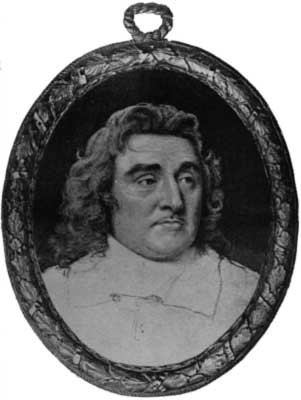
What is known as "quality" in works of art is a very elusive factor in their charm, and it is proportionately difficult to express in words. Indeed, I might go farther, and say that a large proportion of people who look upon works of art never realise what it means. Hence it is always difficult to assign with absolute fairness and accuracy the rank of a given artist.
There are many things to be taken into consideration, but I think it may be safely said of Hilliard that he stands well in the front of the second row of our native miniature painters. He is certainly inferior in finish and beauty to the Olivers, and his heads are even more deficient in the wonderful rendering of character and the masterly execution of Samuel Cooper, but his faces are well drawn, and are differentiated—far more so, for instance, than are the insipidities of Kneller and Lely and the early Georgian artists.
We know that he won the admiration of his contemporaries, both strangers and fellow-countrymen. In Heydock's translation of "Lomazzo on Painting," published in 1598, we are told that "limning was much used in former times in church books, as also[Pg 136] in drawing by life in small models of late years by some of our countrymen, as Shoote, Betts, &c.; but brought to the rare perfection we now see by the most ingenious, painful, and skilful master, Nicholas Hilliard."
The ornate jewellery which he appears to have painted with such care was, of course, the fashion of the time, as were the elaborate ruffs, both of which are well shown in the accompanying portrait of Lady Mary Sidney, Countess of Pembroke—an extremely interesting miniature, by the way, which came from Penshurst. This lady was the daughter of Sir Henry Sidney, and married Henry, second Earl of Pembroke. It was to her that Sir Philip Sidney dedicated his "Arcadia." She died in her House at Aldersgate Street, and was buried in Salisbury Cathedral. She was the subject of the well-known epitaph by Ben Jonson:—
Penshurst Place, the charming old home of the Sidneys, possesses, or
did possess, the portrait of the painter himself in his thirtieth year.
It is probably also the background in the elaborate and beautiful
miniature by Isaac Oliver, in the Royal Collection, which adorns this
volume (see p. 295). From Penshurst, too, came the profile of Elizabeth
given in this book. I refer to it here because it illustrates so[Pg 137]
[Pg 138]
[Pg 139]
perfectly what Walpole has said about portraits of Elizabeth, who,
as we have seen, was certainly painted by Hilliard, and it is an apt
criticism on the miniature painting of the time.
S. COOPER.
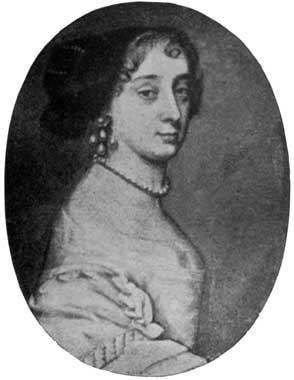 |
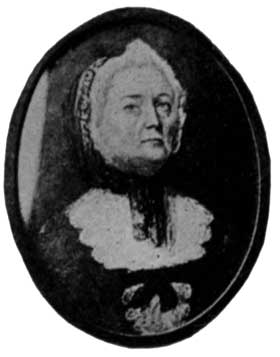 |
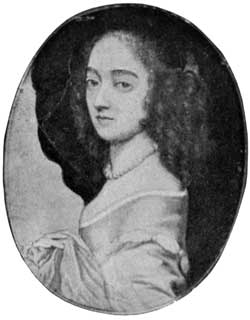 |
| DUCHESS OF CLEVELAND. (Countess of Caledon.) |
O. CROMWELL'S MOTHER. | LADY LEIGH. (Sackville Bale Collection.) |
|---|
Speaking of the numerous portraits of Elizabeth which exist, he says there is not a single one to be called beautiful. They are totally composed of hands and necklaces. A pale Roman nose, a head of hair loaded with crowns and powdered with diamonds, a vast ruff, a vaster farthingale, and a bushel of pearls, are the features by which every one knows them at once. In this connection it may be observed there is another portrait of Queen Elizabeth, spoken of by Walpole as one of Hilliard's most capital performances, namely a whole length of her in robes, sitting on her throne. This was in King Charles I.'s Collection, and included in the catalogue by Van der Doort, to which frequent reference has been made, but, so far as I am aware, its whereabouts is not now known.
Fourteen Hilliards are specified in the above-named catalogue, including a view of the Spanish Armada. Four of these, portraits, and copies of older pictures, are now at Windsor, and were once attached to a gold and enamelled jewel, the work on which, it is surmised, was probably also Hilliard's, he being, as we have seen, the Court goldsmith; the portraits are those of Henry VII., Henry VIII., Jane Seymour, and Edward VI. The latter Van der Doort describes as "meanly done," "upon a round card." This remarkable example of goldsmith's work has on one side the roses of York and Lancaster and on[Pg 140] the other a representation of the Battle of Bosworth Field. There are jewelled badges upon the dress and cap of Henry VII., and the miniature is dated 1509, the year of his death. In Horace Walpole's copy of Van der Doort's catalogue, it is noted: "The above jewel and pictures were done by old Hilliard, and given to the King by young Hilliard, by the deceased Earl of Pembroke's means."
It is possible, by means of the miniatures of Nicholas Hilliard, to realise the appearance of many of the personages of Tudor times, and of Elizabeth's Court in particular. Thus, in the Duke of Buccleuch's Collection is a portrait, on vellum, of Edward Seymour, Duke of Somerset; he was the brother of Jane Seymour, uncle of Edward VI., and was beheaded on Tower Hill, 1552.
Also in the Buccleuch Collection is one of the most beautiful of this artist's works, namely, a portrait of Alicia Brandon, daughter of John Brandon, Chamberlain of the City of London. She was the wife of Hilliard, and was painted by him in her twenty-second year, 1578. The picture is charming from the vivacity of the features and its delicate execution. It is circular in form, signed N. H. (connected), and is preserved in a rose-turned case of logwood with an ivory circular rim. It was shown in the Royal Academy Winter Exhibition in 1879.
In the Colworth Collection there was formerly a portrait of Darnley,
Earl of Lennox, thus inscribed: "Comes linoz ano Dni 1560 ætatis Suæ
18." I give this description as it is a typical instance of the[Pg 141]
[Pg 142]
[Pg 143]
abbreviations one commonly finds on Hilliard's miniatures.
ALEXANDER COOPER.
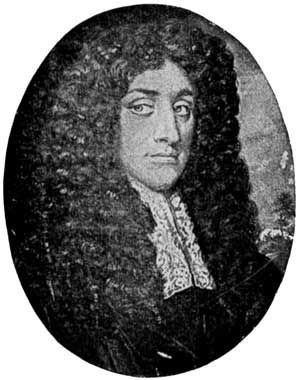
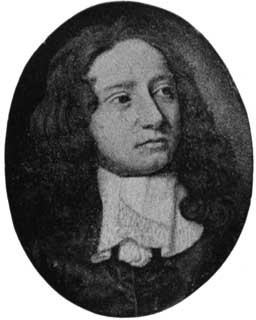
Mrs. Naylor Leyland owns a portrait of Mary Stuart, Queen of Scots, which is ascribed to Hilliard, and has a circumstantial history. It is said to have been given by the unfortunate Queen to one of her Maids of Honour on her marriage, from whom it descended to her grandson, the second and last Earl of Middleton, and thence to the present possessor. Of course, it is quite possible that this is the work of Hilliard, although most improbable that the painter ever saw her. In the case of another unfortunate lady of the period, namely, Arabella Stuart, the case is different, and he may quite well have had access to this ill-fated victim of the fears of James I.
Walpole possessed two of her, one when young, which may be that owned by the Duke of Buccleuch, representing her as a girl with a baby face. James I. and his wife were painted by him, as we have already mentioned, and one portrait of the Scottish Solomon was sold at Christie's for a very large sum. Of the courtiers of Elizabeth we have a number of well-known personages, Essex and Dudley, for example; of Drake when forty-two, in Lord Derby's Collection; and a portrait of George Clifford, Earl of Cumberland, Elizabeth's champion, dressed as for a tournament, in an enormous flapped hat, with a glove, the emblem of his office, fixed on the front of it. This picture is well known from the engraving by R. White.
At Kensington, in 1865, might have been seen Nicholas Harbon, Ambassador to Constantinople;[Pg 144] Mrs. Holland, one of Elizabeth's Maids of Honour; Lord Keeper Coventry; Lady Hunsdon; and a portrait of the poet Spenser, which last is the property of Lord Fitzhardinge, and here shown.
ISAAC AND PETER OLIVER, AND JOHN HOSKINS
Those of my readers who are able to agree with the estimate already advanced in this work as to the unique position held by Samuel Cooper in the ranks of British miniature painters, will be able to gauge the position which may be assigned to Isaac Oliver when they read Walpole's opinion of his powers. He expresses it in the following terms: "We have no one," says he, "to put in competition with Isaac Oliver, except it be our own Cooper." This is tantamount to saying that this painter, Oliver, was one of the greatest we have ever had, in his own walk of art. It must be remembered that there were two Olivers—Isaac the father, and Peter, his eldest son and pupil. Walpole could find no account of the origin of the family, but he notes that in the elder painter's pocket-book was a mixture of English and French, a point not without significance. The connoisseur of Strawberry Hill, whose opinions on art generally, and on his own magnificent collection in particular, are so interesting, and which we have so often quoted, states that the excellence[Pg 148] of the elder Oliver was such that "we may challenge any nation to show a greater master"; and Peacham states that to Hilliard, in conjunction with Zucchero, has been given the credit of having instructed "a limner inferior to none in Christendome for the countenance in small."
The elder Oliver was born in 1555 or 1556. He died in his house at Blackfriars in 1617, the date of Raleigh's execution, and just a year after the death of Shakespeare. That he was at work till the close of his life is clear from the inscription upon one of the finest examples of his powers, namely, the portrait of the Earl of Dorset, formerly in the possession of Mr. C. Sackville Bale, sold at Christie's in 1880 for £750, and now one of the most valuable miniatures in the collection Mr. John Jones bequeathed to the nation, which is housed in the Victoria and Albert Museum. It is a full length, nearly ten inches high, and thus signed, "Isaac Olliuierus fecit 1616."
As in the case of other artists mentioned in this book, I do not think it necessary to dwell much upon the facts of their careers; what I think more important, and at least as interesting, is to give some idea of their relative ability, of the character of their work, and a more or less critical account of some accessible examples to be found in this country. That, amplified to an extent not possible in this volume, is what I set before myself in my preceding works upon Miniature Painters, and in practice I have not found any better way of treating the subject. So, then, we may dis[Pg 149]regard the biographical details of Oliver's life, of which, I take it, there are indeed very few to be gleaned. We have settled upon excellent authority his rank and qualifications as a miniature painter, and seen that he ranks as second only to the "incomparable Samuel Cooper."
Let us now turn to some of the principal known works of this admirable artist which have survived. Probably the largest number is to be found in the Duke of Buccleuch's magnificent Collection at Montagu House; but we may refer first of all to those in the Royal Library at Windsor, and begin with the celebrated full length of Sir Philip Sidney sitting under a tree in an arcaded garden, which some think conveys an allusion to the "Arcadia." It is shown on p. 295, and is reproduced on the exact scale of the original. This, with so many other of the finest of the old miniatures, was formerly in the Strawberry Hill Collection. It was sold at West's sale for the paltry sum of £16 5s.
We have evidence of four miniatures being painted for Charles I. when Duke of York, as is shown by an entry of payment by warrant in the office books of the Chambers, dated Lincoln, 1617: "To Isaace Oliver for four several pictures drawn for the Prince His Highness, Forty pounds." A profile of Anne of Denmark, now at Windsor, may be one of these, she being the mother of Charles I.; as may also be the portrait of Henry, Prince of Wales, his brother, which, according to Sir Richard Holmes, is the finest extant of that Prince. It is described in Charles I.'s catalogue as follows: "Number 17, done[Pg 150] upon the right light, the biggest limned picture which was made of Prince Henry, being limned in the set lace ruff and gilded armour and a landskip wherein are some soldiers and tents, in a square frame, with a sheeting glass over it, done by Isaace Oliver, five and a quarter inches by four."
The interesting portrait of George Villiers, Duke of Buckingham, who was stabbed by Felton at Portsmouth in 1628, is probably a late example of the master, and is in his Majesty's Collection. It is figured on p. 126, as is also the interesting miniature of the artist himself in a tall felt hat (see p. 111), which we may conclude was the height of fashion of the period, there being one extremely like it in the National Gallery, worn by James I. The miniature here shown is also in the King's Collection.
PETITOT.
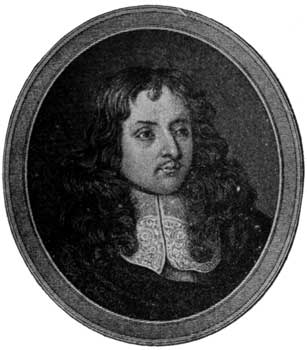 |
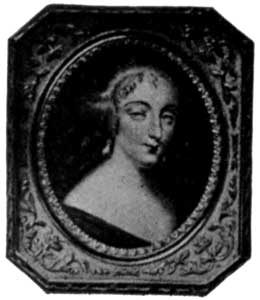 |
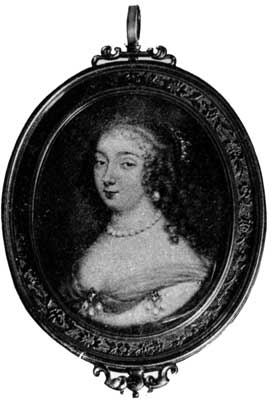 |
| BY HIMSELF. | MLLE. FONTANGES. | HENRIETTE D'ORLEANS. (Burdett-Coutts Collection.) |
|---|
Amongst the miniatures by Oliver which are best known are those of Sir Kenelm Digby and his family, which were shown at Messrs. Dickinson's Loan Exhibition of 1880. Comparisons are odious, but it must be admitted that those belonging to the Burdett-Coutts Collection are in finer condition than those preserved at the home of the Digbys, namely Sherborne Castle, Dorset, a picturesque Jacobean mansion given by James I. to Sir Walter Raleigh.
These interesting portraits were once at Strawberry Hill, where they hung in "the blue breakfast room." The way they came into the possession of Horace Walpole is worth telling. It aptly shows how easily treasures of this kind may be forgotten and lost. Writing about Peter Oliver's habit of making duplicates of his works, Walpole says:—
"Since this work was first published a valuable treasure of the works of this master, and of his father Isaac, was discovered in an old house in Wales, which belonged to a descendant of Sir Kenelm Digby (Mr. Watkin Williams). The latest are dated 1633, but being closed in ivory and ebony cases, and the whole collection locked up in a wainscot box, they are as perfectly preserved as if newly painted. They all represent Sir Kenelm and persons related to or connected with him. There are three portraits of him, six of his beloved wife at different ages, and three triplicates of his mistress, all three by Isaac Oliver, as is Lady Digby's mother, which I have mentioned before. But the capital work is a large miniature copied from Van Dyck of Sir Kenelm, his wife, and two sons, the most beautiful piece of the size that I believe exists (see p. 289). There is a duplicate of Sir Kenelm and Lady Digby from the same picture, and though of not half the volume, still more highly finished. This last piece is set in gold, richly inlaid with flowers in enamel, and shuts like a book. All these, with several others, I purchased at a great price, but they are not to be matched."
It is noteworthy that nearly all the portraits of Sir Kenelm and his wife ascribed to Isaac Oliver must be by Peter, as Isaac died when the originals were boy and girl. Sir Kenelm Digby was born in 1603. Isaac Oliver was buried in October, 1617. One of the portraits is dated 1627. This discrepancy in Walpole's account, wherein, as we have seen above, he speaks of Sir Kenelm's mistress as being painted by the elder Oliver, may be owing to his[Pg 154] misreading the monogram. The large copy after Van Dyck of the family group is dated 1635.
Amongst the Digby portraits at Sherborne Castle is that remarkable one of Venetia Lady Digby lying dead in her bed. This is ascribed to Peter Oliver. Walpole had six portraits of her at different ages, and Lord Clarendon speaks of her as "a lady of extraordinary beauty and of as extraordinary fame." Nor was her husband less remarkable. I have somewhere seen him described as "the bravest gentleman and the biggest liar of his time." Be that as it may, he was certainly of handsome appearance, extraordinary strength, and distinguished as a soldier, scholar, and courtier. His father was Sir Everard Digby, who was executed for his share in the Gunpowder Plot. Sir Kenelm renounced the faith of his father, and was entered at Gloucester Hall, Oxford. He was on the Continent at an early age, and, returning in 1623, was knighted by James I. Five years later we hear of him commanding a small squadron in the Mediterranean. During the Civil War he had the prudence to retire to France. Returning to England at the Restoration, he lived at his house in Covent Garden till the year of his death, namely 1665.
His wife, Venetia Anastasia, was the youngest daughter of Sir Edward Stanley, and was born at Tong Castle, in Shropshire, in 1600. They had two sons—Kenelm, killed during the Civil War in a skirmish at St. Neots; and John, who was disinherited by his father, but ultimately succeeded to a portion of the property.
Judging from the lovely group after Van Dyck[Pg 155] which, by the courtesy of the late lamented Baroness Burdett-Coutts, I am able to show of this interesting family, these two sons would seem to have inherited the physical beauty of their parents. Another group not less remarkable, and in a sense more interesting in this connection, inasmuch as it is an original work of the artist himself, and not a copy from any other, is that of the three brothers, Anthony Maria, John, and William Browne. This noble piece, which measures ten inches by nine, is now at Burleigh, the owner of which historic house, the Marquess of Exeter, is descended from the eldest of these young men. The work was known to Walpole, and was at Cowdray in his time. He thus describes it: "At Lord Montague's at Cowdray is an invaluable work of Isaac Oliver's. It represents three brothers of that lord's family, whole lengths in black. These young gentlemen resemble each other remarkably, a peculiarity observable in the picture, the motto on which is figuræ conformis affectus. The black dresses are relieved by gold belts and lace collars, and contrasted by the silver-laced doublet of another young man, presumably a page, who is entering the room."
This beautiful group is in perfect preservation, of absolutely superlative quality, and, as we have seen, upon an important scale. It possesses also the interest of having, with three other pictures, escaped the disastrous fire at Cowdray in 1793. This fatality is said to have marked the end of the race of the Lords Montague, and the last scion of the house lost his life over the Falls of Schaffhausen just at the time the flames destroyed the old family mansion. It is[Pg 156] said that messengers—one bearing the news of the death of the last Lord Montague by water and the other of the destruction of the home of the race by fire—met one another in Paris. Earl Spencer possesses a very fine copy of this work in oils, painted by Sherwin in 1781.
Any readers who may desire further genealogical details of the brothers represented will find them in my book on "Miniature Painters, British and Foreign," pp. 39 and 40.
I am not aware of Isaac Oliver holding any appointment at Court, but of courtiers and of the aristocracy of his day he must have painted a great number. This was made clear at the exhibition of the Burlington Fine Arts Club in 1889, when some five and twenty or thirty more or less well-authenticated works by Isaac Oliver were shown, besides a number by Peter Oliver.
That masterpiece of Oliver's, the Earl of Dorset, now in the Jones Collection, at Kensington, has already been described, and reference has been made to the portrait of Buckingham belonging to the King. There was another of "Steenie," by Isaac Oliver, in the Propert Collection. Mr. Jefferey Whitehead owns, or did own, a couple of portraits of Sir Francis Drake. Lord Derby possesses one of the ill-fated Elizabeth of Bohemia.
Robert Devereux, Earl of Essex, appears to have been painted oftener,
almost, than any one of his time. Thus, the Duke of Devonshire
possesses two Olivers of him, the King another, and there was one in
the Propert Collection also assigned to him. The[Pg 157]
[Pg 158]
[Pg 159] "wicked" Countess
of Essex, Frances Howard, afterwards Countess of Somerset, condemned
to death for her share in the murder of Sir Thomas Overbury, was also
painted by Oliver. The Earl of Derby and Major-General Sotheby possess
miniatures of her.
PETITOT.
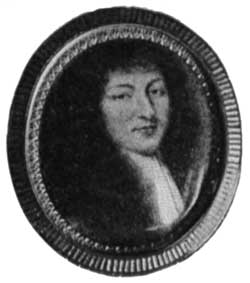 |
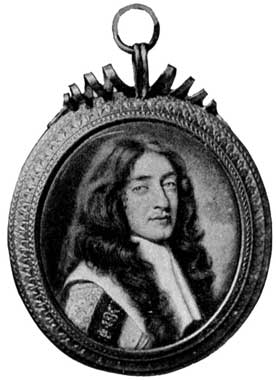 |
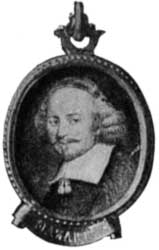 |
| LOUIS XIV. | JAMES II. (Burdett-Coutts Collection.) |
CARDINAL MAZARIN. (Earl of Carlisle.) |
|---|
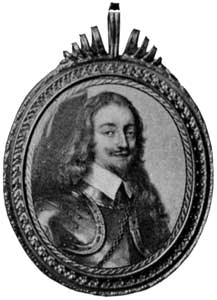 |
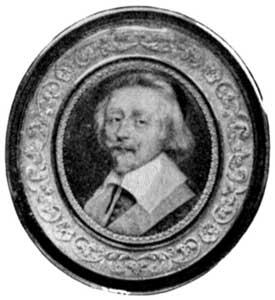 |
| LOUIS XIV. | CARDINAL RICHELIEU. (Burdett-Coutts Collection.) |
|---|
There is a passing reference to Isaac Oliver in the very interesting autobiography of Lord Herbert, of Cherbury. That remarkable man tells a story of "a Lady, wife to Sir John Ayres, knight, who, finding some means to get a copy of my picture from Larkin, gave it to Mr. Isaac [Oliver], the Painter in Blackfriars, and desired him to draw it in little, after his manner, which being done, she caused it to be set in gold and enamelled, and so wore it about her neck so low that she had it under her breasts." Lord Herbert adds that he caught Lady Ayres lying upon her bed contemplating the miniature!
The temptation to stop and gossip about some of these people, as, for instance, the lady to whom reference has just been made, is almost irresistible; in truth it may be said that almost all the people painted by Oliver are remarkable either for their virtues, their vices, or their misfortunes; in this latter category must be placed the unfortunate Arabella Stuart, of whom Major-General Sotheby and Mr. J. K. D. Wingfield Digby possess examples, the latter owning two.
The number of portraits existing of this lady, of various kinds, is somewhat remarkable, and I am led to surmise that it may be accounted for by the sympathy aroused by the fate of this unhappy creature.[Pg 160] I may mention, in support of this conjecture, the existence of a miniature that belonged to a collection which may be described as the Stuart Collection, inasmuch as it once belonged to James II., and has a circumstantial history which we must not stop to go into here, further than to say that these miniatures are all supposed to possess historical authenticity, and are works of high quality. Amongst them is one of Lady Arabella Stuart, ascribed to Peter Oliver. Now, the ill-fated victim of the political jealousy of James I. ended her days in the Tower in 1615, and Peter Oliver, whose work it is supposed to have been, was not born till 1601, or as some say 1604; hence it is almost impossible that he could or did paint it from life. The fact that he painted her at all, a political prisoner, whose reason had given way before the artist was in his teens, points to an interest in her fate, whether felt by him or by others, such as led, as I have said, to a multiplication of her portraits.
Catherine Cary, Countess of Nottingham, whose portrait is in the Duke of Buccleuch's Collection, and Lady Teresa Shirley are both ladies with stories which belong to the byways of history.
Before leaving Isaac Oliver, there is one other kind of work of which he did a good deal, and to which I must refer, namely, the copying in miniature of paintings by the old masters, of which—but this is by the way—Peter Oliver appears to have done still more. Isaac did not live to finish all his work of this nature, as is shown by an entry in the catalogue of Charles I. of a "great limned piece of the Burial of Christ, which was invented by Isaac Oliver, and[Pg 161] was left unfinished at his decease, and now, by His Majesty's appointment finished by his son Peter Oliver."
Peter Oliver erected a monument to his father in the Church of St. Anne's, Blackfriars; it was a bust, and both the monument and the church perished in the Great Fire of 1666. Vertue recalls having seen a model of the bust; and with a copy of the entry occurring in the register of this church I may conclude my remarks on Isaac Oliver: "Isaack Oliver buried 2nd October 1617. Mr. Peter Oliver buried September 22 1647."
Peter Oliver
Peter Oliver was the eldest son of his father, and was born, as we have before observed, at the very opening of the seventeenth century. There is a portrait of him by Hanneman, a Dutch painter who came to this country soon after Van Dyck, at Hampton Court, which, if we may trust it, shows him to have been a man with dark brown hair and dark, dreary eyes. As he did not live to be fifty years of age, dying two years before the execution of Charles I., he must have worked hard. The Van der Doort catalogue, of which frequent mention has been made, includes thirteen of the paintings once in the possession of Charles, which were copied in water colours by Peter Oliver, as were portraits of the Stuart family.
He married, and had children, and Vertue tells a story, upon the authority of Russell the painter, who was connected with the Olivers, which shows that[Pg 162] Peter Oliver's work for and in connection with the Court was well known to Charles II. We do not hear much of the "Merry Monarch" as a patron of art, nor as a model of filial affection, but some motive or other took him incognito, we are told, to Isleworth on a visit to the widow of Peter Oliver to make inquiries about miniatures which she was supposed to possess. "The King went very privately ... to see them, the widow showed several finished and unfinished; asked if she would sell them, she said she had a mind the King should see them first, and if he did not purchase them, she would think of disposing of them; the King discovered himself, on which she produced some more pictures which she seldom showed. The King desired her to set her price; she said she did not care to make a price with His Majesty, she would leave it to him, but promised to look over her husband's books, and to let him know what prices his father, the late King, had paid. The King took away what he liked, and sent Rogers to Mrs. Oliver with the option of £1,000, or an annuity of £300 for life, and she chose the latter. Some years afterwards, the King's mistresses having begged all or most of these pictures, Mrs. Oliver said, on hearing it, that if she had thought that the King would have given them to such unworthy persons, he never should have had them. This reached the Court, the poor woman's salary was stopped, and she never received it afterwards."
Apropos of the return of the many treasures which we know were
dispersed at the close of the Civil War, I may mention an instance of a
piece which[Pg 163]
[Pg 164]
[Pg 165] was formerly in the Royal Collection, and has gone back
to Windsor of recent times. It is an interesting work by Peter Oliver,
dated 1628, and is a copy of Raphael's "St. George," about half the
size of the original, which latter, by the way, was presented to Henry
VII. by the Duke of Urbino, in return for the Order of the Garter. The
copy found its way back to the Royal Collection in 1883, having been
purchased at the sale at Christie's of the Hamilton Palace treasures in
that year.
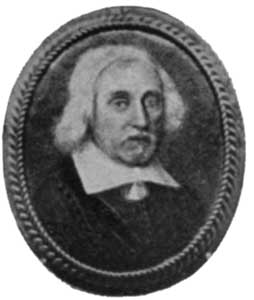 |
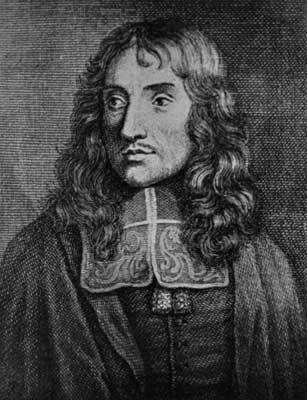 |
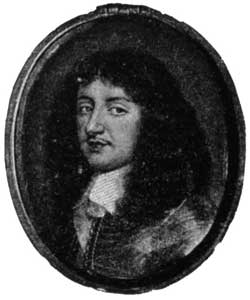 |
| PETITOT LE VIEUX. (Earl Dartrey) |
PETITOT. (From a print in the British Museum.) |
CHARLES II. (Burdett-Coutts Collection.) |
|---|
Sir Richard Holmes, to whom I am indebted for the information, surmises that the copy may have been given by Charles to the Marquess of Hamilton. The original painting, one regrets to say, was sold at the Rebellion; it is now the property of the Russian Crown, and hangs in the Hermitage at St. Petersburg.
There is an interesting entry in John Evelyn's diary just after the Restoration, which runs as follows: "I went with some of my relations to the Court, to show them His Majesty's cabinet and closet of varieties, the rare miniatures of Peter Oliver after Raphael, Titian, and other masters, which I infinitely esteem."
Judging from the amount of work in the shape of copies of the old masters, which we know to have been executed by Peter Oliver, and, further, the comparatively small number of portraits by him one meets with, it would seem probable that he did less in the way of portraiture than his father. Thus at the Burlington Fine Arts Club exhibition works assigned to Isaac Oliver were at least three times as numerous as those assigned to Peter Oliver. I may[Pg 166] mention here that besides the Digbys, the younger artist was also credited in this collection with having painted the Countess of Nottingham and the Earls of Somerset and Southampton, Lady Arabella Stuart, and others.
Where there are two artists of the same name working at the same period, as in the case of the Olivers, mistakes easily occur, and we have seen an instance of it in the case of Walpole's error with regard to the Digby family, as shown on a preceding page. I may therefore call collectors' particular attention, in distinguishing the works of these great limners, to the fact that the elder Oliver signed his works with a monogram F, whilst the younger used the initials P. O. connected.
John Hoskins
The researches both of Vertue and of Walpole have resulted in discovering but very little about the career of that excellent miniature painter John Hoskins, and both quote an extract from Graham's "English School," to this effect: "He [Hoskins] was bred to face painting in oils, but afterwards taking to miniature, far exceeded what he did before. He drew Charles, his Queen, and most of the Court, and had two considerable disciples, Alexander and Samuel Cooper, the latter of whom became much the more eminent limner"; and though it must be conceded there is not much to be gleaned about the life of the man, it is evident that he had a considerable share of the Court and aristocratic patronage in his day.
The Earl of Wharncliffe possesses, or did possess, portraits of the Countess of Carlisle, as well as one of Oliver Cromwell. Mr. Whitehead does, or did, possess one of Lucy, Viscountess Falkland; also one of John Gauden, Bishop of Worcester. Lord Derby owns a portrait of the ill-fated Henrietta Maria; the Duke of Devonshire one of Thomas Hobbs, philosopher; General Sotheby owns portraits of Sir Edmundbury Godfrey and Sir Charles Lucas.
We miss in the works of Hoskins the minute touch of Hilliard, the refinement of the Olivers, and the breadth of Samuel Cooper; yet Sir Kenelm Digby, in his "Discourses," says that "by his paintings he pleased the public more than Van Dyck." Horace Walpole allows his heads to have great truth and nature, but finds fault with the carnations as "too bricky and wanting a degradation and variety of tints."
The few lines quoted above virtually sum up the approximate rank and position of John Hoskins, and I am not aware that recent biographers have discovered anything of importance to add to them. That he was master to such an artist as Samuel Cooper, and that his pupil's manner was clearly formed on that of the master, constitute, perhaps, the strongest claim that can be urged for Hoskins in connection with this subject.
There is a great deal of truth to nature in Hoskins's work. Elsewhere I have termed his style virile and unaffected, and I do not know that I can find more appropriate epithets. At the same time, the justice of Walpole's criticism, that Hoskins is defective in[Pg 168] colour, must be admitted. It is quite true that the carnations are too bricky, and wanting in gradation and variety of tint. This deficiency, which is a very serious one in miniature painting, depriving the flesh tints of their charm, may be traced in part to the medium employed. The amount of body colour used by limners of this period was so great, that the transparency of tone attained by later painters was impossible.
The work of the incomparable Cooper himself is not free from this defect, and we see it carried to excess both in the case of Cooper's master and in that of his pupil Flatman. All three are marked by a certain dryness of colour attaining to brickiness, only Cooper generally avoids the extremes into which the other two artists fall. This fault, it may be said, is characteristic of examples I have seen and possess.
The character of Charles I., whose melancholy visage Hoskins has drawn in a miniature now at Windsor, and here shown, is extremely well rendered. In the Duke of Rutland's valuable collection at Belvoir Castle there is an interesting portrait of Charles, when Prince of Wales, aged fourteen, ascribed to Hoskins, but infinitely inferior in the rendering of expression. Lord Carlisle owns, I believe, a replica of the last named. One of the finest examples of the master that I have met with is a portrait of Percy, tenth Earl of Northumberland, now in the collection of Lord Aldenham, and this nobleman also possesses a portrait of Elizabeth, wife of Frederick, fifth King of Bohemia.
The question has been raised whether there were two John Hoskinses, father and son. It will be noticed that in an extract from Graham which I have given he speaks of but one Hoskins, and those who argue that there were two appear to rest their contention mainly upon the foundation of a variation in the manner of signing the portrait. Thus the mark + is said to distinguish the works of the father from those of the son, which have I. H. simply. But if this be the test, then it may be urged that there were several John Hoskinses, since amongst the miniatures shown at Burlington House from Windsor, and by the Duke of Buccleuch, ascribed to Hoskins, there were the following different signatures: H. only, I. H. 1645, I. H. fc, I. H. (connected).
I am unable to give the date of the birth of John Hoskins, but he died in 1664, and was buried in St. Paul's, Covent Garden.
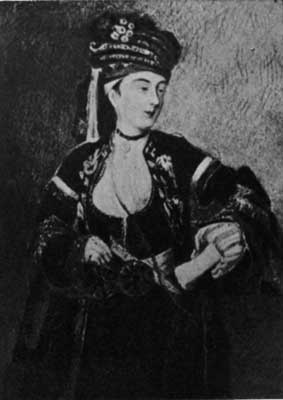
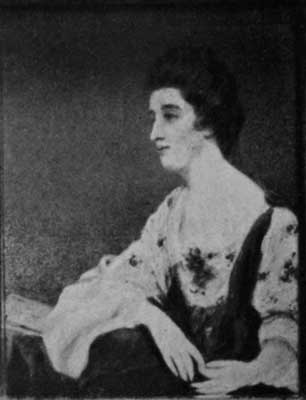
SAMUEL COOPER
As Hilliard has made us familiar with the features of the most distinguished members of the Court of Elizabeth, so, a hundred years later, did Samuel Cooper, that "admirable workman and good company" as Pepys describes him, draw for us on a few inches of cardboard the presentment of the Cromwell family and many of the men and beautiful women who made up the entourage of the second Charles.
Samuel Cooper, in whom, it has been said, the art of miniature painting
culminated, was born in London, in 1609. He came of an artistic stock,
his uncle being John Hoskins, himself a painter of no mean reputation,
as we have just seen. Samuel was instructed by his elder brother
Alexander in the art of limning, and both brothers are reputed to have
been the pupils of their uncle. Be that as it may, Samuel spent much of
his life on the Continent, and was intimate with many of the eminent
men of his day. Pepys frequently mentions the artist in terms of warm
com[Pg 176]mendation. Possibly the fact that he was an excellent musician
endeared him to the amiable diarist, who, under the date "1668, July
10th," says: "To Cooper's, and there find my wife.... And here he do
work finely, though I fear it will not be so like as I expected; but
now I understand his great skill in music, his playing and setting to
the French lute most excellently, and he speaks French, and indeed is
an excellent man." This visit is explained by a previous entry, on
March 29th: "Harris ... hath persuaded me to have Cooper draw my wife's
portrait, which, though it cost £30, yet will I have done." Thirty
pounds in those days was, of course, a considerable sum of money, but
it seems to have been Cooper's usual price for a miniature, as we learn
from the record of another visit to the painter in the pages of the
immortal diary: "To Cooper's, where I spent all the afternoon with my
wife and girl, seeing him make an end of her picture, which he did to
my great content, though not so great as I confess I expected, being
not satisfied in the greatness of the resemblance, nor in the blue
garment; but it is most certainly a most rare piece of work as to the
painting. He hath £30 for his work, and the chrystal and case and gold
case comes to £8 3s. 4d., and which I sent him this night that I might
be out of his debt." Elsewhere Pepys relates visiting the artist's
studio and being much struck with the miniature of "one Swinfen,
Secretary to my Lord Manchester.... This fellow died in debt and never
paid Cooper for this picture.... Cooper himself did buy it [from the
creditors], and give £25 out[Pg 177]
[Pg 178]
[Pg 179] of his purse for it, for what he was to
have had but £30."
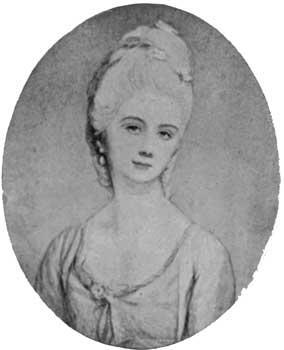
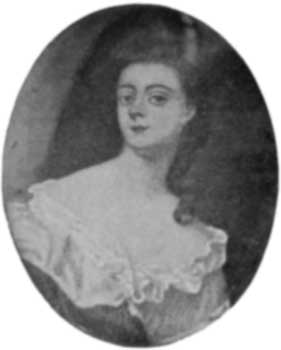
The market value of Cooper's miniatures, however, very rapidly rose. Thus we find Walpole writing in February, 1758, to Sir Horace Mann: "But our glaring extravagance is in the constant high price given for pictures.... I know but one dear picture not sold (this was at Mr. Furnese's auction)—Cooper's head of O. Cromwell, an unfinished miniature. They asked me four hundred pounds for it."
Of this masterpiece, which Cunningham correctly assumes to be "the one mentioned elsewhere as in the possession of Lady Franklin, widow of Sir Thomas, a descendant of Cromwell, of which there is an exquisite copy in the Harley Collection at Welbeck, made in 1723 by Bernard Lens," Dallaway says it is related in the family that Cromwell surprised Cooper while he was copying the portrait and indignantly took it away with him. The original was shown at Burlington House in 1879, being then in the possession of the Duke of Buccleuch. It formerly belonged to Mr. Henry Cromwell Frankland, of Chichester, who inherited it through a daughter of Lady Elizabeth Claypole. The Lady Frankland (not Franklin) mentioned above was the grand-daughter of Oliver Cromwell.
The Protector and his family seem to have been very favourite subjects of the painter. Thus in the Loan Collection of 1865, out of some eighty or ninety miniatures ascribed to Cooper there were no less than seven of Oliver Cromwell, and almost as many of his daughters and of Richard Cromwell. A very[Pg 180] beautiful example is the portrait of Oliver's second and favourite daughter, Elizabeth Claypole, who is said to have upbraided her father for his share in the death of Charles I. and his cruelty in sanctioning the execution of the Royalist agent, Dr. Hewitt. It is signed S. C. 1655 and belongs to the Duke of Devonshire, who also possesses a very fine portrait of the Protector, of which a French critic, M. de Conches, has remarked that Cooper was a man who knew how to enlarge the style of a miniature, and that this particular specimen was as vigorous as oil, perfectly modelled and firm in touch. In the same collection is the profile drawing on paper in pen and brown ink from which Houbraken engraved his portrait. At Stafford House is another portrait of Oliver, and also a very interesting example of the pencil studies from which the artist used to paint his miniatures. It was in connection with this portrait that Walpole gave it as his opinion that "If his portrait of Cromwell could be so enlarged [to the size of one of Van Dyck's pictures], I do not know but Van Dyck would appear less great by comparison." This is the portrait referred to by Walpole above. The Duke of Buccleuch possesses another Cooper of unsurpassed interest—Cromwell's Latin Secretary. This portrait of the poet fully bears out the description of Aubrey, who says that Milton "had light browne haire. His complexion exceeding fayre, oval face, his eie a dark gray. He was a spare man."
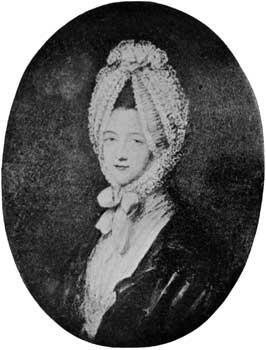
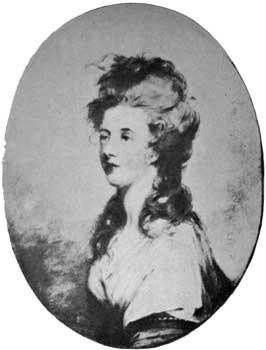
Another characteristic of Cooper's work is that he frequently leaves
his miniatures unfinished, being content, apparently, as soon as he
had seized the[Pg 181]
[Pg 182]
[Pg 183] likeness. It was this peculiarity, doubtless, that
gave rise to Walpole's disparaging, and, it must be contended, unjust
remark that "Cooper, with so much merit, had two defects: his skill
was confined to a mere head; his drawing of the neck and shoulders so
incorrect and untoward that it seems to account for the number of his
works unfinished. It looks as if he was sensible how small a way his
talent extended[!] This very properly accounts for the other [defect],
his want of grace, a signal deficiency in a painter of portraits, yet
how seldom possessed."
As to this latter deficiency, it is very much a matter of opinion. Those who have seen the portrait at Windsor of the Duke of Monmouth when young will hardly be disposed to allow it; indeed, when we have such an amazing power of seizing character, and such breadth of delineation, we can afford to dispense with mere superficial prettiness. And, to return to Walpole's first contention, it is surely unlikely that the artist who could portray such subtleties of character and expression as Cooper did should not have been able to extend his talent "so small a way" as to draw necks and shoulders if he had been so minded.
In the Royal Collection is a head of Charles II., which with another of George Monck, Duke of Albemarle, and that of Monmouth mentioned above, form a trio of portraits difficult to surpass for character and simplicity, although the two last are unfinished. There is, however, no want of finish in the elaborate picture of Charles II., wearing the Robes of the Garter, which belongs to the Duke of Richmond,[Pg 184] and is preserved at Goodwood. It is one of the largest and finest examples of the master, and gives more dignity to that cynical voluptuary than any portrait of him with which I am acquainted.
It has been said that Cooper's portraits of women are inferior to his portraits of men, and, on the whole, I think this must be conceded.
In the Dyce Collection at the Victoria and Albert Museum will be found a series of fourteen more or less unfinished miniatures attributed to Samuel Cooper, and shown with a pocket-book in which they were found, which formerly belonged to Mr. Edwin H. Lawrence.
I have used the word "attributed" advisedly, because several of these miniatures, attractive as they are, seem to me to lack the supreme quality of Samuel Cooper's work. Some, it has been suggested, recall Flatman[3] rather, or, as I think more likely, Dixon. They are in various stages of completion, and show the artist's method of working; well drawn and broadly treated, they are excellent work, and most interesting, technically speaking.
The biographical details to be gleaned of this English master miniature
painter seem to be meagre in the extreme, and still slighter are they
in the case of his elder brother Alexander. I recall two examples of
the latter's work, both in the Royal Library at Windsor; one a portrait
of Sir John King, a highly[Pg 185]
[Pg 186]
[Pg 187] successful lawyer of his day, a favourite
of King Charles II., who intended to make him Attorney-General; but
he died when only thirty-eight, and lies buried in the Temple Church.
Granger says of him: "Such was his reputation and so extensive his
practice that in the latter part of his life his fees amounted to forty
and fifty pounds a day." His portrait is given on p. 141. The other is
of James Stuart, created second Duke of Richmond in 1641. This nobleman
is noteworthy as being one of the four who offered their lives to save
King Charles I.
| R. COSWAY, R.A. | S. SHELLEY. | S. COLLINS. |
|---|---|---|
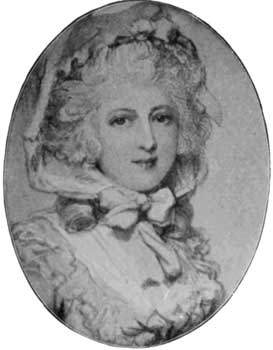 |
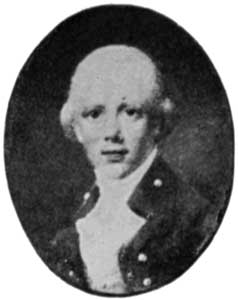 |
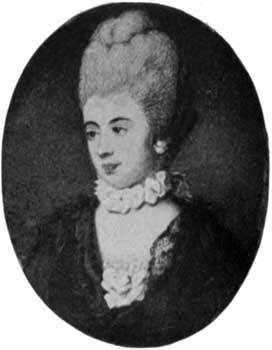 |
| ISABELLE, MARCHIONESS OF HERTFORD. (Meynell-Ingram Collection.) |
PORTRAIT OF A GENTLEMAN. (Miss Kendall.) |
LADY FRANCES RADCLIFFE. (Earl of Carlisle.) |
There is great strength and force of character in the portrait of this staunch Royalist. Technically, however, both pieces are inferior to the work of Samuel Cooper.
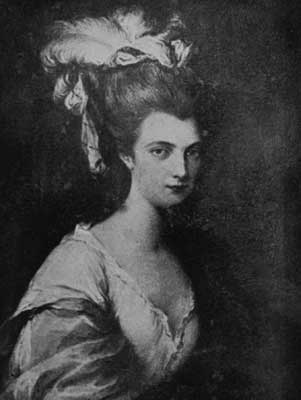
PETITOT
As we saw in a previous chapter, it is to a Frenchman, Jean Toutin, that the credit of applying enamel to portraiture must be given. It may be remarked, in passing, that it is somewhat remarkable that this difficult but beautiful process should come into use just as the older and decorative enamelling fell into decay. Jean Toutin was assisted by pupils, amongst whom one stands pre-eminent, so much so that the fame of the early professors of this art, including that of Toutin himself, may be said to have become merged in the reputation of Petitot, and everything in the shape of a portrait in enamel of that period is commonly assigned, one might almost say without hesitation, to Jean Petitot, very often, it is needless to add, upon the slenderest grounds. We are fortunate to possess in this country a considerable number of examples of the portraiture we are about to discuss. These may be seen and studied in the Jones Collection at the Victoria and Albert Museum. A comparison of them will show how wide are the differences existing between works ostensibly by the same artist, to whom we may now return.
Petitot came of a family of French origin, but was born at Geneva, where his parents, having adopted the reformed religion, had settled. Paul, the father of Jean Petitot, was a wood-carver. His son is thought by some of his biographers, of whom there are several, to have commenced life as a goldsmith and jeweller. We have already seen how close was the connection between the various occupations of goldsmith and jeweller, enameller and miniature painter, and this connection was still existing at the beginning of the seventeenth century, when Petitot was born. We need not stop to inquire precisely into the early stages of our artist's career, but we may gather that he applied himself to an occupation which was the fashion of the time, namely, the enrichment of gems with ornaments, such as flowers and the like, in enamel; and we may safely conclude that he became proficient, for, after a sojourn in France, he came to England when he was about twenty-eight. Arrived in London in 1634 or 1635, Petitot proceeded to show the Court jeweller his work in enamel; this led to an introduction to the King. Charles I., a passionate lover of art, as we know, must have appreciated the artist's ability, since we find that he assigned him an apartment in the palace at Whitehall.
By great good fortune, the young Petitot had the advantage of the
protection of a Genevese, physician to the King, and a celebrated
chemist, Sir Turquet de Mayerne. Such a patron and colleague must
have been of the utmost assistance to our artist in this stage of his
career, since he was able to further his chemical researches, and aid
him[Pg 195]
[Pg 196]
[Pg 197] in experiments in vitrification which resulted in the painter's
palette being much enriched and his methods perfected. I may remark, by
the way, there is a very characteristic portrait of Sir Turquet, after
Rubens, at Hampton Court.
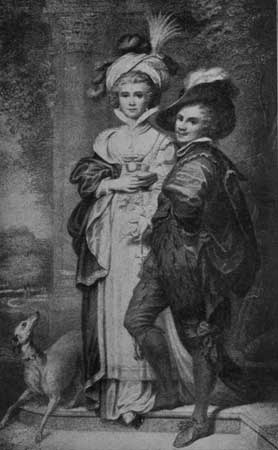
But, in addition to the scientific help which Petitot's countryman was able to afford, the artist enjoyed the advantage of instruction from the King's chief portrait painter, Sir Anthony Van Dyck; and it is significant of the close relationship which probably existed between the two artists that the copies which Petitot made from the great Fleming's work are esteemed as amongst his most exquisite productions, combining grace and freedom with marvellous exactness, in spite of the minuteness of the scale. It is one of these copies of Van Dyck, namely the whole length of Rachel de Rouvigny, Countess of Southampton, that Horace Walpole does not hesitate to call "indubitably the most capital work in enamel in the world.... It is nine and three-quarter inches high, by five and three-quarter inches wide, and though the enamel is not perfect in some trifling parts, the execution is the boldest, and the colouring the most rich and beautiful that can be imagined. It is dated 1642."
He also mentions a portrait of Buckingham, painted about the same time.
Three years later we find Petitot arrived in Paris, led to take refuge in France, there can be little doubt, by the troubles which attended the outbreak of civil war in this country. He was favourably received by Cardinal Mazarin, and seems to have established[Pg 198] himself at the French Court with the same facility that he had done in the case of the English Court, as we find him installed in the Louvre and in receipt of a pension from Le Grand Monarque.
The portraits of Louis XIV. by Petitot may be termed almost innumerable, for reasons which I hope to show by and by.
Five or six years after his return to France he married Madeleine Cuper, and a certain Jacques Bordier, of whom more anon, married her sister Margaret.
The brothers-in-law worked together for many years, Bordier being responsible for the draperies and backgrounds of the portraits and Petitot for the exquisite details of the features. This art partnership lasted until the death of Bordier, in 1684. Petitot remained in Paris till 1687, a period of forty-two years. He would have quitted France earlier, namely at the revocation of the Edict of Nantes, in 1685, but Louis was clearly unwilling to part with him. The King shut up the painter, whose Protestant origin we have already mentioned, in Fort l'Evêque, and sent the eloquent Bossuet to convert him. To regain his liberty "he signed like the rest," and escaped to Geneva. By this time the artist was in his eightieth year, but his powers of vision and the cunning of his hand appear to have been unabated. At any rate, he was overwhelmed, we are told, with commissions, and retired to Vevey to escape the importunity of his patrons. He lived four years longer, and was carried off by a sudden illness in a day, "as he was painting his wife," says Walpole.
R. COSWAY, R.A.
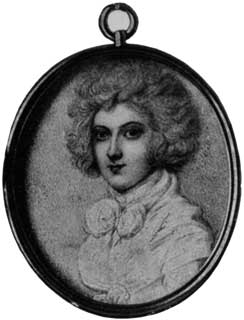 |
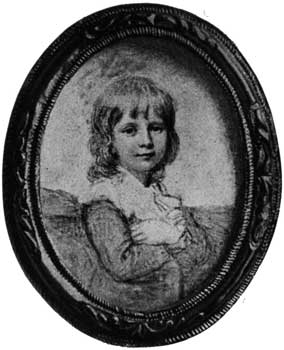 |
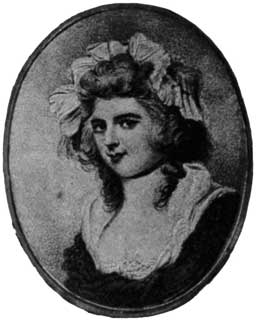 |
| LADY CAROLINE HOWARD. (Earl of Carlisle.) |
WILLIAM, FIFTH DUKE OF DEVONSHIRE. (Earl of Carlisle.) |
LADY HORATIA SEYMOUR. |
|---|
A mention has been made of Bordier as Petitot's brother-in-law; and I may here point out that according to Monsieur Reiset, the compiler of the catalogue of the Louvre, there were two Bordiers who worked with Petitot in England, namely Jacques, to whom reference has already been made, and Peter Bordier. I do not know that there is much to be learned about these collaborateurs of Petitot, but of the two Peter seems the better known, and is indeed reputed to have been the master of Petitot. He remained in England after Petitot left it, and painted for the Parliament a memorial of the Battle of Naseby, which was presented to Fairfax. It was in the shape of a watch. Walpole purchased it from the collection at Thoresby, whither it came from the executors of the famous Roundhead general. It will be found fully described in the "Anecdotes of Painting."
Apropos of the Bordiers, I may mention that Petitot had a very large family, namely, eight daughters and nine sons; but only one, so far as I know, namely Jean, who is known as Petitot le fils, displayed anything of his father's artistic talent. This younger Petitot was patronised by our King Charles II. He was born in 1650, settled in England, and married Madeleine Bordier, the daughter of his father's colleague. He died in London, and after his death his family removed to Dublin. His work was distinctly inferior to his father's, both in colour and in finish. The Earl of Dartrey, who possesses a number of enamels, has amongst his valuable collection "Petitot le vieux par luy mesme," also "Petitot fils and his wife." The two latter are inscribed as[Pg 202] follows: "Petitot fait par luy mesme d'age de 33 ans 1685." "Petitot a fait ce portrait à Paris en Janvier 1690 qui est sa femme."
Another son of the elder Petitot rose to be a Major-General in the British Army.
Besides the younger Petitot, a number of imitators and copyists of the elder may be named. Amongst these were his contemporaries Perrot and Chatillon, the engraver. Then there is Jacques Philippe Ferrand, who studied under Mignard; he was a member of the Academy and a valet-de-chambre to Louis XIV. His father, Louis Ferrand, had been physician to the preceding monarch. At a later date we find Mademoiselle Chavant, who painted at Sèvres at the end of the eighteenth century; Moïse Constantin, who was an enameller, and also painted on porcelain. He was a Genevese, but lived at Paris, and was painter to the King, 1726-8. Four more Genevese, also enamellers, may be named, all of whom painted copies of Petitot, namely, Alexandre de la Chana, Dufey, Lambert, and J. G. Soutter.
When we come to know of all these imitators or followers of Petitot,
we begin to understand the enormous quantity of work attributed to him
by the uninitiated; but difficult as it may be for the unpractised eye
to discriminate, there may very well be a large number of works which
are from the hand of Petitot himself, because, as we have seen, he
spent a long and laborious life, and there was in his time a demand
for this particular kind of portraiture far in excess of anything like
modern requirements. That demand arose from the use of these enamel
portraits[Pg 203]
[Pg 204]
[Pg 205] for snuff-boxes, which were then so largely employed, not
only for personal use, but as diplomatic presents. The amount of taste
and labour bestowed upon these objects may be realised by those who
will study the Le Noir Collection at the Louvre, the many fine pieces
at the Victoria and Albert Museum, and last, but not least, those shown
at Hertford House. They were, of course, extremely expensive, and
such was their artistic charm that we do not wonder at people making
a hobby of collecting them. Thus, we are told, Frederick the Great
owned 1,500 snuff-boxes; then there was the Comte de Brieulle, the
favourite minister of the King of Saxony, who was said to have owned
300 costumes, with a walking-stick and snuff-box appropriate to each.
This was the nobleman of whom Frederick the Great remarked that he had
"tant de perruques et si peu de tête."
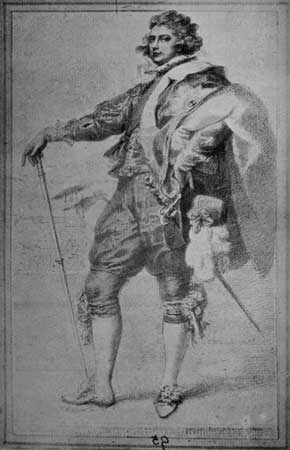
These boits aux portraits were in fashionable use during the seventeenth and eighteenth centuries. We have seen how Louis XIV. employed Petitot as far back as 1645, and we read of a portrait of Louis XVI. when Dauphin being sent to Marie Antoinette on her arrival in 1770. The picture was by P. A. Hall, the most distinguished miniaturist in France, and cost 2,664 francs. The box in which it was mounted contained seventy-five brilliants, costing over seventy-eight thousand francs, or nearly thirty times as much. The production of portraits for these snuff-boxes assumed the proportions of a manufactory at the French Court during the eighteenth century; thus the archives of the Ministry of Foreign Affairs contain entries showing that enamel portraits were[Pg 206] made by the dozen, and one Bruckmann, a Swede, supplied as many as nineteen at a time.
I may mention with regard to the illustrations of Petitot here shown that the portrait of Cardinal Richelieu is mounted in a lovely chased gold and jasper snuff-box, which once belonged to the King of Saxony. The Louis XIV. is also upon a snuff-box. The Cardinal Mazarin comes from the Earl of Carlisle's celebrated collection at Castle Howard.
The Charles I. on a preceding page was at Strawberry Hill, and Walpole thus speaks of it: "I have a fine head of Charles I., for which he probably sat, as it is not like any I have seen by Van Dyck. My portrait came from one of his [Petitot's] sons, who was a Major in our service, and died a Major-General at Northallerton 1764." This now belongs to the Burdett-Coutts Collection, as does the Charles II., the extremely fine James II., and also, I may remind the reader, the lovely Henrietta, Duchess of Orleans, perhaps the most beautiful of all his works, and reproduced on p. 151.
A few words may be said in conclusion as to the painter's method. He
is reported to have generally used plates of gold or silver, seldom
copper, for the foundation of his miniatures. His signed works are
excessively rare. The Duke of Buckingham, dated 1640, to which I have
already referred, is signed, however, and in the Louvre there is an
example bearing a date, but these are exceptions. The beautiful borders
which, in the shape of wreaths of enamelled flowers, are to be met with
around his works, such[Pg 207]
[Pg 208]
[Pg 209] as that in the Jones Collection, for example,
are the work of Jules Legarré, goldsmith to the King, with whom there
is little doubt Jean Petitot must have worked in the execution of
commissions for the Court.
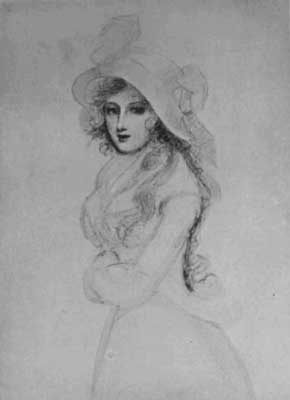
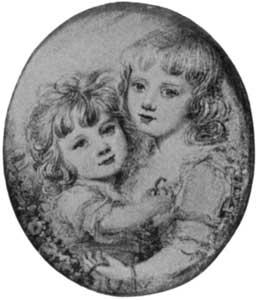
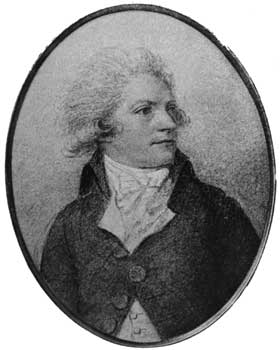
A. PLIMER.
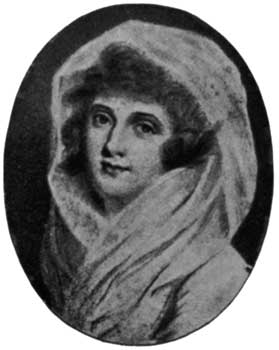
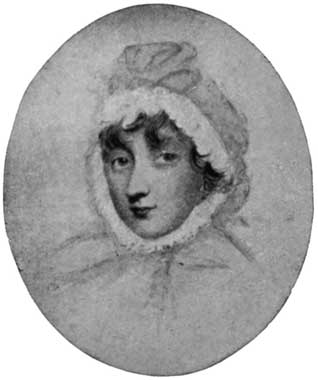
SOME GEORGIAN ARTISTS
It is a hundred years from the death of Samuel Cooper, which was in 1672, to the time when Cosway, Smart, and Humphrey may be said to have established their reputation as miniature painters of the first rank. Thus Richard Cosway was elected Royal Academician in 1773, and Ozias Humphrey, having made his start in life and obtained Royal patronage, set out the same year with Romney for Italy. Five years later John Smart was made Vice-President of the Incorporated Society of Artists.
This century, it will be observed, takes in the whole of the early Georgian period; and it is a time of great dearth and barrenness in our subject, indeed, of art generally, in this country. When the three distinguished artists I have just named, Petitot and the two or three good enamellers we had, such as Meyer and Moser, whom I have dealt with elsewhere—I say, when these names are excepted, practically none of the first importance remain.
Lawrence Crosse (1724-1784), with his somewhat heavy and insipid style, his fondness for blue[Pg 218] drapery—so well shown in the Duke of Portland's Collection—and the Lens family, with their somewhat puzzling personality, may be named. There was also some good work done by stray artists like Gaspar Netscher, whose rendering of the imperious Sarah Jennings from the collection of Mr. Charles Butler I give on p. 177. Then there was the eccentric Jean Etienne Liotard, who was born at Geneva in 1702 and died there in the first year of the French Revolution. He was an artist of great ability, but of somewhat irregular habits and uncertain methods of work, and was known in Paris as "le Turc."
Oriental costumes had a fascination for him, and some of his finest drawings are of figures in flowing Eastern robes. Walpole criticises him and says his likenesses were as exact as possible; Sir Joshua Reynolds seems to have been jealous of him and sneers at his style. Probably his best work was in pastel. He was patronised by Maria Theresa, and by Royalty in this country. The Museum at Amsterdam has of late years been enriched by several examples bequeathed by descendants. I confess to finding great charm in his work; so far as I know, he is unrepresented in our National collections, except by some drawings in the print-room of the British Museum. In the Salle des Dessins at the Louvre, however, is a striking full-length figure of a woman in Russian costume; and the Bessborough family possess works by him, he having met the Earl of Bessborough of his day at Constantinople and enjoyed that nobleman's patronage.
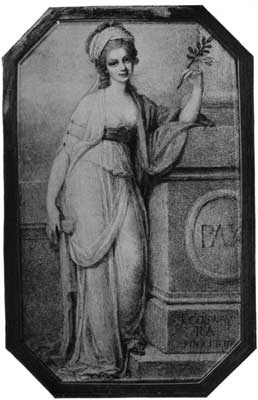
I give examples of two excellent English artists of this period whose work is very pleasing without being, perhaps, of the first rank, viz., James Nixon, born within a year or two of Ozias Humphrey—that is, in 1741 (his Miss Kitty Mudge is marked by great refinement); and Samuel Collins, whose Lady Frances Radcliffe is shown on p. 185; he was the master of Humphrey, and enjoyed a great reputation at Bath, which he took with him to Dublin.
In much the same category as the two foregoing may be placed Samuel Shelley, though personally I prefer Collins and Nixon, as Shelley's drawing is often defective, not to speak of other faults, traceable, no doubt, to his origin and want of training—for he was a self-taught genius, born in Whitechapel, in 1750. He is said to have founded his style upon that of Sir Joshua Reynolds; if so, he fell very far short of his master. He devoted much time also to female subjects, treated allegorically, such as "Chastity," which was engraved. His book illustrations are reckoned inferior to his miniatures. Some examples of his work may be seen at the Victoria and Albert Museum.
The number of miniature painters of about the calibre of Shelley who belong to this period—that is to say, the latter half of the eighteenth century—is so great that I can, in a chat about miniatures, only mention a few of them.
The William Derby whose attractive portraits of Lady Elizabeth Hamilton and the Duchess of Hamilton adorn these pages was a Birmingham man, probably best known by his drawings for[Pg 222] Lodge's "Portraits of Illustrious Personages." He was assisted by a son, who lived until 1873. The work of the elder was marked by great care and minuteness. He copied all the family portraits for the Earl of Derby, and was a frequent exhibitor at the Academy and elsewhere.
The Lady Elizabeth Hamilton, shown on p. 189, was daughter of the sixth Duke of Hamilton; the Duchess of Hamilton is, of course, Elizabeth Gunning, Duchess of Hamilton and afterwards of Argyll, one of the two famous Irish beauties who took the town by storm in "Horry" Walpole's time, and whose career has been so often narrated.
I also give her sister, Maria Gunning, who became Countess of Coventry, and died an early victim to cosmetics.
No doubt, it has often occurred to my readers that there ought to be a British national collection of miniatures. It is a reproach that none such exists. Miniature painting is a branch of art which has been flourishing amongst us for three centuries at least, and it has been carried to great perfection; no country can show more beautiful work of the kind, and in the number, as well as in the charm, of its miniatures England is unsurpassed. Yet no attempt has ever been made to procure a permanent collection. Had such efforts been made, say even a generation ago, examples might have been obtained at prices vastly below what would have to be paid in order to acquire them nowadays, and many precious works might have been secured.
As we all know, the sums realised by fine minia[Pg 223]
[Pg 224]
[Pg 225]tures, especially of
ladies, and by men like Cosway and his pupils the Plimers, by Smart or
Engleheart, to say nothing of historical works by Hilliard and Samuel
Cooper, are enormous. Such a national collection would be attractive
and instructive in the highest degree—attractive to lovers of art and
history, instructive to students, who could hardly fail to benefit
by the study of such work as might have been, long ere this, brought
together, whilst the miniature painters of our day clearly stand in
need of such artistic training. Finally, let the collector try to
realise what valuable opportunities such a collection would afford
for the comparison of style, for identification, and for instruction
generally in this fascinating subject.
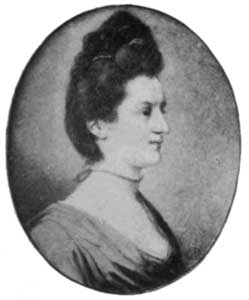
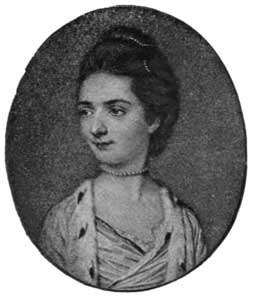
J. SMART.
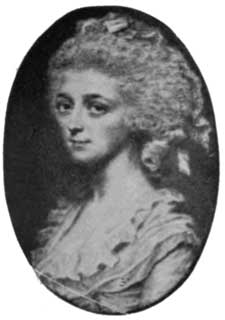
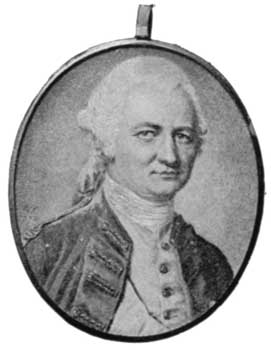
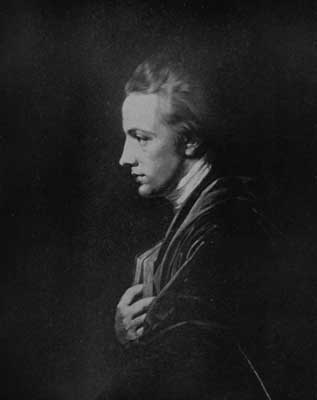
RICHARD COSWAY
Probably there is no one miniature painter whose name is so familiar to the general reader as that of Richard Cosway, there is no one whose works in this particular branch of art are more admired, no one more frequently copied, and, as a consequence, no one whose miniatures or alleged miniatures are to be found in so many British collections as "Maccaroni Cosway," as he was called in his day. Maccaroni, you remember, was a name given to "dandies" about the last quarter of the eighteenth century.
Sticking a huge feather in his hat, disporting himself in a mulberry coat with scarlet strawberries, displaying himself at sale-rooms and other places of public resort—these and such-like doings were delights to this diminutive, vain, and eccentric artist.
In his "Lives of Eminent British Painters" Allan Cunningham closes a long account of Cosway in[Pg 232] these words, "His works are less widely known than they deserve, and his fame is faded." In the light of the present day, and the annals of the auction-room, that statement is one which can by no means be admitted. It may, on the contrary, be safely asserted of Richard Cosway that his fame, whatever it may have been in the days of Allan Cunningham, so far from fading, has been steadily increasing, until it has reached a pinnacle of the highest reputation—that is, if the pecuniary test be applied. But whilst this is true, it may also be conceded that of late a more just appreciation of the relative merits of Cosway, as compared with some of his contemporaries, has been made by the impartial and discriminating critic; by which I mean it is not so much that Cosway has become less famous, but that others, such as George Engleheart and John Smart, for example, have received proper recognition, and all the finest works of the period are no longer assigned, as a matter of course, to Cosway, as it may be said was at one time the case.
The eccentricities of Cosway as a man, his diminutive appearance,
and extravagance of attire, made him a conspicuous object wherever
he went. His extravagance of living, his vanity and ostentation,
excited jealousy and ridicule; but, whilst fortune smiled on him, he
could boast of his friendship with the Prince of Wales, and lavishly
entertained the rank and fashion of his day. He was, according to the
gossip of J. T. Smith, in his "Life and Times of Nollekins," "one
of the dirtiest of boys." This amusing but sometimes ill-natured
writer says that[Pg 233]
[Pg 234]
[Pg 235] Cosway was employed as a waiter to the students
at Shipley's well-known drawing school, and used to take in the tea
and coffee for them. Inasmuch as his father was Master of Blundell's
School, Tiverton, it seems improbable that the young Cosway would have
been placed in such a menial position at Shipley's. That he was a
student there we know, as he was also in the studio of Thomas Hudson,
a mediocre artist, best known as the master of Sir Joshua Reynolds,
and, like the President of the Royal Academy and Cosway himself, also a
Devonshire man.
G. ENGLEHEART.
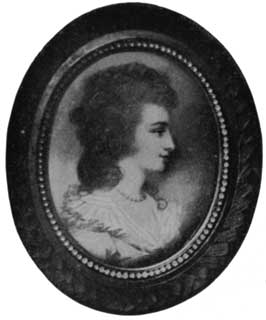
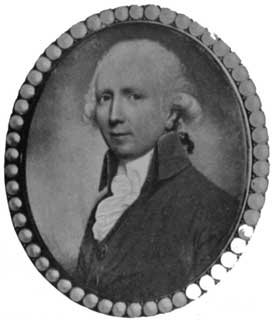
Cosway must have come to London when of very tender years; for in 1755, being then only thirteen years old, he won a premium of fifteen guineas of the then newly constituted Society of Arts, for the best drawing of any kind by boys and girls under fourteen, and this promise of early success was followed by his being elected Associate of the Royal Academy when only twenty-nine, and full member two years later. The hard work that he went through in his early training, joined, no doubt, to what must have been natural facility of execution, gave him astonishing rapidity in his work, as to which Cunningham has observed: "He often finished miniatures at three sittings of half an hour each, and when he sat down to dinner would boast that he had despatched during the day twelve or fourteen sitters."
If this boast be even approximately true, he must indeed have been a prolific artist, and his annual production of miniatures be reckoned by the thousand. That there must be a vast number extant we may[Pg 236] safely conclude when we remember the facility to which we have just referred, and the fact that his earliest contributions to the Academy were made when he was only twenty-six, and that he worked until half a century later, for he was eighty when he died.
But if, then, the existence must be allowed of an enormous number of miniatures by Cosway, to say nothing of those by his wife, of whom I shall speak later, what shall I say of the countless forgeries of this the most popular of all English miniature painters? What was the case in his day I do not know, but I am sure that there must be a never-ending host of copyists at work now, who devote themselves particularly to imitating the works of Cosway and his contemporaries. And here I cannot refrain from telling a little story apropos of what happens to these copies. It was told me by an artist who was present at an auction in certain well-known sale-rooms with a friend. By and by some so-called Cosways were put up and fetched very high prices, whereat the acquaintance expressed great satisfaction to my artist friend, and, in a burst of confidence said, "You know, I painted them myself."
Well-known historical characters, such as the Pompadour, Madame Du Barry, Marie Antoinette, the First Napoleon, the Empress Josephine, Madame Vigée le Brun, and the rest, whose name is legion, these are the favourite subjects of the copyist.
The late Dr. Propert, who owned a large collection himself, of by no means uniform quality, speaks feelingly on this subject. He says: "I am sorry to say[Pg 237] that the French hold an unenviable pre-eminence for the production of spurious enamels and miniatures. It is really of some danger to attempt a collection of French specimens; many at once, no doubt, display the cloven hoof clearly enough to warn off even a novice, but I have seen some which would puzzle an expert. If any of these enterprising gentry get hold of a really old miniature, it matters not how time or exposure to light may have wrecked the once beautiful tints, the merest ghost suffices them; they will restore and paint it all over again with a subdued palette, and, like new wine artificially aged by the arts of the chemist, it presents itself in a guise which will take no denial."
This subject is one of very great importance to the collector, upon whose credulity the forgers appear to be able to reckon to any extent, and it is really remarkable the way in which people, who should know better, will bring out from their cabinets works to which they do not hesitate to attach some of the most eminent names to be found in the annals of the art of miniature painting. If only they have picked them up themselves, that appears to be one of the chief recommendations and guarantees of authenticity. It is the delight in a bargain, or what they are pleased to think is a bargain, that appears to have such a fascination for generation after generation of collectors. That this evil—for as such I regard it—is ever on the increase may be concluded from the fact of the increasing number of bric-à-brac shops in which one sees these forgeries displayed. I do not know what their owners say[Pg 238] about these so-called old miniatures, and I do not wish necessarily to cast any stigma upon the vendors. I might go farther, and say that very often it seems as if the purchasers did not want to know the truth about these works. They like to think that their own astuteness and sound judgment, their sharp eye and keen nose for a bargain have enabled them to "pick up" (that is their favourite word) these treasures, upon such favourable terms, and to enrich their collection with gems which, unaccountable as it may seem, have quite escaped the notice of the general public and of the common or ordinary collector.
Talking of collections, it may be observed that Cosway himself was a great collector. His house, No. 1, Stratford Place, was full of costly works of art, of silks, china, and gems of bijouterie and vertu, in which he trafficked and dealt, and his wife, Maria, fully shared the painter's taste. I may here say something about this lady, who was in many ways a remarkable woman.
She was the daughter of an Irishman named Hadfield, who was an
innkeeper at Leghorn. Maria was born in Florence, in 1759, and lived
to be nearly as old as her husband. After studying art in Rome, she
came to England, where she took up miniature painting as a profession.
Her first contributions to the Royal Academy were in 1781, in which
year Cosway married her, she being then twenty-two, of a blonde type
of beauty, with soft blue eyes. She practised art in various forms.
At Hardwicke, in the collection of the Duke of Devonshire, there is
a really fine picture painted by her of the beautiful duchess[Pg 239]
[Pg 240]
[Pg 241] as
Cynthia, full length, in oils, life size. Allan Cunningham observed of
this picture that when it was exhibited there was no little stir. The
likeness was excellent, and its poetic feeling not unworthy of the poet
(Spenser) whose work inspired it. At Longford Castle the Earl of Radnor
has a full length, also in oils, of a lady of the family.
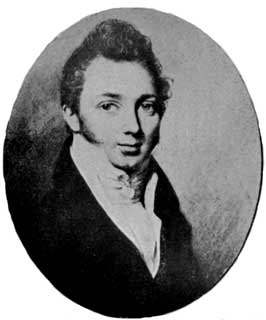
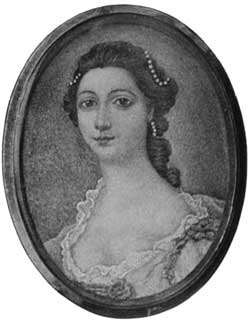
As to her miniatures, Cunningham says: "Almost the first time she was seen in public she was pointed out as the lady who had painted some of the most lovely miniatures in the Royal Academy," and he adds, "her reputation was made at once, for nothing was talked about but the great youth and the great talent of Mrs. Cosway. One half of the carriages that stopped at her husband's door contained sitters ambitious of the honours of her pencil." He says that the painter was too proud a man to permit his wife to paint professionally. But inexorable though he was in regard to painting, "he was more gentle in the matter of music, of which Maria was passionately fond, and he had a handsome house and good income and allowed her to indulge in those splendid nuisances called evening parties."
With a character so full of vanity and weakness as Cosway's was in some respects, it is not surprising to learn that, after twenty years of married life, incompatibility of temperament, as the phrase goes, developed between this ill-assorted pair, and at the beginning of the last century Mrs. Cosway was separated from her husband. In 1804 she retired to a religious house at Lyons, Cunningham says "owing to the death of her daughter." She was in London as[Pg 242] late as 1821-2 selling her deceased husband's property, old miniatures and so forth, for Cosway had died whilst taking the air in 1821. Her final visit to England was in 1829, on a similar errand. She then retired to Italy, and founded a college at Lodi, near Milan, which grew into a religious house in connection with the order known as the Institute of the Blessed Virgin Mary, and here she died, in 1838.
She was known as the Baroness in Italy, the Emperor Francis of Austria having granted her a title. There is no doubt that Maria Cosway was a versatile and amiable woman and an artist of considerable ability. Although at one time separated from her husband, she nursed him in his declining years.
As to his character, Andrew Robertson, the miniature painter, although he terms him "the vainest creature in the world," says, "To me he behaved in the most liberal way"; and we have the valuable testimony of Ozias Humphrey, who was a rival miniature painter, that he was "the kindliest of friends." Another contemporary, William Hazlitt, says he was "bright and joyous." His pupil Andrew Plimer speaks of him as "my beloved master"; and, finally, we have the testimony of his wife, that he was "toujours gai."
Before leaving Cosway a few remarks may be offered upon his technique.
One of the first characteristics of his style is what has been termed
a certain hothouse lusciousness. Although the bulk of his work
consisted of portraits from life, whether it was that he did not
attempt to[Pg 243]
[Pg 244]
[Pg 245] make likeness a strong feature, or whether he could not
help exaggerating the delicacy of his sitters' complexions, the size
of their eyes, and giving them an air of artificiality, or whether it
was the extreme rapidity of his method (he used, as we saw, to boast
of having painted several portraits in a day)—whether it be to one or
all of these reasons that we must attribute the style of Cosway, there
it is, and so marked is it that, generally speaking and in the case
of fine examples, at any rate, one cannot mistake it. The treatment
of the hair is marked by breadth and peculiar freedom of handling,
the backgrounds are commonly, but not always, an ultramarine blue
(especially his early ones). The foregoing remarks apply to Cosway's
miniatures upon ivory, but, as is well known, he by no means confined
himself to those. Some of his most pleasing work took the form of
full-length figures drawn in pencil with a very slight background, the
draperies lightly drawn, but the face carefully finished, of which the
George IV., given on p. 203, is a fine example. He also painted in oils.

The Plimers.
Amongst the many surprising vicissitudes of the auction-room, the enhancement in value of the works of two of Cosway's pupils may here be mentioned. I refer to the prices that have been paid within the past few years for works by the brothers Andrew and Nathaniel Plimer (or Plymer, as the name is sometimes spelled). That the miniatures of these men, of whom Andrew was much the better artist, are pleasing—indeed, have something of the charm[Pg 246] of Cosway—cannot be denied, but they are less well-drawn than his, the eyes, particularly, being exaggerated in size; the execution of the hair is certainly inferior to Cosway's, being stiff and wiry. In spite of this inferiority—which, I think, is apparent upon a careful comparison—miniatures which, a few years ago, could be bought for a few pounds now fetch as many hundreds. Despite some early struggles, I do not know that there is very much that need be said about these painters, beyond this posthumous rise in the value of their works. Redgrave, in his "Century of Painters," does not even mention them. In his "Dictionary of Artists" less than twenty lines are devoted to them.
The Plimers were born at Wellington, in Shropshire, where their father was a clockmaker, Nathaniel in 1757, Andrew, the younger, six years later. The elder brother exhibited at the Academy from 1787 to 1815, and died in 1822. Andrew contributed from 1786 to 1810 and again in 1819.
He died at Brighton, in 1837, aged seventy-four. In the obituary of the Gentleman's Magazine he is described as being, many years ago, an eminent miniature painter in Exeter.
A charming portrait of him by Geddes now hangs in the Scottish National Gallery.
There is a well-known group of three young girls, daughters of Sir John Rushout, sometimes called the Three Graces, on which much of Andrew Plimer's fame may be said to rest. It was sold with a lot of worthless odds-and-ends at a sale at Marlow Place, Great Marlow; the bidding began at half a crown,[Pg 247] and left off at £315. The miniature was purchased, with others, from Mr. E. Joseph's collection for a very large sum, and has now gone, I believe, to New York.
John Smart.
The mention of the enhancement of price which has been of late years witnessed in the case of eighteenth-century miniatures instinctively recalls the name of John Smart, who was born at Norwich in the same year as Cosway was born at Tiverton, namely, 1740. He must have been precocious, for he gained the Society of Arts premium when only fifteen. It was as a student at Shipley's, no doubt, that he made the acquaintance of Richard Cosway, and they became friends, the latter artist terming Smart, in letters, "little John," "faithful John," and so forth.
Smart became a fashionable miniaturist of his day, and, like Humphrey, went to India, where he remained five years. His son John followed his example in 1808, but died in India the following year. The portraits of Lord and Lady Clive given in this volume, belonging to the Earl of Powis, are probably due to Smart's visit to the East. His work in India may be identified by the letter "I" which is attached to his signature. He was a large contributor to the Exhibition of the Incorporated Society of Artists, of which he was made Vice-president.
I may remark, in passing, that an excellent, but little-known painter and somewhat eccentric character, namely, George Chinnery, R.A., also spent a great[Pg 248] deal of time in the East Indies, where he practised his art for nearly fifty years, dying at Macao. There is a portrait of him in the National Portrait Gallery, painted by himself.
It would be difficult to over-praise the truth and beauty of Smart's work, although Cosway termed him "slow, and a bit washy." The last epithet sounds almost ludicrous to those who are familiar with Smart's manner of painting, which is finished almost to excess, and often resembles an enamel in appearance. Indeed, I possess a fair-complexioned man's head by him which might at first sight be taken for an enamel, so smooth is it in execution. But the absolute truth of the flesh-tints, scrupulous accuracy of the drawing of the features, and the harmonious beauty of the whole, make it a work of the highest art in its way, placing the artist in the very front rank of miniaturists. Moreover, these qualities distinguish all Smart's best work, and stamp him, in my opinion, as a greater artist than Cosway.
Ozias Humphrey.
By the "cognoscenti," doubtless, the merit of Ozias Humphrey is
recognised, but I think it may be safely said that by the general
public his ability is certainly not estimated at its true value. Merit
is, in fact, an inadequate term for the admirable draughtsmanship
and beautiful colour of this true artist. The refinement, the
self-restraint and sobriety of his work, the unobtrusive, careful,
thorough finish, are perhaps those qualities most likely to escape the
casual observer. For my own part I incline to place him in the front[Pg 249]
[Pg 250]
[Pg 251]
rank of English miniature painters, and amongst the very finest of them
all. He may not have the luscious sweetness of Cosway at his best,
but he is more uniformly excellent. His technique is far superior to
the over-rated Plimer and is free from the mannerism and enamel-like
smoothness of Smart.
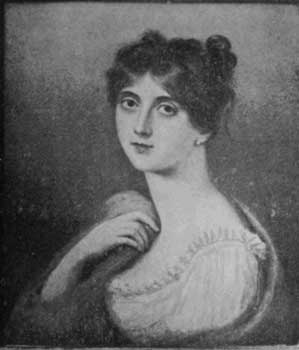
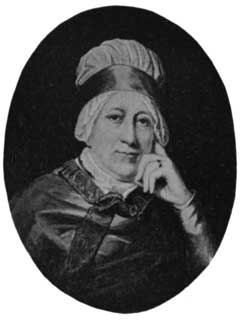
Humphrey worked in India for rather less than three years—from 1785 to 1788; but ill-health forced him to return to England. In the British Museum is preserved a note-book containing memoranda by him and a few sketches; amongst other interesting entries by his own hand are particulars of portraits which he executed for Indian princes and Anglo-Indians. These show the prices he obtained. Thus, for the Governor-General he obtained 1,000 rupees; for Mrs. Sturt, 700; for Mrs. Hewitt, 1,000; for Miss Blair and Mrs. Keighley, 532 each; 1,000 for a whole length of Mrs. Trevor. In 1786 he was owed 6,600 rupees by native princes.
Ozias Humphrey was born at Honiton, in 1742. Probably his West Country origin had something to do with Sir Joshua Reynolds's friendship for him, and it was by the President's advice that he studied in the St. Martin's Lane School. After two years in London he returned home, owing to the death of his father. He then was placed under Samuel Collins, the miniature painter, at Bath, and lodged with Lindley, the musician.
Here, as a child, the future Mrs. Sheridan, the lovely original of Sir Joshua's Saint Cecilia,
was wont to sing to Humphrey. Pecuniary difficulties drove Collins from Bath, and he established himself in Dublin, whereupon the young Humphrey, who was then but twenty-two, returned to London and settled in King Street, Covent Garden, not far from his patron, Sir Joshua Reynolds.
A purchase by George III. from an exhibition in Spring Gardens, two years later, was probably the commencement of Humphrey's success, and led to the King commissioning him to paint his Consort and members of the Royal Family. At Windsor, by the way, are three notable and beautiful miniatures by him of Queen Charlotte, all after Gainsborough, two of them representing her as quite young and not a little attractive. In one of them the likeness to an eminent living member of the Royal Family is very marked.
Doubtless Humphrey had ambition as an artist, and, accompanied by George Romney, he went to Italy in 1773, as all who could afford it did in those days.
Cumberland, the dramatist, celebrated the event by some indifferent verses; of the miniature painter he says:
Romney returned sooner than Humphrey; a coolness sprang up between
them, as to which Allan Cunningham makes Humphrey to blame, and rather
ill-naturedly remarks that he was "a gossip and an idler." The same
critic has observed that he, Hum[Pg 253]
[Pg 254]
[Pg 255]phrey, used to call and read the
newspaper to Sir Joshua Reynolds, when, in his declining days, the
great painter's eyesight failed—a misfortune destined to overtake the
miniaturist himself a few years later.
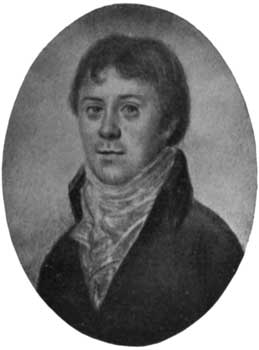
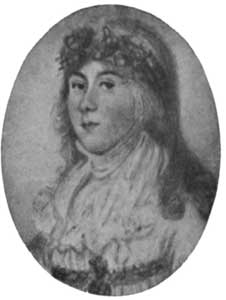
After a four years' sojourn in Italy Humphrey returned to London and essayed oil-painting, exhibiting whole-lengths in the Academy, but without much success. Miniature painting was his forte, especially also the copying of other men's work in small, and at Knole may be seen many works of this nature.
George Engleheart.
Some ten or twelve years later than the three eminent miniature painters we have been discussing was born George Engleheart, whose best work may often be placed almost on a level with theirs, but not always. He frequently exaggerates the eyes in his ladies' portraits, and his colour is often not agreeable, the flesh tints in his men's pictures being especially sallow. Engleheart, who lived at Kew, was of Silesian origin; he was a pupil of Sir Joshua Reynolds, and when only thirty-eight was made miniature painter to King George III., with whom he was a favourite. His fee book discloses that he must have painted nearly 5,000 miniatures, as he painted assiduously between 1775 and 1813, in some years finishing more than 200 per annum. He contributed to the Academy for nearly forty years.
For fidelity of likeness and sound workmanship I should incline to give preference to the male[Pg 256] portraits of Engleheart, of which the example shown on p. 233 is a fair specimen.
Five thousand miniatures by one artist alone, of the fair women and brave men of his day, and how many of them are to be seen in our national collections?
At Hertford House, a solitary one, an unknown lady in a white head-dress; in the National Portrait Gallery, not one; at Kensington, three or four, and those not of superlative quality by any means, the excessive size of the head compared with the figure being a marked defect in two of them.
Three Miniatures of the Cobden Family.
Mrs. Cobden Unwin enables me to reproduce in this volume three miniatures of the Cobden family. The father of Richard Cobden, the statesman, was William Cobden, of Dunford, Heyshott, Midhurst, Sussex. He was born at Dunford on September 30, 1775, and died at Droxford, Bishop's Waltham, Hants, on June 15, 1833. The miniature of him here reproduced is by W. Dudman. Dudman was a contributor to the Royal Academy of 1797, and it is possible that this miniature was his sole contribution, since it bears an inscription on the back in Latin to the effect that it was "out of the Royal Academy." Now, inasmuch as he exhibited but once, and that occasion was the same year as the date of the inscription I have just quoted, it seems to demonstrate that this was the identical miniature shown that year, although the name is not given in the catalogue.
William Cobden married Millicent Amber, whose[Pg 257]
[Pg 258]
[Pg 259] portrait in her
wedding dress is also here given. The painter of this is unknown, but
the picture is very probably the work of Dudman, the two miniatures
being much alike in colouring and treatment. Mrs. Cobden predeceased
her husband by some eight years, dying at West Meon in Hampshire in
1825, aged 49.
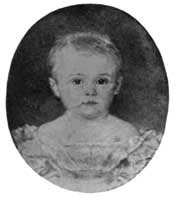
The other member of the Cobden family whose portrait is given here is Richard Brooks Cobden, the son of the statesman. He was born at Manchester in 1841, the year his father was elected member for Stockport, in the very midst of the Anti-Corn-Law League agitation. He was sent to school on the Continent, and died at Weinheim, near Heidelberg, on April 6, 1856, thus being cut off on the threshold of life. The miniature here shown represents him when considerably younger, and I am unable to give the artist's name.
SOME EARLY VICTORIAN ARTISTS
Andrew Robertson, his pupil Sir William Ross, Hayter, William Newton, and Robert Thorburn may be said to form a group of Victorian miniature painters, the last survivors of "the old guard," and men who mark a definite break in the practice of the art, for they painted down to the arrival of the enemy, namely photography.
This was a very momentous event in the history of miniature painting, and, at one time, seemed destined to put an end to the practice of the art entirely, leading Sir William Ross to say, "It is all up with miniature painting" and Thorburn to abandon the art altogether. For years after the carte de visite was introduced the number of miniature painters grew smaller and smaller, as did their contributions to the Academy.
Of the four above-named men, Robertson may first be dealt with. Andrew Robertson was a self-taught man, born at Aberdeen, in 1777. Besides being an artist, he was a first-rate violinist, and so ardent a musician that he was director of concerts in his[Pg 264] native town at sixteen years of age. His energetic temperament led him to walk to London to see the exhibition of the Royal Academy, in 1801. Arrived in the metropolis, he was so fortunate as to attract the notice of Benjamin West, President of the Academy, who induced the young Scottish artist to remain in London, and sat to him for his portrait.
West's influence at Court at that time was great; it led to Royal patronage being extended to Robertson, who was made miniature painter to the Duke of Sussex. His reputation was now assured, and soon he obtained many pupils, of whom Sir William Ross was one. In 1841, after a career in London of forty years, he retired, when he was presented with a piece of plate, as "father of the profession." He died at Hampstead four years later. He was an actively charitable and industrious man. Those who wish to trace his career in more detail may do so in the pages of the "Letters and Papers of Andrew Robertson," published by his daughter, Miss Robertson, in 1895.
As to the works of this artist I do not count myself a great admirer
of them, finding his colour rather crude, almost disagreeable. There
is, however, a certain rugged force and honesty about his portraiture
which perhaps compensate for the lack of charm and refinement. Mr.
Jeffery Whitehead possesses (or did possess) a large collection of his
works, many of which were shown at one of Messrs. Dickinson's loan
exhibitions of miniatures some years ago. Miss Robertson, the writer
to whom I[Pg 265]
[Pg 266]
[Pg 267] have just referred has observed that "it is not generally
known that at the close of the eighteenth century the multitude of
inferior miniatures, and the failing powers or retirement of the
eminent men [then] living threatened the extinction of this branch of
arts. The small oval miniature developed into the cabinet picture,
which culminated in the works of Hayter, Newton, and Thorburn and the
delicate and beautiful works of Ross, my father's pupil from the age of
fourteen and his dear friend through life."
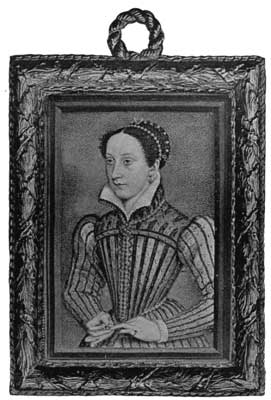
As this present work is neither a history of miniature painting nor a dictionary of artists, I need not attempt to enumerate the numerous inferior miniature painters to whom reference is made in the above extract; but I may say a few words about some men who belong to this period, and whose names and works are often met with by the collector. Earliest amongst these was William Wood, a Suffolk man, born 1760. His work is distinguished at any rate by harmony of colour and correct drawing. He was President of the short-lived Society of Associated Artists and exhibited at the Academy for twenty years (from 1788 to the year of his death), contributing over a hundred portraits. I should place Thomas Hargreaves, born at Liverpool, in 1775, in much the same category as Wood. His father was a woollen draper, who articled his son as an assistant to Sir Thomas Lawrence. Hargreaves's work bears the impress of that master's style. He painted W. E. Gladstone and his sister as children.
Then Henry Edridge, who was born in 1769, and lived to see George IV. on the throne, should not be overlooked. His early works are on ivory, but he is best known by his spirited and refined drawings on paper, the figures in which are slightly touched in, whilst the heads are carefully finished; good examples of them may be seen at the Victoria and Albert Museum. He became an Associate of the Academy, and his advancement in life is said to have been due to the influence of Sir Joshua Reynolds, who allowed him to copy his paintings in miniature; but the drawings by Edridge to which I have just made reference do not show the influence of Sir Joshua. He died in 1821, from grief at the loss of a favourite daughter, aged seventeen, and an only son.
Between the years 1786 and 1821 there were no less than 260 examples of Edridge's work shown on the walls of the Academy.
John Downman was a contemporary of the foregoing and also a fellow-associate of the Academy; but his portraits, though delicate and minute, hardly come under the definition of miniatures. John Linnell, the landscape artist, was a miniature painter at the outset of his career, as was Sir Henry Raeburn.
Mrs. Mee, born Anne Foldsome, is a lady miniaturist who is fully represented in the Royal Collection at Windsor, having been patronised by George IV. when Prince of Wales. I do not like her work, but all credit must be given to her for her exertions to support a widowed mother and eight brothers and sisters.
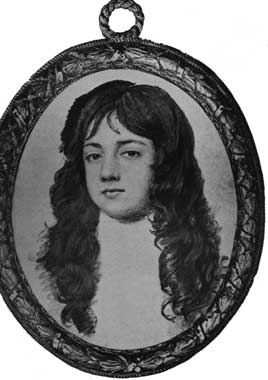
Alfred Edward Chalon (not to be confounded with H. B. Chalon the animal painter, nor with John James Chalon, R.A.) besides being a witty and popular man, was a thorough artist, as his spirited full-lengths, dashed in with great freedom, attest, his treatment of draperies being particularly skilful. He came of an old French family, and was born at Geneva, in 1817. He was made water-colour painter to Queen Victoria, and elected a full member of the Academy, to the exhibitions of which he contributed no less than 400 works.
And now, by way of concluding my remarks on English miniature painters, I turn to the group of men to which Miss Robertson refers, and the particular style of work they introduced; for they were, she alleges, the originators of the cabinet pictures in vogue at the beginning of the nineteenth century and in the early Victorian days. Miss Robertson does not make it clear to which Hayter she refers (for there were two, father and son, to whom her remarks might perhaps apply). I conclude she means Charles Hayter, who exhibited for nearly half a century; his last contribution was in 1832. In spite of his writings on perspective, and the alleged correctness of his likenesses, Hayter's work is feeble and uninteresting.
Sir William Newton is an artist about whom opinions differ, the late Dr. Propert, for example, hardly having a good word to say for him. In his own day, however, Newton, who was the son of an engraver, and descended from a brother of Sir Isaac, was a thoroughly successful man. He was made[Pg 272] miniature painter-in-ordinary to William IV., whom he painted a dozen times or more. He was knighted on the accession of Queen Victoria, in 1837, and was the first person who received that distinction in the new reign. Sir William became a well-known figure in London society, and took a leading position in the musical world. For fifty years he contributed nearly the whole number of works allowed to Academicians. At one time membership of the Academy was not open to miniature painters; after a long struggle Sir William obtained a withdrawal of the restriction, although he would not allow his own name to be brought forward for the honour. He lived to be eighty-four, dying in 1869.
In Robert Thorburn, A.R.A., we have an instance of a rapid rise. Born at Dumfries, in 1818, he had painted the Queen, the Prince Consort, and two of the Royal children by the time he was thirty years of age. His successful career as a miniature painter was cut short by the advent of photography, but not before he had painted many of the aristocracy.[4]
The change was so great that he abandoned the practice of his earlier
art, and took to painting portraits in oils, but with less success.
He died at Tunbridge, in 1885. In spite of a certain monotony in his
flesh painting, I greatly admire his miniatures, which are marked by
refinement, whilst the composition is graceful and sometimes dignified.
His[Pg 273]
[Pg 274]
[Pg 275] work was appreciated in Paris, where he was awarded a gold medal
in 1855.
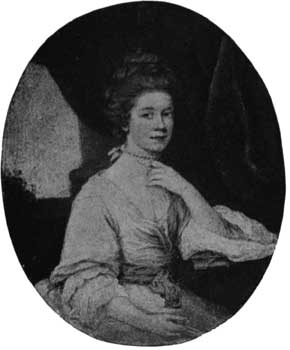
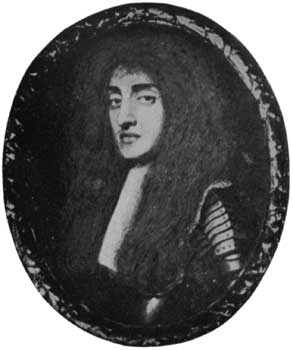
Like Sir William Newton and Sir William Ross (to whom I shall refer presently), Thorburn used large surfaces of ivory for his portraits, or cabinet pictures as Miss Robertson terms them: this was managed by taking the circumference of a trunk of ivory, making it flat by great pressure, laying it down on a panel and adding strips on the top, bottom, and sides. Thus pictures of considerable size with elaborate backgrounds could be painted and correspondingly high prices obtained.
I now come to a distinguished and excellent man who rounds off a period in the art we have under discussion.
Sir William Charles Ross was the last of the old school of miniature painters. Of Scottish origin, he was born in London, in 1794. Both his father and mother were portrait painters, the former being gardener to the Duke of Marlborough.
Young William Ross made an early start in life, for, according to Miss Robertson, he became a pupil of her father's when he (Ross) was only fourteen. In 1809, when he was but fifteen, he contributed three works to the Academy and had already won medals at the Society of Arts and in the Academy Schools.
Queen Victoria sat to him in 1837, and he painted the whole of the Royal Family of his day as well as the Kings and Queens of Belgium and Portugal, &c. His miniatures are said to have exceeded two thousand in number. After his death, in 1860, an exhibition of his works was opened at the Society[Pg 276] of Arts; the catalogue (which I have printed elsewhere) is likely to be of much interest in the future, and shows most clearly the commanding position Ross occupied in his profession. He painted Miss Angela Burdett-Coutts (as she then was) in 1846; it is here shown, and must be reckoned one of his finest works. The Baroness owned several other important examples of Sir William. At Windsor there are a great many, and in the exhibition to which I have just referred Queen Victoria is given as the owner of over forty pieces.
In judging of the artistic value of Ross we must remember that he had to contend with the difficulties imposed by a thoroughly tasteless style of costume, according to present standards. The period covered by his work coincides with that of the very lowest depth of Philistinism in art, costume, and architecture which our annals disclose.
His colour was too florid to suit some tastes, his palette being set somewhat à la Rubens, but his flesh-tints are fresh and delightful, and when time has mellowed them will probably be reckoned of great beauty. His composition, draperies, background, and accessories were treated with much skill. He had a brother, Hugh, who was also a miniature painter of ability.
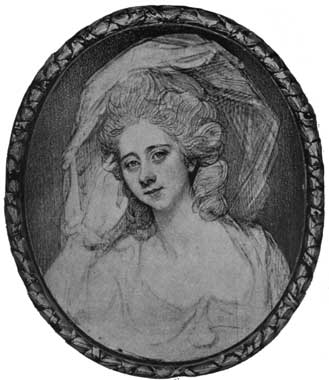
ROYAL AND PRIVATE COLLECTIONS
As in works by the old masters, so also this country is extremely rich in old miniatures. I am speaking now of private collections. Of course, by the very nature of the case, the majority of these are comparatively inaccessible, not that their owners are illiberal in furnishing a sight of their treasures to those who are interested, and can furnish reasonable credentials for admission to a sight of them, but these miniatures are scattered all over the land, and to see them demands time, trouble, and expense. In the restricted space at my command in this book it is futile to attempt to describe with fulness all the riches of those private collections which I have been privileged to study.
There are, however, a few collections of such paramount importance in connection with our subject that they cannot be passed by, and every one claiming to feel an intelligent interest in the subject of old miniatures must wish to know something, at any rate, of the nature and the extent of these private collections to which I have just referred.
The Royal Collection
Let us take first the Royal Collection at Windsor Castle, which comprises some thousand examples, many remarkable for their intrinsic beauty as well as their historic interest. Perhaps I ought to have put the latter first, as being the principal source of interest belonging to them. But that would be to look at them too much with the eye of the historical student. Were they all portraits of comparative nobodies, or even unknown persons, they would yet be a most delightful, varied, and fascinating collection. As Sir Richard Holmes, the ex-royal-librarian, who has written about them from time to time, has pointed out, the collection has one peculiar interest, namely that "in nearly every case these miniatures remain in the custody of the descendants of those for whom they were originally painted, and thus present an almost unbroken series of authentic portraits of the Royal Family from the time of Henry VIII. to the present day."
The fact that this unique collection goes back, as the reader has just been reminded, to Tudor days, leads us to expect that we may find some work by Holbein, perhaps the greatest name in all the annals of the art. Nor shall we be disappointed. Six examples there are by the great Hans, among them Katherine Howard, and the two sons of Charles Brandon, Duke of Suffolk, portraits possessing a pathetic interest, seeing that the originals both died on the same day from the sweating sickness. That was in 1551. Mr. Ralph Wornum's description of them may be worth giving.
UNKNOWN.
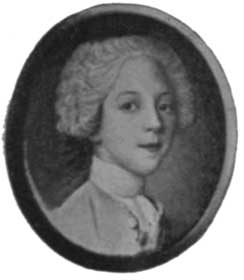
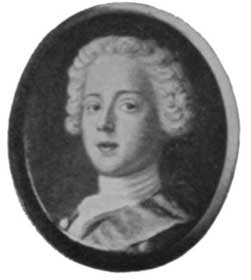
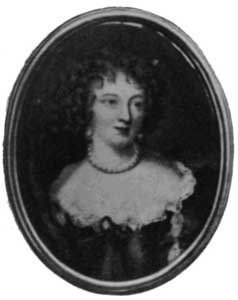
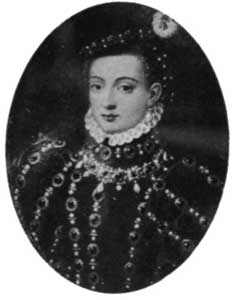
"Henry Brandon, Duke of Suffolk, in a black cap with white feather, and a black coat with green sleeves, blond hair cropped all round; he is leaning his left arm on a table, on which is written, 'Etatis svæ 5, 6 sepdem, Anno 1535.' Blue ground painted on the back of the ace or three of clubs. The other is his brother Charles Brandon, Duke of Suffolk, in a grey and red coat with black cuffs; his shirt collar is embroidered with black thread round the outer edge. Blue ground. On a tablet is inscribed 'Ann 1541, etatis svæ 10 Marci.' This is painted on the back of a king. Both are of the same size, one and eleven-twelfths of an inch in diameter. They are said to have been given to Charles I. by Sir Henry Vane, and both are entered as Holbein's work in Van der Doort's catalogue. They are freely, firmly, and yet elaborately executed.
"There are two of Henry VIII., one with a beard, in a black cap and black ribbonds about his neck, in an ash-coloured tissue suit in a fur cloak, his name and age in golden letters written on it. Being also one of the number which were given to the King by Lord Suffolk."
This description is a quotation from the catalogue made by Van der Doort, who was custodian of the pictures to Charles I., and that monarch is meant by the reference to "the King." The same authority describes another and lesser picture of Henry VIII.: "Without a beard, also in a black cap and a little golden chain about his neck, in an ash-coloured wrought doublet in a furred cloak with[Pg 286] crimson sleeves." Yet another Holbein is the portrait of Lady Audley, daughter of the Treasurer of the Chamber to Henry, whose portrait in red chalk is amongst the drawings by Holbein preserved at Windsor. These miniatures are all circular, and measure from one and three-quarter inches to two and a quarter inches in diameter.
Holbein's pupil, Nicholas Hilliard, is well represented at Windsor; the valuable catalogue of Charles I.'s collection which I have quoted above contains references to fourteen by him, including, says Sir Richard Holmes, "those of Queen Elizabeth. But these last, unfortunately, are no longer to be found." It is interesting to compare the renderings of Henry VIII. which Holbein and Hilliard respectively present. Amongst the most noteworthy of the Hilliards now at Windsor are four which were probably painted by Royal command, namely Henry VII., Henry VIII., Edward VI., and Jane Seymour. These were originally attached to a golden jewel, enamelled on one side with a representation of the Battle of Bosworth Field and the roses of York and Lancaster on the other. The miniature of Henry VII. must clearly have been painted either from imagination or from some earlier picture, since it is dated 1509, whereas Hilliard was not born till 1547. The other portraits, too, represent the originals when it would have been impossible for Hilliard to have painted them.
Among the miniatures of King Charles I.'s progenitors which Van der Doort describes is one which hung with seven others in his own chamber, and it is one of surpassing interest. He thus describes[Pg 287] it: "No 23. Item. Done upon the right light, the second picture of Queen Mary of Scotland upon a blew-grounded square card, dressed in her hair, in a carnation habit laced with small gold lace and a string of pearls about her neck, in a little plain falling band, she putting upon her second finger her wedding ring. Supposed to be done by the said Jennet. Length three inches, breadth two inches." The claim to authenticity which this portrait thus possesses is obviously very high, and Sir Richard Holmes asserts "there is no portrait of the unhappy queen which has so good a pedigree as this." We will not stop to discuss the complex and difficult question of the true portraiture of Mary Queen of Scots. Having recently published an exhaustive folio devoted to this topic, a work containing more portraits of Mary, good, bad and doubtful, than any with which I am acquainted, I may refer the reader to its pages for the further elucidation of this fascinating problem. I may, however, mention that the "said Jennet," by whom this portrait is "supposed to be done," was of course the well-known Janet, otherwise called François Clouet, Court painter in France at the time of Queen Mary's betrothal to the Dauphin, whose portrait, by the same artist and from the Royal Collection, I am able to show.
Clouet was one of a family of limners whose work was the best of the day, and his drawings should be seen and studied by all who wish to realise how admirable that work was in expression and character. It is to be seen to the best advantage in the Print[Pg 288] Department of the Bibliothèque Nationale, Paris, and also in the large series now preserved in the Palace of Chantilly, the ancestral home of the Condés.
By Hilliard I do not recall anything else very remarkable at Windsor, unless a small circular picture of a girl wearing the roses of York and Lancaster in her hair, which came from the Sackville Bale Collection and is said to represent Lady Jane Grey, is his work. But in the works of the Olivers, both father and son, the Royal Collection is rich. Among portraits by Isaac Oliver there is the extremely interesting and elaborate miniature, before referred to, representing Sir Philip Sidney seated under a tree, presumably at his birthplace, Penshurst, with a background of the formal Italian garden then so much in vogue (see p. 295). As this famous scholar, statesman, and soldier died in 1586, the work must be a comparatively early example of Isaac Oliver, who would be under thirty years of age at that time. A piece probably much later is one of no less importance, namely a portrait of Prince Henry Frederick, eldest son of James I., that "sweet royal bud" and "hope of the Puritans" who died in 1612. An entry in the catalogue of Van der Doort is as follows: "Imprimis. Done upon the right light. The biggest limned picture that was made of Prince Henry, being limned in a set laced ruff and gilded armour and a landskip, wherein are some soldiers and tents, in a square frame with a shutting glass over it. Done by Isaac Oliver. Length five and a quarter inches, breadth four inches."
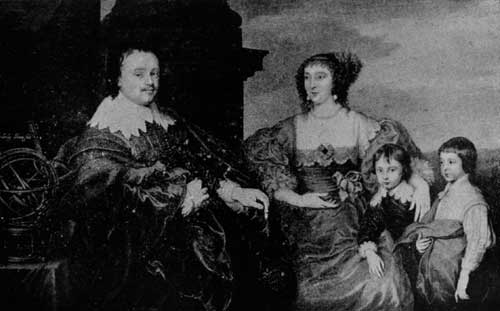
Worthy to be ranked with these is another large miniature of Charles II., which is even more highly finished than the two masterpieces, viz., Monck and Monmouth, which I described in Chapter VII.—that is to say, it is more finished throughout, because painting—in the head only was a characteristic of Samuel Cooper. Probably he found the painting of the drapery, background, and details somewhat irksome, and having got the head and the character of the portrait, was often wont to leave the completion of the picture until a more convenient season. Be the reason what it may, there is no doubt that several of the finest things that he ever painted are left in the unfinished state of which Walpole has complained in his "Anecdotes of Painting." There is, however, another miniature in the Royal Collection by this great artist which may be appropriately mentioned here, and that is a portrait of the man who sent the unfortunate "Mr. Crofts" to the scaffold. The cold, implacable nature of James II. is admirably and most forcefully suggested in this superb miniature. It represents him in armour when he was probably Duke of York, and may have been painted after his return from fighting the Dutch off the Texel. But the riches of this collection, numbering as it does not less than a thousand examples, are such that we must pass on.
For several decades following the death of Cooper there was comparatively little native-born miniature art of first-rate importance produced in this country, but about the middle of the eighteenth century a "bright particular star" appeared on the horizon in[Pg 292] the person of Richard Cosway, and in the works of this eccentric but highly talented miniature painter the Royal Collection is rich. The portrait of the celebrated Duchess of Devonshire, which will be recognised as an extremely characteristic example of the master, is one of the most beautiful things in its way in the Royal Library, and is here given. As I have devoted a chapter to the works of Cosway, I need not dwell further upon the examples by him at Windsor.
There is a good deal of work by another artist, a contemporary of Cosway, namely, Ozias Humphrey, to be seen here. Humphrey's style of painting is far less showy than Cosway's, but it has a completeness, a perfection of finish, repose, and beautiful colour, qualities which combine to give his art great and, to my mind, permanent charm. A good illustration of this may, I think, be found in his rendering of the somewhat homely charms of Queen Charlotte, here given.
In so large a collection, brought together, I believe, through the initiative of the late Prince Consort, and gathered into a whole from all the royal palaces, there are, of course, works by artists too numerous to mention here. But reference should be made to the large number of examples of Sir William Ross. The Crown possesses at least fifty works by him, many of large size, as was the fashion of his day. In the year 1860, Queen Victoria owned over forty examples, which comprised the English Royal Family and Queen Adelaide, besides the Queen of the Belgians, the King and Queen of Portugal, Louis[Pg 293] Philippe, and other foreign royalties, for Ross was the most fashionable portrait painter of his day.
Private Collections
Rivalling, in general interest, the Royal Collection at Windsor is that formed by the Duke of Buccleuch, now preserved at Montagu House, in Whitehall. Those who have been privileged to visit this collection, or who may remember it when it was shown in the rooms of the Royal Academy at the Winter Exhibition in 1879, must admit its extraordinary value, interest, and importance, alike from the artistic and from the historical point of view. It presents, in fact, a microcosm of English history, from the middle of Henry VIII.'s reign down to the closing years of the period of the Restoration. We may see the vera effigies of most of the leading characters of the times which are synchronous with the work of Holbein down to the death of Samuel Cooper, in 1672. The present writer well remembers of this exhibition that it left three very distinct impressions on his mind, the force of which has been but deepened by further acquaintance with the collection and by the process of time. From it he first gained some idea of the richness of this country in historical art of this nature. Secondly, he realised the high quality, and indeed supreme artistic value, of much of the work it contained; and, thirdly, the vivid illustration it furnished of the history of the times contemporary with the artists represented.
These considerations lead him to regard old minia[Pg 294]tures as valuable adjuncts to historical research, and as worthy of careful and serious study.
In the catalogue of the exhibition which I have mentioned we find amongst the contributions of the Duke of Buccleuch some hundred and fifty pieces by several of the most distinguished miniature painters this country has produced—for example, some half-dozen Holbeins, a score of Hilliards, as many Isaac Olivers, and more Coopers; not to speak of rare men like Bettes, Dixon, and John Hoskins, junr.
Setting aside the Holbeins, which, however, call for special notice
on account of the rarity of the master as a miniature painter, the
works of Samuel Cooper claim pre-eminence; and one of them, namely,
the portrait of Oliver Cromwell, to which I have referred before, is
regarded by some good judges as perhaps the very finest thing that the
great limner has left us of his work. I am indebted to the Duke of
Buccleuch for the information that it was purchased through the agency
of Messrs. Colnaghi, from a descendant of the Protector, namely, a
Mr. Henry Cromwell Frankland, of Chichester, who inherited it through
a daughter of Lady Elizabeth Claypole. A writer in the Athenæum of
September 10, 1898, states that this miniature is one of two of Oliver
Cromwell, which, being painted at Hampton Court, "were snatched from
the artist by the Protector, indignant because he found Cooper making
a copy of the original his Highness had sat for. Lady Falconbridge
[sic] inherited one or both of her father's captures, which, in the
course of a divided inheritance, parted company for about a[Pg 295]
[Pg 296]
[Pg 297] century
and a half, only to be reunited at Montagu House."
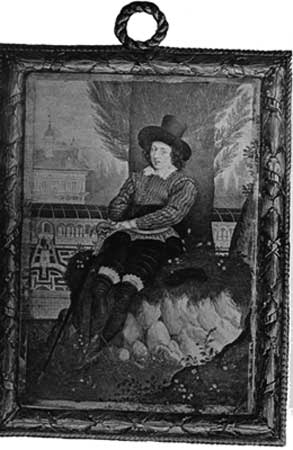
There is a very beautiful miniature of this Elizabeth Claypole herself (she was, it will be remembered, the second and favourite daughter of Cromwell) in the Buccleuch Collection; and in the same connection may be mentioned the portrait of John Milton, which I have dealt with in the chapter upon Cooper.
The beauty and importance of the Coopers should not blind us to the interest of some of the Hilliards—for instance, the portrait of Alicia Brandon, the wife of Nicholas Hilliard, and a portrait of Drake, dated 1581, painted probably just after his return from circumnavigating the world. The great seaman's hair is dark brown, his moustache and beard a light auburn; he looks manly vigour personified.
I have spoken of Dixon as being a rare painter; there are, however, at least seven or eight by him in the collection I am now describing. He is not mentioned by Redgrave, it may be noted in passing; but he must have stood high in Court favour in his day, seeing that Charles II., Madame Hughes, Mary Davis, the Duchess of Portsmouth, the Duke of Monmouth, and Prince Rupert were among his sitters, and their portraits are to be found in this collection.
I pass on to another private collection also remarkable for the number and the superb quality of its examples of Samuel Cooper. It is that of the Duke of Portland. The Welbeck Collection is largely a family one, and so far as I know was never made[Pg 298] as a collection pure and simple. But it contains, nevertheless, amongst the portraits that I shall proceed to mention, some of the very finest examples of Cooper with which I am acquainted. Four of these struck me as especially noteworthy, namely, Richard, Earl of Arran, John, Earl of Clare, Sir Freschevile Holles, and Colonel Sidney, afterwards Lord Romney. The latest of these works is dated 1668, four years before the painter's death. Cooper attained no greater age than sixty-three, and this may account for the absence of any discoverable decadence, even in his latest works.
Another marked feature in this collection, which is a large one, is the predominance of Laurence Cross and Bernard Lens; but Cosway and his school are scarcely, if at all, represented.
Another ducal collection, namely that at Belvoir, is important in respect of the historical miniatures it contains, and not the least valuable of these are miniatures of Sir Walter Raleigh and his son—he who was killed in the attack on the Spanish settlement on the Cayenne River, the story of which, and the beautiful enamel case which contained them, with its initials of Walter and Elizabeth Raleigh, is to be found in my book "Miniature Painters, British and Foreign," which also contains particulars of many private collections, described at considerable length and illustrated.
The Burdett-Coutts Collection is one of exceptional interest, inasmuch as it contains some of Horace Walpole's most treasured pieces. It is especially rich in the work of Peter Oliver, and hardly less so[Pg 299] in that of Petitot fils. By the kindness of the late Baroness, this important collection was shown in the galleries of Messrs. Dickinson, in New Bond Street, when the group of the Digby family, after Van Dyck, and the separate miniatures of Sir Kenelm and his handsome wife, all the work of the younger Oliver, were especially admired; these are all shown in this volume. The Petitots, as I have said, are remarkable, and the two examples here given were highly valued by the dilettante owner of Strawberry Hill. Of the Henrietta, Duchess of Orleans, as beautiful as she was ill-fated, he says it is a "very very large and capital one, exquisitely laboured."
On the back of the James II., which represents him as Duke of York, Walpole has written with his own hand "a present from the Duke to his mistress Mrs. Godfrey"; and in his "Anecdotes" he says of this enamel, "freely painted, though highly finished, and I suppose done in France." We find ourselves sometimes at variance with Horace Walpole's judgment, as when, for example, he extols Lady Anne Damer to the skies, and refuses the rank of a painter to William Hogarth! But as to his estimate of these two magnificent specimens of Petitot's art there can be but one opinion, and it is one which coincides with that of their former owner. Amongst the numerous Petitots in the Jones Collection at the Victoria and Albert Museum, to which I shall refer again, I can recall nothing to surpass, if indeed there be anything to equal them; and it is remarkable what astounding advance has been made in the value of these works of art, some of which[Pg 300] fetch, it is literally true to say, as many hundreds as they did single pounds only sixty-five years ago.
Those of my readers who are wont to observe the prices realised at auction nowadays by fine old miniatures may be interested to compare them with those obtained at the famous Strawberry Hill sale. In my "Miniature Painters, British and Foreign," I have printed the catalogue of Horace Walpole's miniatures, and given the prices they realised and the names of their purchasers. The curious in such matters will find many interesting notes and illustrations in the pages of this catalogue; e.g., the information given as to the provenance of the two Petitots just described is gleaned from George Robbin's catalogue, and I may add, from the same source, that the James II. fetched 75 guineas. It had been bought at the sale of the property of Mrs. Dunch (who was the daughter of Mrs. Godfrey); it fetched less than the Henrietta, which realised 125 guineas. We learn that Walpole purchased it of C. F. Zincke, the distinguished enamel painter, who had it in his possession for a long while, and "kept it as a study."
PUBLIC COLLECTIONS
The private collections of the United Kingdom, scattered as they are all over the country, are by the nature of things not readily accessible to the general reader. But with the public galleries the case is different; and in London there exist, within half-an-hour's walk of each other, two very considerable and instructive collections which may be seen, studied, and compared at leisure. I refer, of course, to those of Hertford House and the Victoria and Albert Museum at South Kensington.
And here, in passing, I should like to emphasise the great practical value of the comparisons which such visits enable us to make. To see, side by side, miniatures of various periods and by various masters is more informing than any amount of printed description.
The three hundred miniatures, or thereabouts, which the Wallace Collection contains, are extremely valuable, not only intrinsically, but because they present some reliable portraiture of great interest, and, especially, because they are the only examples of many[Pg 304] eminent miniature painters which are to be found in any public galleries in this country. As with oil paintings, so with miniatures; this collection fills lacunæ. The National Gallery is remarkably—one might say unaccountably—deficient in the French School, especially of the eighteenth century (the nineteenth, as we all know, is hardly represented at all), whilst the magnificent collection got together by the third and fourth Marquis of Hertford and Sir Richard Wallace, and now shown at Hertford House, is rich in these masters—so rich as almost to provoke the envy of our neighbours across the Channel.
It may be well to inform such of my readers as are not familiar with Hertford House that the miniatures are all to be found in three double cases in Gallery No. XI. The light, admitted by a side window, is not over good; this window faces north, and the best time to see the miniatures is in the morning.
The arrangement, roughly speaking, is as follows:—
In case B are placed miniatures of the sixteenth, seventeenth, and eighteenth centuries.
In case C, miniatures chiefly of the Napoleonic period and the Restoration.
In case D, miniatures of the eighteenth and nineteenth centuries, and a large number of small copies after François Boucher, with similar work by Charlier and others of the French school of the middle of the eighteenth century.
Thus, in the Wallace Collection we can study at our leisure a valuable
series of works by several of the best French miniature painters,
some of whom are[Pg 305]
[Pg 306]
[Pg 307] not to be found represented in any other public
gallery that I am aware of, even in Paris. There is, besides, a
not inconsiderable number of works by good English artists, which
afford instructive means of comparison, besides being interesting in
themselves. Viewing, then, the collection from the various standpoints
which I have enumerated, let us see what it reveals. We may here
dispense with any consideration of the pecuniary value; that is a
commercial view of the subject, one difficult to determine, and foreign
to the object of this book. Suffice it to say that the monetary value
of many of them is very great. Take the Isabeys and Halls, for example;
a miniature by the latter, shown at the Exhibition of Eighteenth
Century Art in Paris in 1906, at the Bibliothèque Nationale, fetched at
the Mülbacher Sale no less than 60,000 francs, or £2,400.
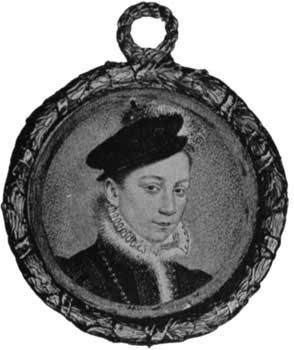
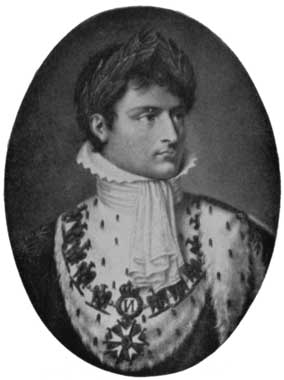
The collection at Hertford House is especially rich in portraits belonging to the Napoleonic period. Many of the principal personages of the First Empire may be found in case C. Thus we have Madame Letizia Ramolino, the mother of Napoleon I.—Madame Mère, as she was called; two or three portraits of Joséphine, notably one by Isabey in a Court dress of white and gold; four of Marie Louise, Archduchess of Austria and second wife of the Emperor. There is also one of her father, which bears on the back this curious inscription, "Madame, disait l'Empereur Napoléon à l'Impératrice Marie Louise, votre père n'est qu'une ganache," a term which may be very closely rendered by our English word "booby."
There are several portraits of the King of Rome, the son of Napoleon and Louise, who was living, as one is apt to forget, as late as 1832. The sisters of the Emperor, Pauline and Caroline, both are here, as are his brothers Jérome and Louis. Finally, of the Emperor himself there are over a dozen—as General Bonaparte in 1796; in Academic attire; and in Court costume, wearing in his hat the golden laurels of victory. Of this period of his career is the miniature by Isabey, in which he is wearing the Imperial robes and emblems of victory as before. This miniature by Isabey is a remarkable presentment of the man and a masterpiece of the artist. I have described these numerous Napoleonic portraits in some detail because many of them are not only remarkable as specimens of French miniature painting of the period, but they also bear out, I think, what I have said in the preceding pages as to the value of such works and the instruction they afford.
But the interest of the Wallace Collection of Miniatures is not confined to the personages who crossed the stage of French history during the First Empire. Here we may see also Louis XV. and Marie Leczinska, and two or three of their daughters, Louis XVI. and Marie Antoinette, Louis XVII. and Louis XVIII. Of the latter there are three or four portraits; of Madame de Pompadour one of exceptional beauty (No. 89), signed F. Boucher. It need hardly be said that François Boucher is not generally recognised as a miniaturist, the breadth and purely decorative nature[Pg 309] of much of his work being as far removed as it is possible to imagine from the minute finish of a miniature. This fact, it may be, has led Mr. Claude Phillips, the Curator of the Gallery, to remark upon this example, and to surmise that it represents "a wholly exceptional effort made for his (Boucher's) patroness." Strange to say, Madame Du Barry is unrepresented; on the other hand, Mlle. Du Thé and La Camargo, the famous dancer, whom Watteau painted, will be found.
I have given this prominence to the French historical characters as compared with English or other celebrities since, from this point of view, there is no comparison to be made between the importance of the two groups. A Cooper and a Flatman of Charles II., a copy by Bone (after Lely probably), of Charles's sister-in-law, Anne Hyde; an enamel by W. Grimaldi, copied from a contemporary portrait of John Churchill, first Duke of Marlborough; Mrs. Fitzherbert, by R. Cosway; and two portraits of Wellington by Isabey may be said to sum up the most notable works coming under the category of English historical characters.
In this connection there remains, however, one miniature of such importance, if its ascription be correct, as to merit a special reference. It is No. 93 described as a portrait of Hans Holbein the Younger. It is inscribed "HH. A N O. 1543 Etatis suæ 45." The Duke of Buccleuch possesses a similar one, the only variation perceptible being a subtle difference in the expression, and that in the Montagu House example there is a little more[Pg 310] seen of the painter's left hand. Each is on a card; that at Hertford House may be thus described: Head and bust of a man of middle age, in a black dress, open at the neck, and a black cap. He holds a pencil in his right hand and looks with a searching and rather sour expression at the spectator. The portrait is about one and a half inches circular, and has a blue background. The beard and moustache are dark and somewhat sparse, the flesh-tones flat, and inclined to brickiness in colour.
But I am disposed to consider the distinguishing feature of the Wallace Collection of Miniatures to be the number and importance of the works of Isabey and of Hall shown therein. By Jean Baptiste Isabey there are no less than twenty-seven examples, by Pierre Adolphe Hall nearly a score, by the talented J. B. Augustin, and by the comparatively little known Mansion, nine each; not to speak of Saint, Dumont, and of Sicardi. There is one specimen which the Curator apparently does not hesitate to ascribe to Fragonard, whose miniatures he justly says "are of extreme rarity." Here, then, we have a feast both rich and varied. Of the Isabeys we shall find that the most important pieces are dated between 1811 and 1831. They are treated with a breadth and freedom of handling which make them resemble water-colour sketches, but when looked at closely they will be found to have careful detail in the features, and to be miniatures strictly speaking.
The Halls are characteristic and good, the[Pg 311]
[Pg 312]
[Pg 313] Mansions exceptionally
fine. I have dealt with both these artists in the final chapter of this
book.
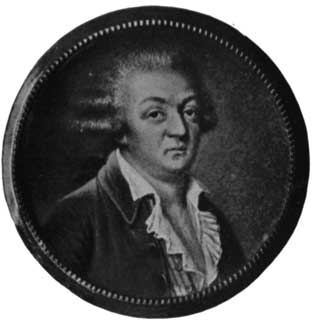
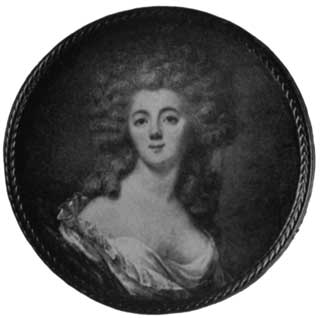
It would be impossible to examine here the hundreds of miniatures in this collection. They deserve the closest attention, and should be carefully studied with the aid of a magnifying glass.
The Victoria and Albert Museum.
Having elsewhere in this volume expressed regret at the absence of any national collection of miniatures in this country, I refrain from giving utterance to disappointment again. But if there is one place more than another where such feelings are aroused it is at South Kensington. True there are miniatures there, but only in sufficient numbers and, I may say, of sufficient quality, to whet the appetite for more.
Apart from the Jones Collection, which may be dealt with separately, the miniatures in the Victoria and Albert Museum are rather disappointing, and that in spite of a few examples of interest. The National Collection preserves all its riches of art of this nature in four cases, which stand in the Sheepshanks Gallery. The catalogue has, I believe, been out of print for years, certainly there is none now obtainable, a circumstance very much to be deplored, to say the least of it. Another matter of regret is that the miniatures cannot be seen properly by the artificial light with which the galleries are provided; seeing that the museum is open until ten p.m. three or four nights in the[Pg 314] week, many must feel it tantalising to have no catalogue, and insufficient and unsatisfactory lighting.
Taking in a rough chronological order what is there shown, we shall find a faded Queen Elizabeth or two, of the usual type, by Hilliard, and a fine Oliver of unwonted freshness and brilliancy, due, no doubt, to its having been preserved in a locket. It is dated 1619, and must therefore have been painted by Peter Oliver, as his father died two years earlier. The flesh-tones are particularly good and true to nature.
Of the Samuel Coopers, of which there are two or three examples, that of Henry, Duke of Gloucester, the brother of Charles II., is the finest and most noteworthy; it is somewhat faded, but the long, weak face and melancholy expression, which seem typical of his race, are strikingly rendered. To about this period belongs a very fine specimen of plumbago work by David Loggan; it is a portrait of Sir Greville Verney, full of life as to the character of the head, and of exquisite finish and delicacy in execution. Near this hang two examples of similar work by Thomas Forster, but of much inferior quality. They present John, first Duke of Marlborough and his imperious wife, and are dated 1712. Richard Cosway is not shown at his best, although the Earl of Carlisle is a good and characteristic specimen of his somewhat effeminate rendering of men's portraits. By his pupil, Andrew Plimer, are two very indifferent portraits of ladies, but another of a young lady (given by Miss Edmonstone Ashley) is a very charming work; the fair unknown wears a huge white chin[Pg 315] stay, and looks at the spectator with an arch and vivacious expression. Mrs. Carruthers is a pleasing instance of J. Meyer's sound and attractive method of painting, and there are two excellent and characteristic Rosses, viz., Margaret, Duchess of Somerset and Mrs. Dalton. There is also a very good specimen of Sir W. J. Newton, an artist whose work is now perhaps somewhat underrated. In the Plumley Collection of Enamels, shown in the same gallery, are some examples of Essex which may please lovers of animals, and a number of Bone's copies, which, skilful as they are, considering the scale on which they are done and the difficulty in doing them, yet leave a good deal to be desired when compared with the originals. A word may be said as to the Barbor jewel which hangs in one of these cases, and is reproduced in this book. It was made for a Mr. Barbor to commemorate his deliverance from the stake in the reign of Mary Tudor by the timely death of that sovereign just at the time fixed for his execution. It is cut in a fine Oriental onyx, mounted in gold and enamelled, and was bequeathed to the Museum by the Rev. E. E. Blencowe.
The Dyce Collection.
There are four small cases of miniatures pertaining to the Dyce Collection which contain a few Coopers, and, notably, a portrait of the artist himself, of which last an illustration is given. The pocket-book and its contents attributed to Cooper I have already referred to in Chapter VII. Some[Pg 316] of these are thoroughly characteristic; others, in their smoothness and in the nature of their colouring, are quite unlike Cooper's ordinary manner; whilst in one instance at least the drawing is so bad as to make one sceptical of its being the work of such an artist as Samuel Cooper at all. Take for example the portrait labelled Miss Pru Fillips (sic), or Mrs. Rosse, or Mrs. Priestman. On the other hand, the preparatory sketches for the Duchess of Cleveland and Mrs. Munday, and, above all, the Catherine of Braganza strike one as being not only the work of the master but also as especially characteristic. There is a very good Flatman in this collection, a portrait of himself; there are also a number of miniatures in oil on copper which, like most works of this nature, fail to interest us very much; owing to their scale they have necessarily nothing of the impressiveness of an oil portrait, whilst as miniatures they lack delicacy and charm.
The Jones Collection.
As the Isabeys and Halls strike the dominant note of the Wallace Collection of miniatures, so do the enamels by Petitot that of the Jones Collection at the Victoria and Albert Museum. There are at Kensington no less than 56 pieces attributed to Jean Petitot, besides two others ascribed to Petitot the Younger.
I shall not re-enter upon a criticism of the great Genevese enameller
and his marvellous art, with its distinctive character, further than
to repeat that for minute delicacy, perfection of drawing, and[Pg 317]
[Pg 318]
[Pg 319]
colouring it has never been excelled. I am speaking of course, of
genuine work by Petitot, for he has had numberless imitators and
copyists.
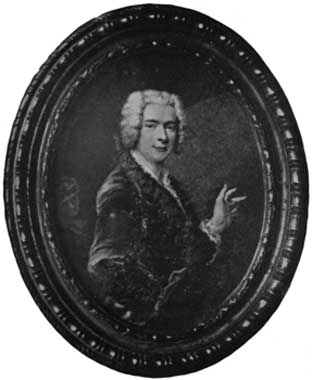
Upon examining the index of painters which is subjoined to this chapter it will be seen that many of the names we have been discussing occur therein, but the Jones Collection cannot be said to be a representative one. There are but three or four Coopers, one each by Hilliard and Hoskins, Zincke and Boit have five between them; there are three attributed to Peter Oliver, and the like number to Isaac. In the case of the last named, however, we have a chef d'[oe]uvre in the shape of the portrait of the Earl of Dorset already described in Chapter VI. By Bernard Lens also we have an important example, namely, the full length of Sarah Jennings, Duchess of Marlborough, in the blue robe affected by artists of the period.
But it is the Petitots which in the eyes of students should give such especial value to this collection, for nowhere else, so far as I have seen or heard, can the like be found, certainly not at the Louvre. Having previously enlarged fully upon the exquisite art of which Jean Petitot was the greatest exponent, I need not recapitulate the charm which attaches to these gems of miniature painting nor the difficulties attending their production. But I have been at the pains to arrange the Jones Collection alphabetically under painters and personages, to facilitate reference. By the aid of this analysis I trust my readers will be enabled to judge for themselves what there is to see at Kensington in this[Pg 320] way, and, if they have a genuine interest in the subject, they may find the study of the collection facilitated by this key to its contents.
INDEX TO THE NAMES OF PERSONS IN THE JONES COLLECTION.
INDEX TO PAINTERS.
THE FRENCH SCHOOL
A study of French miniature painters has led the present writer to place their work on a higher level than has heretofore, perhaps, been generally assigned to it, and has shown him that there have been not a few but many French miniaturists of remarkable excellence, and that they practised their art during a period which we are accustomed to look upon as one of anarchy, of tumult, and of bloodshed; a fact which is not only interesting in itself, but has the advantage of throwing light upon the period also; on its life, and on the men and women who played prominent parts during that eventful period of modern history, for we find ample evidence that even during the Terror itself the miniature painter was busy at work. In this respect, as in many others, a recent exhibition of eighteenth century French Art, at the Bibliothèque Nationale in Paris, revealed much. Indeed, it may be said that it was the most noteworthy event in connection with miniatures, and the claims they have upon the notice of students of art, of manners, and of costume, which has taken place for years.
It was recognised as a revelation by the learned authorities of the French national library, who were responsible for its arrangement, foremost amongst whom stood the late lamented Henri Bouchot, "Directeur du département des Estampes," a gentleman to whose courtesy I have been personally indebted, and whose critical acumen was well known.
It was, they said, a revelation; they spoke of it in relation to its technical aspects more particularly. It brought to light a number of French miniature painters whose ability was amply demonstrated, but who were almost or quite unknown at the present day, even to their own countrymen.
But the personality of these miniature painters and the remarkable people who sat to them must not make us ignore some earlier men to whom I shall now briefly refer.
In the first place I may call attention to the fact that, as might be expected, a comparison between French painters-in-little and those of Great Britain reveals some interesting differences, both technically and in respect of the treatment of the subject. The latter differences, which spring from national characteristics, will, I think, be brought out as we come to deal with the work of the various artists, and I shall not stop to enlarge upon them now.
At a time when we could boast in England of no native artist of
importance—hardly one, indeed, can be named, for Nicholas Hilliard was
not born until the middle of the sixteenth century—there was working
in France a family of artists known as the Clouets, who produced
portraiture of great excellence. What[Pg 329]
[Pg 330]
[Pg 331] I have termed elsewhere the
tangled skein of the history of the Clouets would take a great deal of
unravelling. It is a subject to which foreign critics of eminence have
devoted much time and trouble. Without following all their researches
in detail, or professing to utter anything like the last word upon
an obscure and difficult subject, it may be said to have been proved
that the family was undoubtedly of Flemish extraction, and that they
were firmly established at the French Court at the beginning of the
sixteenth century. M. Laborde, in his "Renaissance des Arts à la Cour
de France," quotes a deed of gift of property which had escheated
to the Crown dated 1516, the second year of the reign of François
I., which shows that, at any rate, by that time the Clouets were
established in Royal favour.
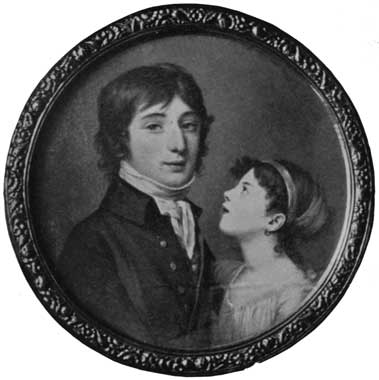
The surname was probably originally Clouwet, and two members of the family, father and son, have been commonly known as Janet. This duplication of names, to say nothing of the varieties of spelling, has led to a good deal of confusion in the attribution of works by these artists. Among the latest authorities upon this subject I may quote my friend M. Dimier, of Paris, who contributed a chapter to my book on the portraiture of Mary Queen of Scots.[5]
The subject has a significance of its own for French art critics as throwing light upon the influences exerted upon French artists at the period of the Renaissance—that is to say, whether the work by the men of that time which has come down to us[Pg 332] owes its highest artistic qualities to Italian influence, to native genius, or to Flemish influence. Critics are divided into two camps: those who stoutly maintain the claims of the French artists to originality, and those who are equally confident that it is to Italian influence we owe all that is most attractive in French art of that period. M. Dimier has acutely pointed out that whilst the Italian influence theory is anathema to many, these same critics allow the assertion of Flemish influence to pass without a protest.
Be all this as it may, it is quite clear that the vogue for portraiture in France at the beginning of the sixteenth century was extraordinary. Contemporary inventories show that drawings by the thousand must have existed. They were kept in albums in the houses of the great, and many collections are known. Catherine de Medici loved to have her children painted, and M. Bonafflé has shown that her estate included more than a hundred such portraits. There are numbers of these to be seen to-day at Chantilly, the old home of the Condés, not the least interesting of which is a series of eighty or ninety drawings in black and red chalk that once belonged to the Earl of Carlisle and formed part of the famous Castle Howard Collection.
Before leaving the Clouets, I may mention that a painting, measuring sixty-one by fifty-three inches, of Henri II. was sold at Christie's in January, 1905, for £2,500. Those who were fortunate enough to have visited the Exhibition de Primitifs Français at Paris, in 1904, will remember a number of interesting por[Pg 333]traits attributed to the two Clouets, of which they cannot have failed to admire the beautiful portrait from the Louvre of Elizabeth of Austria. The original drawing for this is in the Bibliothèque Nationale, and the existence of the two works—that is, the crayon from nature and the beautifully finished picture in oils—is interesting as showing the practice of the artist.
In the remarkable Exhibition just named the student will have made the acquaintance of many names probably new to him, and can hardly have failed to observe the number attributed to Corneille de Lyon, most of them dated somewhere about 1548. This is an artist who has only of late years won recognition. He, too, was a Fleming, but the only name which can be assigned to him is Corneille. M. Dimier says he was a native of the Hague who settled at Lyons. He surmises that the Royal visits to Lyons in the year 1536 were productive of Royal patronage. But M. Dimier appears to hold very conflicting views as to the merits of this artist, and discovers great divergences in his style; thus he says: "His [Corneille's] knowledge is so scanty that he can scarce fill in his own feeble design; in the best of these pictures the bust and shoulders are like students' work, and verge on the ridiculous"; yet his texture, he says, elsewhere, "is delicate, limpid, and absolutely fresh, the total effect the result of genius of a very small order." But in a portrait of the Baron de Chateauneuf, which does, or did, belong to Mr. Charles Butler, he finds work which he says is scarcely unworthy of Holbein;[Pg 334] "in depth of knowledge, boldness of execution, and extreme beauty of colour this little work is a masterpiece, far and away superior to anything which I have ascribed to the Janets," &c.
I have quoted these opinions at some length so that readers may judge for themselves of the relative importance of this early artist, all of whose work exhibited at the Exhibition de Primitifs was small in scale, and most of it, I have reason to believe, new to some students of art.
When we leave the Court of the Valois we seem to come to a great gap in our subject; and it is not until we arrive at the names of Petitot and his followers, a subject which has already been dealt with in Chapter VIII., that there is anything of importance to arrest our attention. This book is in no sense a detailed history of miniature painting; it merely aims at discussing some of the salient points of a wide subject; and, therefore, I make no further apology for passing on to the work which was executed in the eighteenth century, when several artists of remarkable ability appear on the horizon. I propose to take a few of the most eminent of these names, and to deal with them in chronological order.
Following that classification, the amiable Rosalba Carriera will come
first. She was born in Venice in 1675; and though some would deny her
any extraordinary talent, certain it is that she achieved European
reputation. This lady must have possessed charming manners and very
endearing qualities, for she is reputed to have been plain in personal
appearance. Some ten or twelve years before her death,[Pg 335]
[Pg 336]
[Pg 337] which
occurred in her native place in 1757, she became blind, and devoted
her means and the closing period of her life to works of charity.
She painted a good many miniatures, which are dispersed in various
collections, also landscapes. But probably her fame will rest most
securely upon her work in pastels, of which there are examples in the
Louvre; I recall two in the Salon des Pastels which are not unworthy
of the fine specimens of that kind of work which hang around them; and
that is high praise indeed, for, as every one knows, work in crayons
was carried by French artists of the eighteenth century to a pitch
of astonishing excellence; some of the portraits in that room by La
Tour, for example, can hardly be surpassed for truth to nature and
beauty of drawing; with almost the strength of oil paintings, they
have a character and charm peculiar to themselves. In landscape work
Rosalba earned great renown, though there are some who say that she was
over-praised in her day and by her generation.
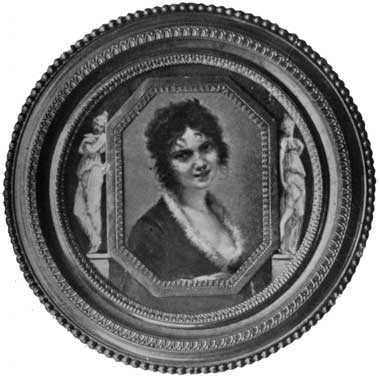
Jean Baptiste Massé has been described as a link between seventeenth and eighteenth century miniature painters. He was also an engraver, the son of a Protestant goldsmith of Chateaudun, born in 1687. In spite of his religion, the Regent obtained his admission to the Academy. He worked in gouache and his style is said to have influenced Hall. The portrait of Natoire here shown gives a good idea of his powers. He lived till 1767.
In François Boucher, who was born just at the beginning of the century, in 1704, and died in 1770, we have an artist of consummate ability, whose[Pg 338] renown does not depend upon his miniatures. He may be called the decorative artist par excellence of the century; but probably many of the little nudities (of which there are a large collection to be seen at Hertford House) which are attributed to Boucher are really by Charlier and others of his followers. The learned editor of the catalogue of the collection of French miniatures shown at the Bibliothèque Nationale in 1906 is my authority for saying that some of the miniatures which are signed Boucher are by Madame Boucher, not the wife of our painter, but a lady bearing the same name. Thus the connection of François Boucher with our subject appears to be slight, and as his other work is so well known we need not stop to discuss him further.
Jacques Charlier comes next to his master in point of date, having been born in 1720. Very little biographical information is to be gleaned about this artist; nevertheless he was extremely well known in his time, and his genius, such as it was, appears to have been admirably adapted to the taste of the day. Thus, the Comte de Caylus, the amateur who has left us that valuable memoir of Watteau which the Goncourts rescued from oblivion, is said to have possessed a hundred examples by Charlier; and in 1772 the Prince de Conti commissioned him to paint a dozen miniatures at 1,200 livres apiece. Louis XV. also extended his patronage to Charlier, who painted upon boxes most of the members of that monarch's family.
It would seem that after the death of Louis XV. Charlier's reputation waned, and the value of his[Pg 339] works diminished. He had a sale of his productions which by no means answered his expectations, and shortly afterwards he died. Hertford House can boast of a large number of works attributed to Charlier; but, for the most part, they consist of the familiar Toilet of Venus, nymphs bathing, and such-like subjects which we are wont to associate with Boucher. But here and there will be found a portrait—one of Madame Elizabeth of France, for instance.
The versatile Jean Honoré Fragonard, says M. Bouchot, painted miniatures only for his amusement. This critic also attributes them to Madame Fragonard. Be their authorship what it may, examples which can be safely attributed to him are extremely rare and greatly sought after. A representative one is to be seen in the Ashmolean Museum at Oxford, and another is in the Wallace Collection.[6] Each may be described as a portrait study of a young girl; in each the handling is broad in the extreme, and resembles a freely painted water-colour drawing in effect.
I now come to a miniature painter proper, of the highest excellence, viz., Pierre Adolphe Hall. He has been termed—and I, for one, should agree with this verdict—the finest miniature painter of the eighteenth century. The facility of his execution is simply marvellous; the sweetness and tenderness of expression that he gives to his faces, and the invariable refinement of his works, make them delightful. His manner is entirely peculiar to himself, body[Pg 340] colour being largely used. The work is broad in style and effect, and yet the features are often minute.
The career of this prolific artist was somewhat chequered; and although he earned large sums of money by his brush—as much as twenty to thirty thousand livres a year, it is said—he died in poverty, and left his family in want. He was born at Stockholm, in 1736. When twenty-four years of age he came to Paris to study; here he remained many years, and married a Mlle. Godin, of Versailles, whose father was killed in the Revolution. Gustavus III. wished Hall to return to Sweden; but he had become so thoroughly French that he refused.
The Revolution sounded the knell of the artist's fortunes. Quitting Paris, he started for the north, hoping to find employment and commissions on the way; but at Liège he was seized with apoplexy, and died there, in 1793.
In the Exhibition of Miniatures at the French National Library to
which I have several times referred, there were over fifty examples
attributed to Hall, many of superb quality and undoubted authenticity.
I do not mention the price obtained at auction as an infallible test of
the quality of a miniature, or of any other work of art—for fashion
reigns supreme in the sale-room as elsewhere; nevertheless, it is
perhaps worth recording that two miniatures by Hall, shown in this
collection, fetched the sum of 28,000 and 60,000 francs respectively,
one being a portrait of the Countess Helflinger, née O'Dune—an
exquisitely soft and tender example, now belonging to M. Cognac; while
the other came from[Pg 341]
[Pg 342]
[Pg 343] the Mülbacher Sale, and represented, not Louisa,
Queen of Prussia, as was wrongly stated in Swedish on the back of the
frame, but probably, since the portrait is entirely French in style,
that of Mlle. Dugazon in the character of Nina, as may be seen by a
comparison with an engraving of the subject by Janinet after Houin,
and the portrait by Mme. Vigée le Brun of the famous actress which now
belongs to the Comtesse de Pourtales.
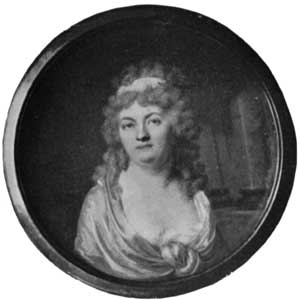
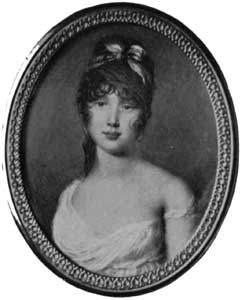
The year after Hall, was born in Stockholm another Swedish artist, destined to attain great popularity in France, and, like his greater compatriot, to fall into neglect, was Nicolas Lavreince, or, to give him his proper name, Nicolas Lanfransen.
When about thirty years of age he came to Paris to pursue his studies, and the work of his dainty, minute, not always too decorous brush was just suited to the taste of the people for whom he worked and amongst whom he lived. He, too, like Hall, drew Nina, and the Dugazon in the rôle of Babet, and the Du Barry of course; all of whom were to be seen in the Bibliothèque Nationale a year or two ago, each portrait being marked by extreme delicacy of touch and minuteness of finish. It must be owned that there is an extraordinary charm about the work of this artist, apart from its merits of execution; but it is a charm difficult to put into words. They have not the unreality of the fêtes galantes, nor the domesticity of our Francis Wheatley, but something between the two, something of the daintiness of Watteau combined with the homeliness of the English artist.
He worked a good deal in body colour, and his gouaches have been engraved in colour and in black and white by Janinet and Vidal. Many of these, such as "La Comparaison," "L'Aveu Difficile," "L'Indiscrétion," are very celebrated, and now of extreme value; while another, "Le petit Conseil," is a print of great rarity. Probably driven away by the Revolution, Lavreince, like Hall, quitted Paris, and died at Stockholm, in 1807, at which date, according to M. Bouchot, his art had fallen into complete discredit.
Antoine Vestier, born in 1740, is recognised as an oil painter, and was received into the French Academy in 1786. He is said to have rivalled Mme. Vigée le Brun and Roslin, and loved to adorn his sitters with ribbons and satins. Nevertheless, he was a miniature painter, and exhibited in the Salon excellent work of the kind, marked by good colour and careful execution. He lived on until the end of the first quarter of the nineteenth century, and had a daughter, Nicole Vestier, who was also a miniature painter. She married Dumont, himself a distinguished artist, of whom I shall have something to say later on.
Another artist who devoted special pains to his draperies, and has been called the Roslin of miniature painting, was Jean Laurent Mosnier, born in Paris, in 1746. Mosnier was made an Academician two years after Vestier, but did not long survive, dying in 1795. French critics place his work on a level with that of Augustin or Dumont. His comparatively early death may account for the rarity of his miniatures, which are extremely scarce and much[Pg 345] sought after nowadays, being distinguished by excellent taste and brilliant finish, especially, as I have said, in the painting of the draperies.
In the same year as the last-named artist, Luc Sicard, or, as he was sometimes called, Sicardi, was born. He was a native of Avignon, and one of the best miniature painters of his day. The delicacy of his flesh tones, the precision of his execution, and his attention to the most minute details made his work especially adapted for boits aux portraits; and he was officially attached to the Ministry for Foreign Affairs, to assist in the production of these cadeaux diplomatiques, for which he was wont to be paid 300 livres apiece. Hence many portraits of the French Royalty of his time were executed by him.
There is a lovely example of his delicate handling in the Wallace Collection (reproduced in my "Miniature Painters"); and the fine example given in this volume, the portraits of Benoit Boulouvard and Françoise du Plain de Ste. Albine, gives a good idea of his style, though it cannot convey the colouring which is especially charming in the latter example. Thus, the girl wears a citron-coloured ribbon in her beautifully painted hair, her dress is of a tender pale greenish-blue, her lips fresh and red; her dark eyes contrast with a pale complexion of the utmost purity, while the boy's deep blue eyes contrast with his warm brown hair. Sicardi died in the same year as Mosnier, namely 1825.
Another provincial artist of about this period was Claude Jean Baptiste Houin, a native of Dijon, where[Pg 346] he died, as Conservateur du Musée, in 1817. His work, too, is much sought after now. He was a pupil of Devosge and Greuze, and also painted in pastel.
M. Rouvier, who was born in 1750 and died in the year of Waterloo, is a man whose work appears to have won recognition in his own time, a contemporary writer speaking of it as possessing likeness, good colour, and harmony; but, perhaps owing to the rarity of examples by him, he may be said to be almost unknown to the present generation. There were four notable miniatures by him in the Alphonse Kann Collection, dated 1780 and 1781. They are marked by beautiful handling and distinction of style.
In François Dumont we have, it is generally allowed, one of the foremost miniature painters that France can boast of, worthy of being ranked with Isabey and Augustin, and, like both of them, a native of Lorraine. In the Exhibition, which was so valuable as an exposition of what the French school was capable of, there were a large number of works by Dumont, comprising Marie Antoinette, painted in 1774, and many portraits of the period of the Revolution. There is a certain sobriety and moderation about the work of Dumont which conveys a sense of solid value, sometimes rising to a height of character painting of extreme vigour, and sometimes, in his women's portraits, marked by great delicacy of face, hair and drapery painting.
The career of Dumont is a notable instance of the triumph of genius and
industry. He was left an[Pg 347]
[Pg 348]
[Pg 349] orphan, with six brothers and sisters, and
when only eighteen years of age quitted his native place, Luneville,
and came to Paris as a portrait painter. After ten or twelve years'
work he had so far succeeded as to be able to go to Rome, in 1784,
where he established a reputation which led to his being appointed the
"miniaturiste attitré" of the Italian Court. He was made an Academician
when only thirty-seven, and the King gave him Cochin's rooms in the
Louvre. The year the Revolution broke out he married Nicole Vestier;
and from that time on till 1824 Dumont's contributions to the Salon
were regular and numerous.
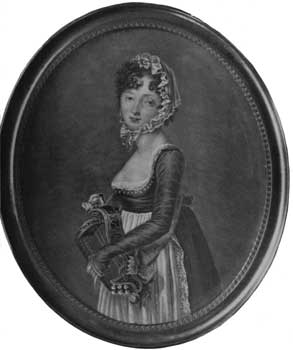
There is a comparatively large collection of his works to be seen at the Louvre, bequeathed by Dr. Gillet. It may be noted that he had a brother, Laurent Nicolas Antoine, called Tony, who painted miniatures, signed "Dumont," at Paris. Some critics are inclined to attribute a certain heaviness of style to Dumont, which may be the excess of the solid qualities that I spoke of; and this charge is somewhat borne out by the examples to be seen at the Louvre.
The lourdeur of Dumont passes into leatheriness in the work of Louis Lié Périn, his flesh painting being greatly inferior to that of his master, Sicardi. Périn came to Paris to earn his living as a miniature painter in 1778. Ruined by the Assignats in 1799, he returned to his native place, Rheims, where he followed his father's trade of woollen manufacturer; but he continued to paint during the Empire, and died in 1817.
In Pierre Paul Prudhon (1758-1823) we have an artist indeed, but not, strictly speaking, a miniature painter, for his work in this manner was but little. Nevertheless, there is one celebrated example of his powers, viz., the portrait of Mlle. Constance Mayer, from the Eudoxe Marcille Collection. The tragic end of this pupil and friend of Prudhon is well known. The face is marked by the sensibility which was the distinguishing charm of that ill-fated lady and artist. There is a large drawing of the same subject in the Louvre (reproduced in my recent work on "Eighteenth Century French Art"), remarkable for force and character.
Jean Baptiste Jacques Augustin (1759-1832) has long enjoyed a reputation as one of the greatest miniature painters produced by France; but it was reserved for the Exhibition brought together at the Bibliothèque Nationale in 1906 to show the extent and surpassing quality of some of his work. From the collections of Baron Schlichting and Alphonse Kann, from the Doistau Collection, and last, but not least, from Mr. Pierpont Morgan, came nearly fifty works. The quality of these varied a good deal, some being almost coarse and bricky in colour, whilst others, notably some sketches, with small heads, which came from Augustin's heirs, were amongst the most wonderful things I have ever seen in art of this nature. It would be impossible to convey an adequate idea of the marvellous expression, delicacy, and finish combined in the heads in these sketches, which were not larger than a pea. In another specimen of his powers in the same collection might be seen the most delicate[Pg 351] tones of flesh painting imaginable. In the Wallace Collection are nine or ten Augustins, including Jérome and Napoleon Bonaparte and Marie Louise. The most attractive of them all is a young lady in a white bodice, with a leopard skin hanging round her décolleté figure. She has a most vivacious and winning expression. It is dated 1824.
Augustin arrived in Paris some eight years before the outbreak of the Revolution; he lived to paint Napoleon at the height of his greatness, say, about 1810, Joséphine, Pauline, and others of the Bonaparte family, and died of cholera in 1832. Between 1781 and 1800, when he was married, he painted upwards of three hundred and sixty portraits, some miniatures and some in oils. His wife became his pupil, and is said to have almost equalled her husband. She lived till 1865, and her work is often confounded with that of her husband, whose method of working and artistic tendencies she thoroughly understood and embraced.
It has been said of Augustin that he was the traditional descendant of the old missal painters; and a portrait by him of Denon in enamel recalls, according to M. Bouchot, the best work of Fouquet, of Clouet, or Nanteuil. I should have said that, compared with the two latter painters, he was far their superior when at his best. For delineation of character, minute detail, and brilliant, if somewhat hard, finish, Augustin's work would hold its own in comparison with much of the finest medieval missal-painting, which, indeed, it instinctively recalls. Although, consciously or unconsciously, Augustin's[Pg 352] work may have been influenced by the study of medieval work, with its brilliancy, formality, and patience, amongst the fifty pieces from his hand shown in Paris a considerable variety of treatment might be found, some of it being large and bold in style, as, for example, a portrait of the sculptor Calamard.
J.-B. J. Augustin must not be confounded with that Augustin Dubourg who signed his work "Augustin." Dubourg's work is not met with after 1800; it is said that he was a cousin of the better-known man, and came from the same town, namely St. Dié in the Vosges.
A contemporary of Augustin, born in the same year and dying in the
same year, was Charles Guillaume Alexandre Bourgeois. His effective
manner of rendering a portrait may be said to be peculiar to himself,
he treating them as medallions, and painting the head in profile on
a black ground, which greatly added to their effect. Although this
seems to have been Bourgeois's favourite method of portraiture, it was
not his invariable practice; and when, leaving the marble whiteness
and medal-like effect of his ordinary method, he set himself to
paint flesh tones and the fair skin and rounded contours of youth,
he was equally successful. He is said to have been very proficient
in practical chemistry, and published several works on the subject.
Although he exhibited in the Salon from 1800 to 1824, his work is
rare, and examples fetch a high price. A peculiarity I have noted in
his treatment is that the eyes in his women's portraits are invariably
large and the eyes[Pg 353]
[Pg 354]
[Pg 355] lashes curled to an unnatural degree. I should
say that his men are not as well painted as his women. The medallion
style that he affects makes his work particularly suitable for
insertion in boxes.
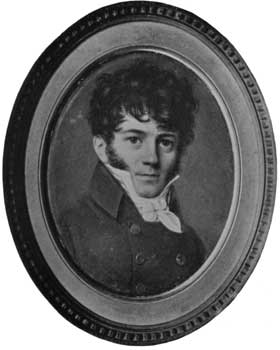
In concluding these remarks upon the French school of miniature painters, I come to a very distinguished name, that of Isabey, with which two other artists may be grouped as pupils or companions; and we will take the latter first; they are Jean Guérin and Louis François Aubry.
Guérin was born in 1760, and was a companion of Isabey in David's studio. His abilities must have been early recognised at Court, as he painted the King and Queen, and, later, many of the celebrities of the Assemblée; he also lived to paint Joséphine Bonaparte in Court costume. His portrait of General Kléber is perhaps the best known miniature in the Louvre, and is a work of astonishing virility and force of character. It was exhibited in the Salon of 1798, and he made many copies of it. Although his men's portraits are remarkable for their searching modelling, he was equally successful with the portraits of women and children, which he painted with naïveté and tenderness.
The other associate of Isabey was Louis François Aubry, a Parisian, born in 1767, who lived till the middle of the nineteenth century. Contemporary criticism assigned to this artist the ability to imitate his master Isabey, and to rival him in delicacy of brush and fidelity of likeness. Although he exhibited for over thirty years at the Salon, there is nothing by him in the Wallace Collection, and I only recall[Pg 356] one in the Louvre, and that is a large miniature, painted with great care, representing a lady playing a harp. It is highly finished throughout, and recalls the best work of Augustin. I should say that he excelled in what may be called full-dress pictures, somewhat conscious, not to say affected, in pose, but excellent work of high technical quality. Aubry was at his zenith during the Restoration; he lived till 1851, and for many years had an atelier in Paris frequented by male and female students.
In some respects Jean Baptiste Isabey is the most remarkable name in the annals of French miniature painting. He was persona grata to successive monarchs, having been peintre attitré to Napoleon, to the Allies, to Louis XVIII., and to Charles X. But the commencement of this artist's career can be taken much farther back, seeing that it was the admiration of Marie Antoinette for his work upon boites decorées that led to his first royal patronage, and resulted in his being installed at Versailles before he was of age. From that time, the very eve of the Revolution, until 1855 he produced a long series of portraits of all the most distinguished personages of his time.
The Wallace Collection is especially rich in his work, there being nearly thirty examples by his hand. With Napoleon I. he was a special favourite, and, as I have said, several of his portraits of the Emperor may be seen at Hertford House, representing him in full Imperial costume, in academic dress, with Joséphine, and otherwise. And there, too, may be seen two portraits of the Duke of[Pg 357] Wellington from his hand. But this collection is especially rich in portraits of ladies of the Empire and Restoration, to depict whose charms he adopted a style of his own, known to French critics as portraits sous voile. These ladies are touched in with a light hand and with the freedom of a water-colour sketch.
This manner of painting, in which he may be said to have set the fashion, is the very antithesis in style to that of his master David; but the rigorous training of that severe draughtsman enabled Isabey, when he chose, to paint with a precision and minute finish which is the ne plus ultra of such work. This was shown in a large piece, twenty-three by seventeen centimetres, exhibited in Paris in 1906, and representing the children of Joachim Murat, and Caroline of Naples déjeunant sur l'herbe. This, I do not hesitate to say, is the most extraordinary piece of work of its kind that I have ever seen. It is a group of several children in velvet dresses of the period, and a certain quality of velvety softness marks the execution. The attention to detail is microscopic; all the accessories of the little picnic party are painted with elaborate care; the stalk of the flowers in the dessert dish, the tiny finger-nails of the children, are all treated as if the artist's reputation depended upon the fidelity with which he represented them. It is a veritable tour de force of finish; but such is the brilliant and luminous way in which he has handled it that there is nothing hard or laboured in its effect, in spite of the immense amount of work it must have entailed.
In this particular example there is a quality recall[Pg 358]ing the finest Flemish work; and yet, as Isabey came to the capital, as we have seen, before he was twenty-one years of age, he can hardly have been subject to Flemish influences; I should attribute it to the influence of David and the classical school. The group I have been describing is not dated, but clearly belongs to the halcyon days of the Empire.
It may have been the demands made upon the time of Isabey, owing to his numberless commissions, that made him adopt the less laboured style of most of the portraits of ladies which may be seen at the Wallace Collection—that is, his latest manner—which is so entirely different from the group of Murat's children as to make one almost doubt at first sight that it can have proceeded from the same hand.
I had intended to close this notice upon the French painters with Isabey, who, as he lived to be nearly ninety, seems to be linked on almost to our own times; but there are two or three others to whom I must briefly refer, of whom the Italian Ferdinand Quaglia is one.
He was born in 1780, and was established in Paris in 1805, where, having obtained the patronage of Joséphine Beauharnais, he became a Court painter. A miniature of the Empress by him may be seen at Hertford House; it is probably a replica, as it is dated 1814, and she was divorced five years earlier. Quaglia's work is marked by high finish, but it is uninteresting, and his style sometimes approaches the smoothness of porcelain, which detracts from its artistic value.
Another artist who clearly enjoyed the French[Pg 359] Imperial patronage was C. Chatillon, as is shown by the beautiful portrait of Napoleon in his coronation robe and wearing the laurel wreath of victory, which adorns this volume. The original is in the collection of his Grace the Duke of Wellington.
Daniel Saint was an excellent artist, though not, perhaps, of the first rank; there are several examples of his work in the Wallace Collection, and he may be regarded as the successor of Augustin and Dumont.
Lastly, I may mention J. Mansion, who painted many charming portraits of the period of the Restoration, as may be seen at Hertford House. He was associated with the Sèvres factory, but his quality as a portrait painter is amply vindicated in the Wallace Collection. His work was probably largely influenced by Isabey, whose style it closely resembles.
[Pg 360]
[Pg 361]
[Pg 362]
[Pg 363]
The practice of the art of Miniature Painting has now been traced through several centuries, from its origin in the cloister, to its enthronement on the hearth and place of honour in mid-Victorian homes.
These pages will have been written to little purpose if they have not amply demonstrated the truth of what Dr. Johnson has finely said of the art, namely, that it is "so valuable in diffusing friendship, in reviving tenderness, in awakening the affections of the absent, and continuing the presence of the dead."
I have quoted these words elsewhere; but none that I am acquainted with so aptly express the personal interest pertaining to miniatures, which strikes a deep and vibrant note, one which, when joined to exquisite work, as we have seen it to be in the case of so many examples of the older masters, lends an indefinable charm to miniatures, and makes them amongst the most cherished of human possessions.
Thus much, then, as regards the past. The future progress of this fascinating art it will be for others to chronicle, if, and when, it regains an importance which warrants a record.
At present all good judges agree that, in spite of the number of those who are practising as miniature painters, the standard reached is most disappointing. The reason for this unsatisfactory state of affairs I shall leave my readers to determine for themselves, for I may be told that in talking about old miniatures it is no concern of mine to point out, and still less to dwell upon, the merits or otherwise of recent examples. Nevertheless, as one who has studied the subject somewhat closely for many years, I may be allowed to express the conviction that the deficiencies so painfully apparent in modern work are mainly due to the want of thorough artistic training.
Miniature painting is too often taken up much as ladies take up some new kind of "fancy-work" (as they term it). Want of success—due to lack of knowledge and lack of experience—soon leads to discouragement. Thus the persistent practice which led to success in other days is wanting, and the artist's powers never reach their full development. If this be true, and I think it is, the remedy for it, as far as the artists are concerned, may be found in more careful training and in patient devotion to work.
But then, the public who employ them must play their part. They must show greater refinement of taste, and learn to discriminate; to reject what is bad or indifferent, and realise that good work cannot be cheap work, that it demands and is entitled to adequate remuneration.
It should be the task of each successive generation to see that the art of miniature painting is encouraged. Miniatures must be taken seriously, not regarded as mere bric-à-brac or trifles. I repeat, we must insist upon a high standard. We have a goodly heritage of beautiful work of unique historical value handed down to us, and it is a duty to perpetuate this series, so that the "fair women and brave men" of our own days shall not go unrepresented; and thus shall we add our share to the treasures of our national art and earn the gratitude of posterity.
[1] So called in the Royal Acad. Winter Exhibition Catalogues.
[2] These illustrations in facsimile, and the size of the originals, will be found figured in the author's work, "Concerning the True Portraiture of Mary Stuart."
[3] Thomas Flatman was a briefless barrister and poet, who imitated but never equalled Cooper's work, although Vertue pronounces him equal to Hoskins. His portrait by Lely is in the National Portrait Gallery.
[4] In my larger works on miniature painting I have given lists of his sitters, compiled from information kindly afforded by Mrs. Thorburn.
[5] "Concerning the True Portraiture of Mary Stuart." Dickinsons, 1905.
[6] No. 183, in Gallery XI.
CHATS ON OLD FURNITURE
By ARTHUR HAYDEN.
Price 5s. net.
With a Coloured Frontispiece and many Illustrations, a List of Sale Prices, and a Full Index.
"Mr. Hayden knows his subject intimately."—Pall Mall Gazette.
"The hints to collectors are the best and clearest we have seen; so that altogether this is a model book of its kind."—Athenæum.
"A useful and instructive volume."—Spectator.
"An abundance of illustrations completes a well-written and well-constructed history."—Daily News.
"Mr. Hayden's taste is sound and his knowledge thorough."—Scotsman.
"A book of more than usual comprehensiveness and more than usual merit."—Vanity Fair.
"Mr. Hayden has worked at his subject on systematic lines, and has made his book what it purports to be—a practical guide for the collector."—Saturday Review.
CHATS ON OLD CHINA
By ARTHUR HAYDEN.
Price 5s. net.
With Coloured Frontispiece and Reproductions of 156 Marks and 89 Specimens of China.
A List of SALE PRICES and a full INDEX increase the usefulness of the Volume.
This is a handy book of reference to enable Amateur Collectors to distinguish between the productions of the various factories.
"A handsome handbook that the amateur in doubt will find useful, and the china-lover will enjoy for its illustrations, and for the author's obvious love and understanding of his subject."—St. James's Gazette.
"All lovers of china will find much entertainment in this volume."—Daily News.
"It gives in a few pithy chapters just what the beginner wants to know about the principal varieties of English ware. We can warmly commend the book to the china collector."—Pall Mall Gazette.
"One of the best points about the book is the clear way in which the characteristics of each factory are noted down separately, so that the veriest tyro ought to be able to judge for himself if he has a piece or pieces which would come under this heading, and the marks are very accurately given."—Queen.
CHATS ON OLD PRINTS
By ARTHUR HAYDEN.
Price 5s. net.
With a Coloured Frontispiece and 110 Illustrations, a Table of Engravers, a Bibliography, a Glossary, and a Full Index.
"Mr. Hayden writes at once with enthusiasm and discrimination on his theme."—Daily Telegraph.
"Any one who, having an initial interest in matters of art, wants to form sound and intelligent opinions about engravings, will find this book the very thing for him."—Literary World.
"These 'Chats' comprise a full and admirably lucid description of every branch of the engraver's art, with copious and suggestive illustrations."—Morning Leader.
In 2 vols., royal 4to, £5 5s. nett.
MINIATURE PAINTERS: British and Foreign.
Illustrated with numerous Examples selected from celebrated Collections.
Author's Edition, with all the Plates, many of them in the best style of
Photogravure, printed upon fine Plate Paper.
"Mr. Foster's experience makes him a safe guide, and leaves little to be desired. Mr. Foster is more fortunate than some other writers upon miniatures in possessing sound critical taste. The splendid series of illustrations in photogravure which enrich the volumes ... form in themselves a gallery of miniature art ... admirably chosen."—Athenæum.
THE STUARTS
Illustrated by 16th, 17th, and 18th Century Art.
From the Collections of His Majesty the King, H.R.H. the Duchess of
Albany, the Duke of Bedford, the Duke of Rutland, K.G., Earl Spencer,
K.G., and many others.
Containing 13 Original Etchings, 150 Full-page Photogravures,
Illustrations in Colour, and various Facsimile Letters, Medals, Maps,
&c.
"The glory, pride, and beauty of three centuries of English history are enshrined in these pages, reproduced and made alive again before our eyes in all the glow of the best art of the past, and with a fidelity of reproduction which it has been reserved for the modern world to invent."—Athenæum.
A Popular Edition of the above with 30 Illustrations now ready, £1 5s. nett.
CONCERNING THE TRUE PORTRAITURE OF MARY QUEEN OF SCOTS.
Illustrated by Large Plates, many in Colour, from Authentic Originals in
the Collections of His Majesty the King, the Duke of Devonshire,
the Earl of Leven and Melville, the Earl of Denbigh,
the Duke of Portland, &c.
The Edition is EXTREMELY LIMITED, namely, 175 copies only of an EDITION DE LUXE, at 10 guineas nett.
"Mr. Foster's sumptuous and remarkable volume.... A most exhaustive, well-weighed, well-balanced study."—Standard.
"The author is as careful and exhaustive as he is critical."—Glasgow Herald.
THE CENTENARY EDITION OF THE LIFE OF GEORGE MORLAND.
By GEORGE DAWE, R.A.
Illustrated by 56 Large Plates in the finest Photogravure.
Author's Edition strictly limited to 250 copies at 3 guineas nett each.
FRENCH ART FROM WATTEAU TO PRUDHON.
This sumptuous Work, illustrating French art of the Eighteenth Century, upon a scale never before attempted, with Essays by eminent French and English critics of the day, NOW READY.
Prospectuses of this and other Volumes of the DICKINSON ART LIBRARY may be had of all the important Booksellers, or post free on application at 114, New Bond Street, London, W.
UNWIN BROTHERS, LIMITED, THE GRESHAM PRESS, WOKING AND LONDON